

The Perfect 2 to 3 Days in Bruges Itinerary
Last Updated on February 5, 2024
by Audrey Webster
Disclaimer: This article contains affiliate links. That means if you click a link and make a purchase, we may make a small commission. As an Amazon Associate we earn from qualifying purchases. For more information, see our privacy policy.

Located in the Flanders region of Belgium , most people pay a visit to Bruges as a day trip from nearby Ghent or Brussels . While you can get a decent sense of the city in one day, planning a 2 to 3 days in Bruges itinerary is best to get the full experience.
With this amount of time, you’re going to find yourself immersed in so much local culture, cuisine, and history that it might be difficult to know exactly how to spend your days.
Table of Contents
How Many Days in Bruges?
Most visitors consider 2 days in Bruges to be the sweet spot for getting to know the city without running out of things to do. Within two days, you can catch the central landmarks, wander the quaint cobblestone streets, and devour a stack of Belgian waffles. You’ll see a good amount of the city with a pretty packed itinerary.
However, 3 days allows you to explore the city at your leisure, try the different local cuisines, or take a day trip. It’s worth it to take on Bruges (spelled as Brugge in Flemish) at your own pace.
Bear in mind that this beautiful little city is popular with tourists, so it does tend to get busy during Belgium’s peak travel months. The crowds are usually, however, only spending one day in Bruges and the city can clear out in the evenings as day trippers go home.
If you can navigate the crowds for a couple of days, you’ll be rewarded with darling architecture, delicious chocolate, and charming alleys.
Depending on how many days to spend in Bruges you have, you might prioritize visiting historic sites or cultural landmarks. A foodie traveler might consider exploring the many options for waffles and chocolate that Bruges has to offer. Nevertheless, a visit to Bruges is easy to navigate.

Getting To & Around Bruges
The simplest way to get around Bruges is by foot. This is especially true if you’re sticking to the historic city center whose charm makes Bruges famous. In fact, you can cross the entire city in about 30 minutes by foot.
There is a bus system, but it’s only useful for getting from the train station into the city. Even then, the walk from the train station is only about 20 minutes. There is no airport in Bruges–the closest airport is in Brussels.
If you’re arriving into Brussels and heading directly to Bruges, expect the train ride from the Brussels airport to take around 90 minutes. You can view train schedules here. The Bruges train station is located only about a 10-15 minute walk from the old town.
If you’re only coming to the city for one day, it is possible to go on an organised day trip such as this full-day tour from Brussels or this full-day tour from Amsterdam .

2 to 3-Day Bruges Itinerary
Everything during your trip to Bruges can be mixed and matched whether you’re seeing Bruges in 2 days or 3. There are lots of things to do in Bruges, here are our suggestions.
Day 1 – City Center Highlights
Take a walking tour.
One of the best ways to experience Bruges is by foot. You can set out on your own to discover all the unique corners of the city, or if you’d like to learn a little bit more about Bruges, you can take a guided walking tour. You have no shortage of options here.
There are both free and paid guided tours throughout the city. Most tours begin in the city center. If you’re opting for a private and paid guided tour, make sure to book it in advance. Some options include this guided tour or this private tour.
There are three main types of walking tours in Bruges: historic center tours such as this walking tour and boat cruise , food & drink tours such as this beer tour or this food tour with a local , and night tours with an emphasis on local legends and ghost stories such as this dark side of Bruges tour.

Church of Jerusalem
The Church of Jerusalem, or Jerusalem Chapel, is a fascinating slice of history. From the outside, the church might not catch your eye, but that all changes once you step inside.
The chapel is the private one of the Adornes family and was built in 1429 inspired by the Church of the Holy Sepulchre in Jerusalem. As you admire the interior, keep a close eye out for the tomb in the center of the church, the stained glass windows, and the Holy Cross relic.
Today, the chapel is still used by its original family for private events, classical concerts, and lectures. However, visitors can experience the site by paying a small fee and entering through the Adornes Estate.
Market Square & Burg Square
Market Square and Burg Square are the two main squares of shops and restaurants in Bruges. You’ll likely want to stay in an accommodation somewhere around these areas during your weekend in Bruges. Market, or Markt, Square is the more central of the two.
The modest skyline here is dominated by the Belfry of Bruges, an 83-meter-tall tower. You can climb to the top of the tower for a great view out over Bruges. During the winter months, Market Square is adorned with holiday lights and an iconic Christmas market. You can sit on the outdoor patios of restaurants along the square to admire its charm and people-watch.
Burg Square is quieter than Market Square, but no less eye-catching. Look out for the horse-drawn carriages and small green spaces where you can relax on a sunny day.
The city’s administration still exists in the 14th-century Gothic Town Hall that you’ll notice immediately upon entering the square. The buildings here were built over a few centuries, and the diverse architectural styles reflect that. While here, pay a visit to the Basilica of the Holy Blood, the Liberty of Bruges, and the Deanery.

Basilica of the Holy Blood
The Basilica of the Holy Blood is a strange little chapel, which is why it should absolutely be on your Bruges itinerary.
This 12th-century Romanesque chapel is home to a vial containing a cloth believed to be stained with the blood of Christ.
The chapel itself is a beautiful site to explore, but the lore of the stained cloth draws curious visitors from across the world. From the outside, the chapel is small, built snuggly between two neighboring buildings. If you’re walking too quickly, you might go right past it.
There are usually many visitors at this historic landmark, so try to visit early in the morning or late in the evening.

Day 2 – Canal Tour, Museums & More
Take a canal boat tour.
If you’re trying to see as much of Bruges as possible, you should add a canal boat tour to your itinerary. When you first step foot in the city, you’ll quickly notice how canals and waterways weave their way through.
Wandering the city by foot is great, but seeing it from the water provides a new perspective. There are a handful of companies that offer boat rides such as this 2-hour tour to visitors throughout the day, rain or shine. The boat takes riders through the main sections of the canal, between Jan van Eyck Square and the Beguinage.
Tour guides provide unique context and history for the parts of Bruges the boats pass to make it an educational as well as exciting way to spend your time.

Visit the Choco-Story Museum or the Frietmuseum
Chocolate lovers most likely already know Belgium is known for its chocolate. You can take that a step further by visiting the Choco-Story Museum.
Here, you’ll walk through the history of chocolate in Belgium through stories, photos, and taste tests. Walk through the museum to see artefacts from how chocolate has been made over the years and a demonstration of how this delicious chocolate is made. You can book a tour here.
Continue your food experience of Bruges with a visit to the Frietmuseum, or the only known museum dedicated to the history of potatoes.
Potato fries are popular and famous in Belgium. Did you know that fries originate in Belgium? Pay a visit to this museum to learn about the history of fries, how they have been used in other cultures, and how they’re made. You can buy tickets here.
Alternatively, beer lovers should consider heading to the Halve Maan brewery in order to learn more about the brewing process of Belgium’s famed beer and even sample a bit!
Finally, make sure to round out your visit by tasting some of the best fries in the world.
Eat a Belgian waffle
Chances are you’ve eaten a Belgian waffle before. These thick, warm, and delicious waffles can be found in many places around the world.
As the name would suggest, they originate in Belgium, so naturally, you’ll find the best Belgian waffles here. There are many places throughout Bruges to get a tasty waffle. Some are very popular with tourists, so you can expect to wait in line.
Chez Albert is the most famous waffle shop in Bruges and you can get your waffles sweet or savory. Once you’ve secured your waffle, find somewhere comfortable to sit in Market or Burg Square to enjoy your delicious treat.
If you want to learn more about how to make waffles, you can book a 1.5-hour workshop here.
Church of Our Lady & Michelangelo’s Madonna with Child
The Church of Our Lady is a Gothic church with a tower that rises high in the skyline. The tower itself is 115.5 meters tall and made of brick making it the second-tallest of its kind in the world.
Today, the church is known for the amount of priceless art pieces that live safely within its walls. Perhaps the most famous of these pieces is Michelangelo’s Madonna with Child. This marble statue is located front and center.
Make sure to budget some time to admire the many paintings and architecture at your leisure. There’s a lot to see inside the Church of Our Lady.

Day 3 – Ghent, Ostend or Ypres
If you want to venture out of the city when seeing Bruges in 3 days, consider a day trip to somewhere nearby.
Both Bruges and Ghent are considered the fairytale cities of Belgium. Ghent is larger while Bruges has the intimate and charming feel of a small town.
The good news, if you’re staying in Bruges, is that Ghent is only a 30-minute train ride away. Like Bruges, it’s very easy to walk around Ghent but consider calling a taxi or rideshare from the train station.
While in Ghent, make sure to visit Gravensteen, a 10th-century castle with a moat, Saint Bavo’s Cathedral, and Saint Nicholas’ Church. The main square is full of Belgian shopping and restaurants to fill your day trip with delicious food and plenty to explore.

Shake things up a bit by heading to the coast.
Ostend, coupled with the Ostend Harbor and beachfront, is a great day trip if you want to get away from the tourist crowds. In Ostend, you’ll find historic landmarks from the Second World War, the Saint Peter and Saint Paul Church, and a museum of fine arts.
Ostend Harbor is the main port for ferries heading to Britain, but it has also been a popular local seaside spa destination since the early 1900s. Walk along the beach or the boardwalk to enjoy the fresh ocean air before heading back to Bruges.
History buffs will appreciate a day trip to Ypres. The city captures Belgium’s part throughout 20th century wars, especially a series of battles fought between 1914 and 1918 as part of the First World War.
The most famous landmark is the Menin Gate, which historically served as the starting point for soldiers readying themselves to march into war. For more context on the battles fought here, visit the Hooge Crater Museum.
It’s located inside an old church building that was constructed over a battlefield and showcases plenty of interactive exhibits to help explain the history. Take your time exploring the cathedrals and architecture.
This is another great option if you’re looking for a day trip from Bruges that will most likely get you away from the usual tourist crowds. You can book an organised tour here.

Where to Stay in Bruges
Hotel Fevery – Offering double rooms and rooms with balconies, this 3-star hotel in the centre of Bruges is a good option for mid-range visitors. They offer breakfast, private parking and an on-site bar.
Boutique Hotel Die Swaene – A plush and opulent hotel, this is an excellent choice for those visiting Bruges on a luxury budget. There are several ornate rooms and countless amenities to ensure an excellent stay.
Snuffel Hostel – Boasting a 120-bed capacity, this hostel has both dorms and private rooms, a bar for socialising and a perfect location for exploring all Bruges has to offer.
Not quite what you’re looking for? Click here to browse more Bruges hotels!
Whether you’re a traveler motivated by food, history, or culture, Bruges has something for you. It’s a charming little city full of impressive architecture, historical landmarks, and tasty local food. Use this sample itinerary for Bruges to help guide your trip and enjoy your time.
Are you planning to visit Bruges? Have any questions about this itinerary? Let us know in the comments!

Related Posts:

The Perfect 2 to 3 Days in Brussels Itinerary

One Day in Luxembourg Itinerary: A Day Trip from Brussels

Amsterdam vs Brussels: Which City to Visit?

About Audrey Webster
Audrey Webster is a writer for The World Was Here First. She is an Oregon native who has visited countries across the globe and currently spends her weekends exploring the Pacific Northwest and surrounding states. Her approach to traveling combines exploring famous tourist sites and wandering off the beaten path to discover new destinations.
Leave a Comment Cancel reply
- Search Please fill out this field.
- Manage Your Subscription
- Give a Gift Subscription
- Newsletters
- Sweepstakes
How to Plan the Perfect Trip to Bruges, Belgium
Bruges may be the most photogenic city in Europe — with scenic canals, cobblestone streets, and twinkling Christmas markets.
Lindsay Cohn is a writer, editor, and avid traveler who has visited 45 countries across six continents — and counting. She contributes to Travel + Leisure, Hotels Above Par, InsideHook, Well+Good, The Zoe Report, and more.
:max_bytes(150000):strip_icc():format(webp)/Lindsay-Cohn-8b22fb2d452f46f5a256755f4d0f42a5.jpeg)
- Best Hotels and Resorts
Best Things to Do
Best restaurants, best time to visit, how to get there, how to get around.
Amsterdam may be known for its picturesque canals, but it's far from the only European destination with such appeal. Located in northwest Belgium, Bruges enchants travelers with its scenic waterways, cobblestone streets, and medieval architecture.
Compact and chock-full of photogenic landmarks — notably the Belfry of Bruges and 14th-century Stadhuis (City Hall) — the capital of West Flanders is prime for walking tours and aimless wandering. It’s also a joy for cycling. From the hidden passages with secrets ready to be discovered to the bustling squares, the city exudes a storybook atmosphere . The sweet smell of waffles and chocolate wafts out of confection shops. Cozy bars and quayside breweries pour Belgian beer for tourists and locals. Restaurants give visitors a taste of local cuisine with menus that spotlight cheese croquettes and beef stew.
Alexander Spatari/Getty Images
Many travelers opt to visit Bruges as a quick day trip from Brussels (the direct train runs frequently and takes less than an hour). However, it’s certainly worth staying the night to experience the full scope of its charm, from the early morning light that shines over the rooftops to the ambience when the sun goes down.
We talked to local tour guides to discover the best places to see, eat, drink, and stay in Bruges.
Top 5 Can’t Miss
- Stay at Hotel Van Cleef for picturesque views and posh design that chronicles Bruges through the ages.
- Admire the beautiful architecture on a scenic boat ride along the canals.
- Climb 366 steps to the top of the symbolic Belfry of Bruges for sweeping vistas (and a well-deserved sense of accomplishment).
- If only visiting for the day, be sure to book a historic walking tour to hit all the key attractions.
- Satisfy your sweet tooth with a chocolate-drizzled waffle from House of Waffles Brugge.
Courtesy of The Pand Hotel
Best Hotels and Resorts
Hotel van cleef.
Housed inside a stately neoclassical mansion on the fringe of the quieter Sint-Anna Quarter, Hotel Van Cleef captures the many charms of Bruges through the centuries. It’s grand and elegant yet intimate, with a mix of vintage and modern decor, eye-catching art, and a glorious canalside terrace that’s perfect for starting the day with Belgian waffles.
Hotel Dukes' Palace
The only five-star property in the city, Hotel Dukes' Palace oozes opulence with noble pomp and circumstance galore, but it’s not overly stuffy or fussy. The beauty of a stay here lies within the quiet luxury that permeates everything from the regal restaurant to the deluxe suites featuring ornate fabrics, period furnishings, and marble bathrooms.
The Pand Hotel
Tucked inside an old carriage house dating back to the 18th century, The Pand Hotel , a member of Small Luxury Hotels of the World , feels like a nostalgic hidden gem. Precious antiques, collectibles, and art fill the atmospheric library and lounges. Sanctuary-like suites are outfitted with exquisite textiles, fireplaces, and four-poster beds. The patio is the perfect spot for a cocktail.
Grand Hotel Casselbergh
Located in the heart of the city, Grand Hotel Casselbergh blends past and present beautifully. Occupying carefully renovated historic houses and a newly built annex, the property is a bastion of timeless character with nods to both medieval and modern-day Bruges. In addition to canal-view rooms, it has a subterranean spa, a jewel-box bar, and a breakfast restaurant.
T+L Backpack Quiz
Hotel de orangerie.
Hotel de Orangerie , a former 15th-century Carthusian convent, is now a boutique bolthole and member of Small Luxury Hotels of the World. It possesses a picture-perfect canalside location near Brewery Bourgogne des Flandres and character-filled interior spaces for guests to unwind. There’s a cozy salon for afternoon tea and aperitifs, as well as bedrooms decorated with floral wallpaper, sumptuous fabrics, and antiques.
Gautier Houba/Travel + Leisure
Canal Boat Ride
A tour along the historic canal is a must when in Bruges. “It’s a wonderful way to discover the city from another viewpoint,” says Rik Callens , a ToursByLocals guide in Bruges. “While cruising along the scenic waterways, visitors will see beautiful architecture and many charming surprises only visible from the water.” Boats depart at regular intervals throughout the day and into the early evening.
Belfry of Bruges
Built in the 13th century, the towering medieval Belfry of Bruges in Markt is a symbol of the city and not to be missed. “Visitors can climb the 366 steps to the top for incredible views,” explains Albert Casasín , a ToursByLocals guide in Bruges.
Burg Square
Located in the center of Bruges, Burg Square houses some of the most monumental and magnificent landmark buildings in the city, including the 14th-century City Hall and the Basilica of the Holy Blood. Afterward, stop by one of the many nearby artisan chocolate shops for decadent, handcrafted truffles and bonbons.
Groeningemuseum
After familiarizing yourself with the key landmarks, Natalie Tall , a ToursByLocals guide in Bruges, suggests visiting the Groeningemuseum . “It's quite exquisite with an impressive collection of art by Flemish and Belgian masters that span the course of centuries. Definitely do the audio tour to gain a deeper understanding.”
Lake of Love
The Lake of Love, which sits next to Minnewaterpark in the southern part of the city, is an alluring and relaxing place that’s steeped in natural beauty. In the winter, visitors spin around the ice rink, which is illuminated by twinkling lights. Summer, meanwhile, means picnics and concerts.
One of Casasín’s absolute favorite restaurants in Bruges, De Stove is small, cozy, and situated in the heart of the city. “It’s a place that transmits charm and authenticity with incredible food and a warm atmosphere,” he says.
“Dining at Bruut is always such a treat,” says Tall. “It’s an elevated dining experience that comprises 10 courses prepared by a talented chef, personal service, and impeccable wine pairings.”
One Restaurant
One Restaurant serves delicious local dishes, plus cocktails, wine, and a good selection of Belgian beers, in a wonderfully gorgeous setting with an intimate dining room and a foliage-framed patio.
De Twijfelaar
Casasín recommends De Twijfelaar because of its creative dishes made with fresh, seasonal ingredients. The colorful, art-filled dining room matches the spirit of the menu. Plus, there’s a lovely terrace for dining in the summer.
House of Waffles Brugge
Have a hankering for something sweet? You’ve come to the right place. The Flemish capital is very much a dessert mecca. House of Waffles Brugge satisfies cravings with freshly made golden waffles topped with drizzled chocolate and strawberries.
agustavop/Getty Images
Bruges supplies numerous reasons to visit in every season. Spring brings daffodils. The weather is pleasant in the summer. Want to avoid the crowds? Consider shoulder season in the fall. If you’re keen to get swept up in the yuletide spirit, it’s worth planning a trip in December to experience the famous holiday markets and light displays that turn the city into a real-life Hallmark card.
Bruges is quite accessible, with direct trains leaving from Brussels regularly. The journey only takes about 55 minutes and costs less than $20.
It’s easy to navigate Bruges on foot. Free historic walking tours are available, if you’re looking to pack in all the key attractions and gain some valuable insights along the way. That’s certainly not to put anyone off aimless wandering. Boat rides along the canal offer a unique perspective. Cycling and carriage rides round out the list of transport methods.
Related Articles
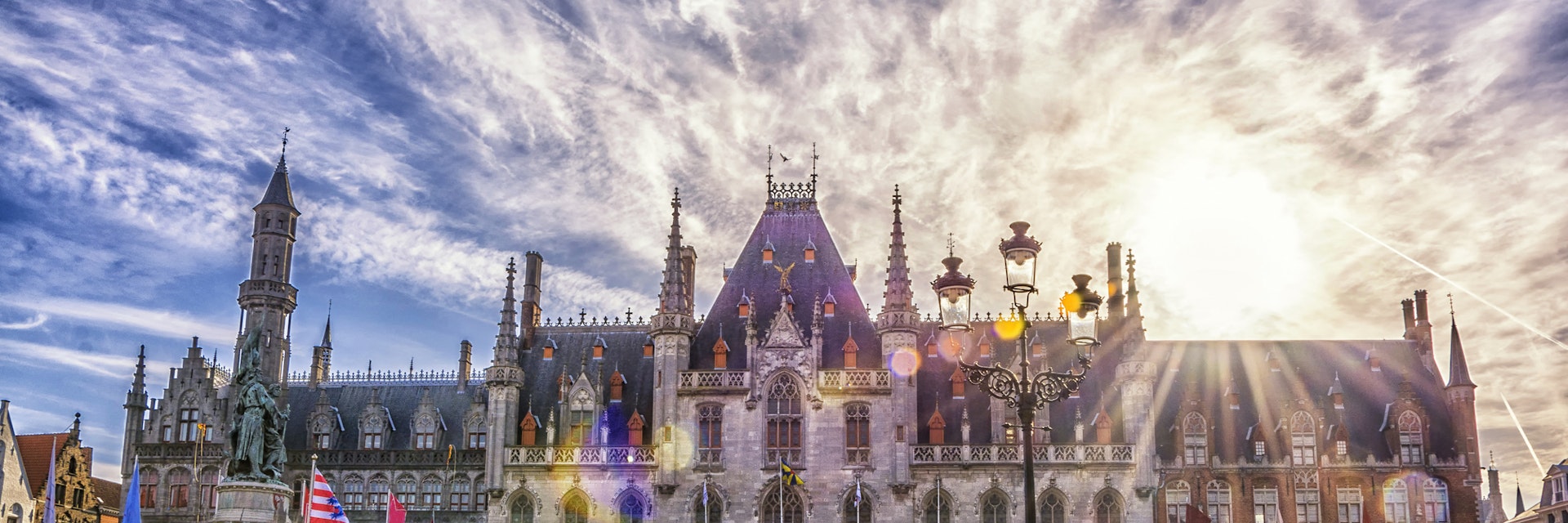
Shutterstock / MarinaDa
If you set out to design a fairy-tale medieval town, it would be hard to improve on central Bruges (Brugge in Dutch), one of Europe's best preserved cities. Picturesque cobbled lanes and dreamy canals link photogenic market squares lined with soaring towers, historical churches and lane after lane of old whitewashed almshouses.
Best Things to Do
Attractions, must-see attractions.

The heart of ancient Bruges, the old market square is lined with pavement cafes beneath step-gabled facades. The buildings aren't always quite as medieval…
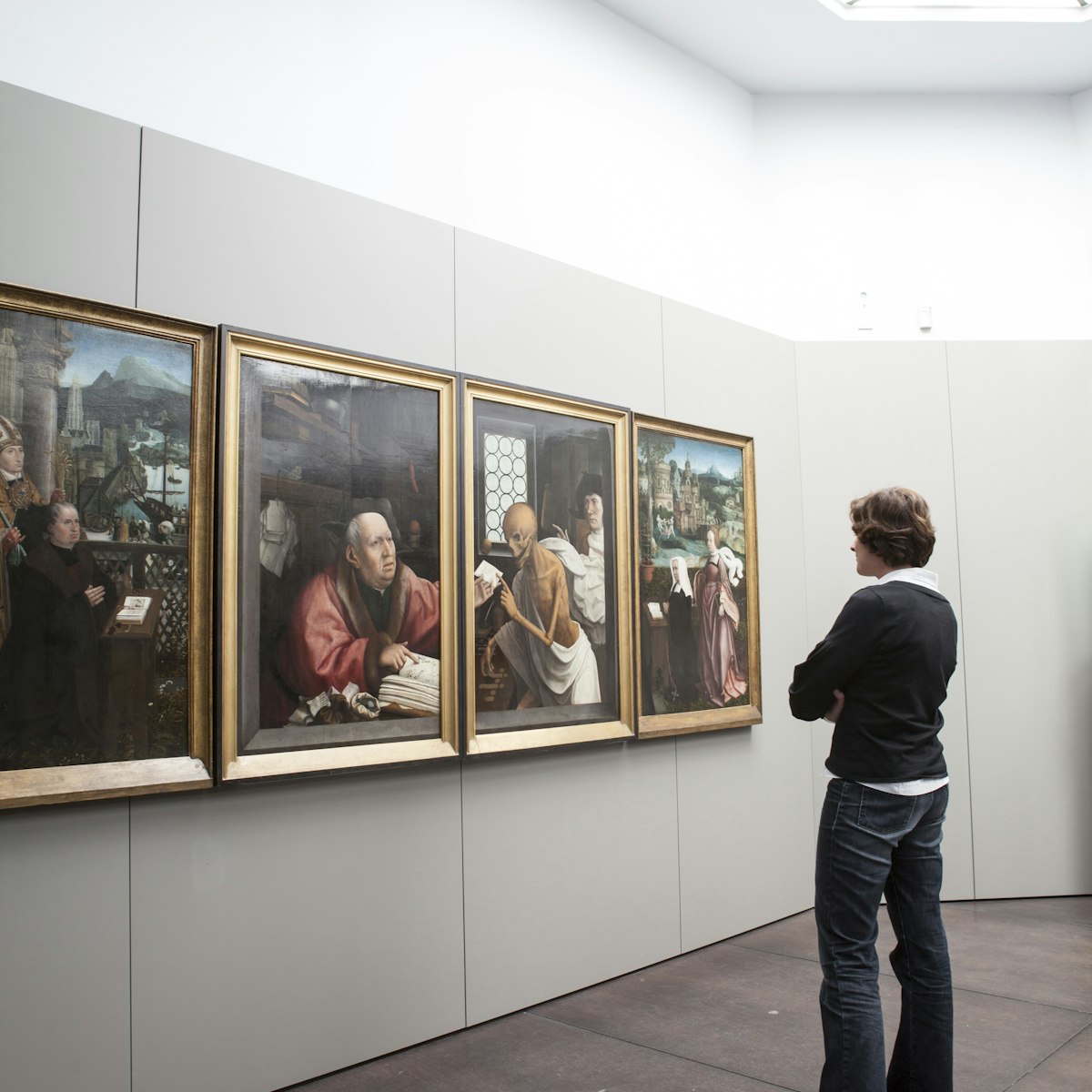
Groeningemuseum
Bruges’ most celebrated art gallery boasts an astonishingly rich collection that's strong in superb Flemish Primitive and Renaissance works, depicting the…
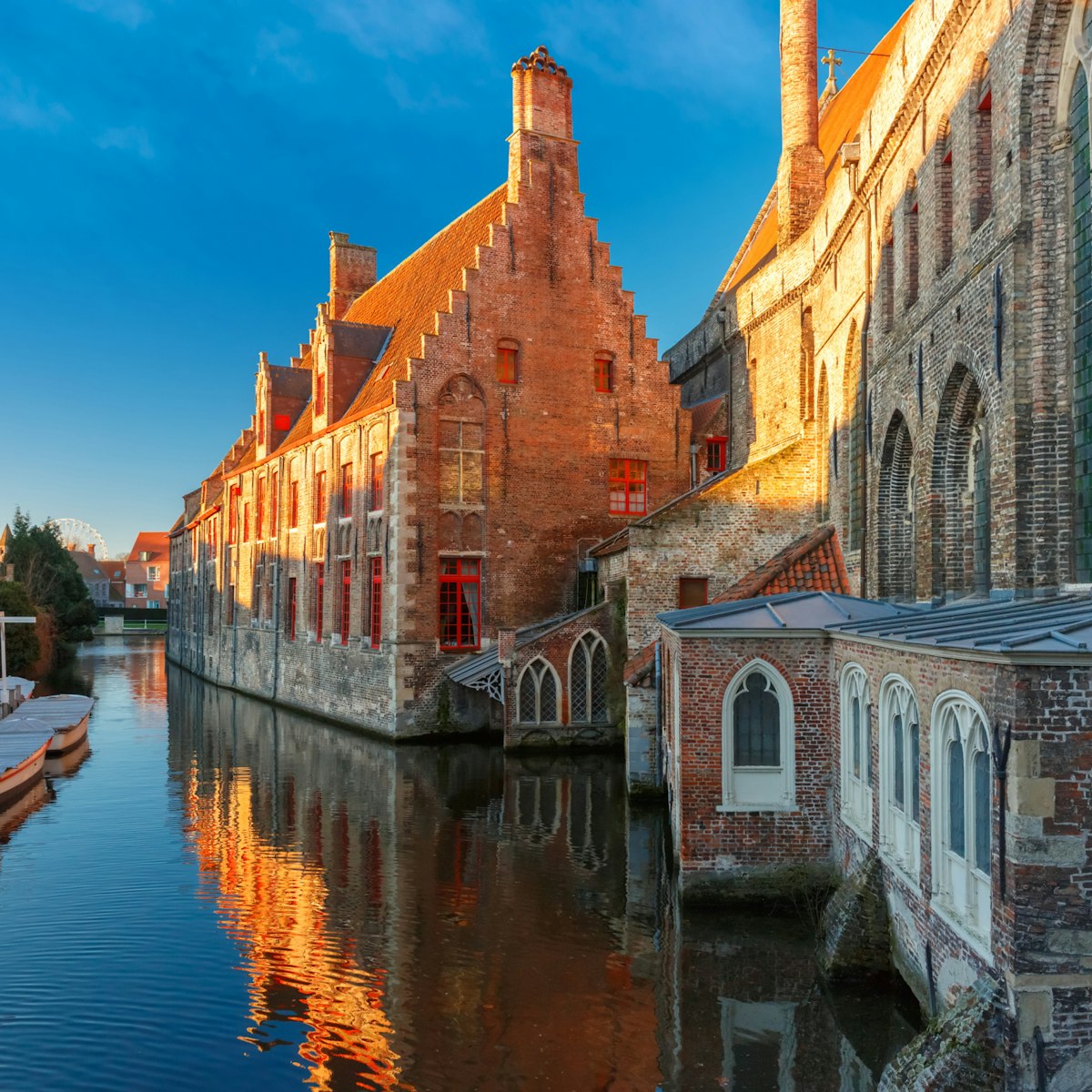
Museum Sint-Janshospitaal
In the restored chapel of a 12th-century hospital building with superb timber beamwork, this museum shows various torturous-looking medical implements,…

Towering 83m above the square like a gigantic medieval rocket is this fabulous 13th-century belfry. There’s relatively little to see inside, but it’s…

Just east of the Markt, the less theatrical but still enchanting Burg has been Bruges' administrative centre for centuries. It's in this area you'll find…

Kasteel van Loppem
Around 10km south of Bruges, Kasteel van Loppem is a mid-19th-century brick castle-mansion which had its moment of fame at the end of WWI when it was…

Bruges’ delightful begijnhof dates from the 13th century. Despite the hordes of summer tourists, remains a remarkably tranquil haven. Outside the 1776…

Basiliek van het Heilig Bloed
The western end of the stadhuis morphs into the Basiliek van het Heilig Bloed. The basilica takes its name from a phial supposedly containing a few drops…
Top picks from our travel experts
17 of the best experiences in bruges.

Try the fabulous Garre draught beer, which comes with a thick floral head in a glass that’s almost a brandy balloon; the pub will only serve you three of…

Onze-Lieve-Vrouwekerk
Dominating its surrounds, this 13th-century church was reopened in 2015 after extensive renovations. Its enormous 115m spire is unmissable throughout much…

St-Bonifaciusbrug
Stand atop the 20th-century stone Bonifacius bridge, itself amply photogenic, for lovely vistas of the canal and surrounds.
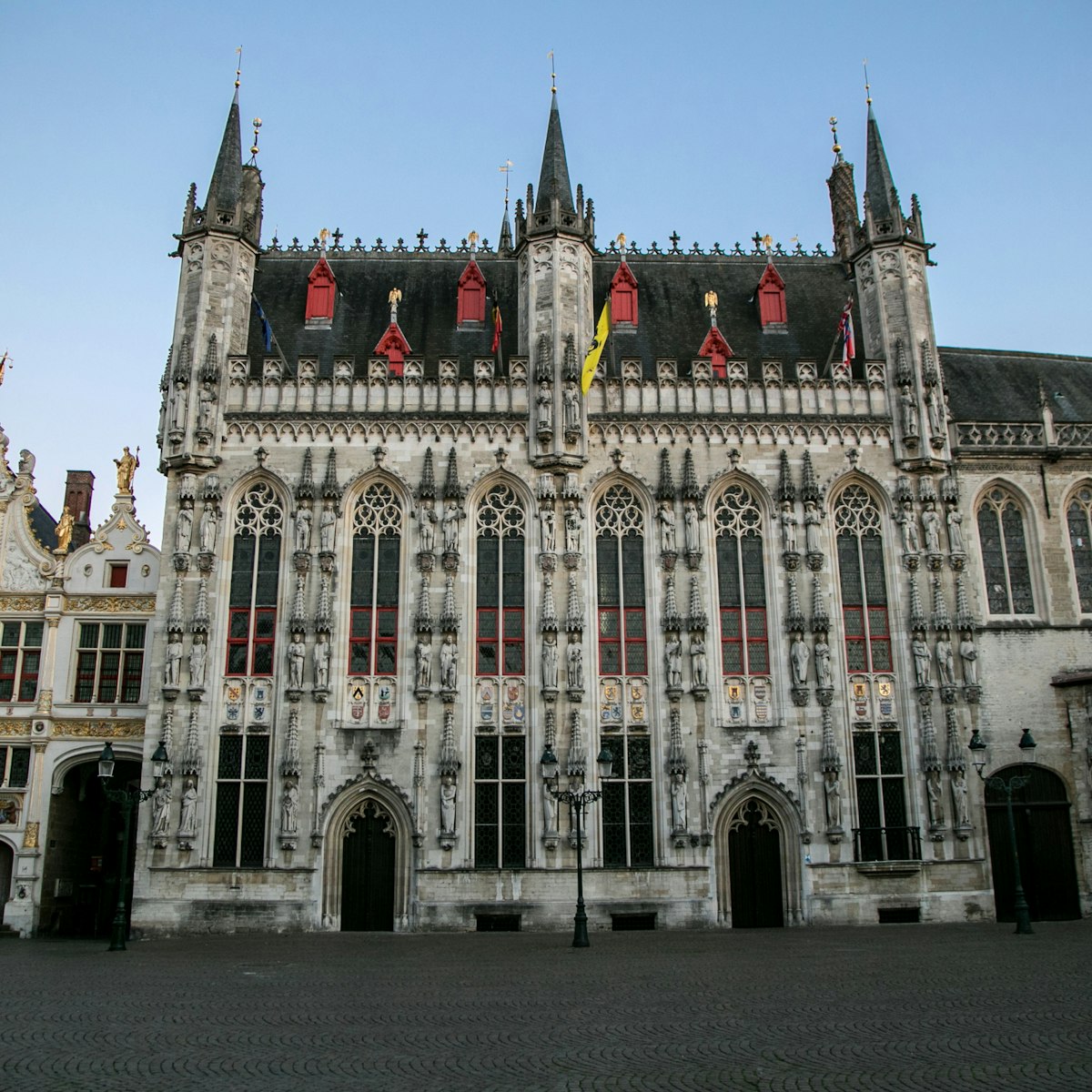
The beautiful 1420 stadhuis features a fanciful facade that’s second only to Leuven’s for exquisitely turreted Gothic excess. Inside, an audioguide…

Concertgebouw
Bruges’ stunning 21st-century concert hall is the work of architects Paul Robbrecht and Hilde Daem. It takes its design cues from the city’s three famous…

Het Zand Square
Under ongoing redevelopment since 2015, ’t Zand is Bruges' largest public square and a major transport hub, fringed with shops, hotels and restaurants…

Frietmuseum
Follows the history of the potato from ancient Inca grave sites to the Belgian fryer. The entry fee includes a discount token for the basement frituur …
Latest stories from Bruges

Dec 16, 2023 • 9 min read
Bruges is home to peaceful canals and amazing beers. But what should you do when you're not on a boat or in a bar? We've got you covered.
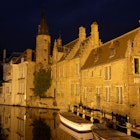
Jan 21, 2020 • 2 min read

Aug 15, 2019 • 6 min read

Jun 14, 2019 • 2 min read
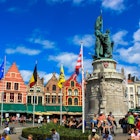
Nov 30, 2015 • 5 min read
in partnership with getyourguide
Book popular activities in Bruges
Purchase our award-winning guidebooks.
Get to the heart of Bruges with one of our in-depth, award-winning guidebooks, covering maps, itineraries, and expert guidance.

Begijnhof (Beguinage)

Canals of Bruges

Burg (Burg Square)

Concertgebouw Brugge (Concert Hall)

The Flemish primitives

Godshuizen (Almshouses)

Gruuthusemuseum (Gruuthuse Museum)

The Hanseatic Quarter

Markt (Market Square)

Minnewater (Lake of Love)

O.L.V.-kerk Museum (Museum of the Church of Our Lady)

Rozenhoedkaai (Rosary Quay)

Bruges Triennial 2024
From 13 April through 1 September 2024
Contemporary art and architecture in the historic city centre of Bruges, a UNESCO World Heritage Site.

Let’s explore Bruges
Bruges travel guide
For me, visiting Bruges is like stepping into a real-life fairytale. I love the magic that oozes from every corner of the city and the atmosphere is utterly enchanting.
In my Bruges travel guide, I share my top recommendations for when to visit, how to get around and places to see. Plus my favourite spots for a good beer and a bite to eat!
About the author
Jessie Moore is a luxury travel expert with years of experience travelling the world to find the best destinations, hotels and adventures.
A pocket-sized European city with a big heart, the quaint city of Bruges is a real-life fairytale destination. As one of the most well-preserved medieval cities in Western Europe, visiting Bruges is a chance to travel back in time. In fact, the historic centre of Bruges is so historically significant that it has been appointed a UNESCO World Heritage Site.
Full of quaint charm and a fairytale aesthetic, Bruges is an intimate city that doesn’t try to do too much. Known affectionately as the Venice of the North, its 80 bridges frame the meandering canals which intertwine with the winding cobbled streets. Discover pockets of green throughout the city, from small hidden gardens to the larger grassy expanse which surrounds this Belgian city.
The beating heart of Bruges lies in the Markt Square, flanked by gorgeous Flemish architecture and overlooked by the towering Belfry. Architecture and aesthetics aside, the food and drink specialities of Bruges include fries, waffles, chocolate and beer – need I say more?
Whether you’re visiting for the architecture and ambience, the canals and culture, or the waffles and windmills, unearth the beguiling city in my Bruges travel guide.
Want to save up to 25% on hotels?
Subscribe to the Pocket Wanderings newsletter and get immediate access to my guide on how to save money on flights and hotels. Our weekly emails are filled with adventure inspiration, insider travel tips and exclusive discounts.
How to get to Bruges
If travelling from the UK, the easiest way to get to Bruges is by Eurostar from London to Brussels. Alternatively, travelling by plane is the most convenient option for those travelling from further afield.
By plane: The closest airport to Bruges is Brussels Airport, approximately 110km from Bruges. Direct flights are available from London, US, Canada, and more.
From the airport, you can get the train to Bruges, which takes around an hour and a half. Or a taxi should take around 75 minutes, although this is likely to be more expensive.
By train: If you’re travelling from London in the UK, getting the train is by far the easiest option. Catch the two hour Eurostar train from London St Pancras to Brussels Midi. Then it’s a direct train from Brussels to Bruges, which takes around one hour.
Brussels Midi station is well-connected to a number of other European countries, including France, Netherlands, Germany and Luxembourg.
By car: If you’re travelling from a nearby neighbouring European country then driving to Bruges is another option. If coming from the UK, you can take the Eurotunnel over to France and then drive into Belgium. Note that parking is limited in Bruges and you certainly don’t need a car to get around, as the city is small enough to get everywhere on foot.
HOTEL GUIDE
15 best luxury hotels in Bruges
Discover my pick of the best luxury hotels in Bruges, Belgium – whether you’re after canal views, a sumptuous spa, fine dining or a stylish bar.
20 Michelin-star restaurants in Bruges
For an unforgettable gastronomic experience, here is my handpicked selection of the best Michelin restaurants in Bruges.
How to get around Bruges
Bruges is a wonderfully compact city. I think that being so small is part of its charming, fairytale appeal. Plus, it also makes Bruges a great option for solo travellers, as there’s no need to navigate any complex public transport systems.
By foot: In my opinion, the only way to explore Bruges is by wandering its unspoiled streets on foot. You can reach even the furthest corners of the city relatively easily by walking. If you struggle with mobility then it’s worth noting that there are cobbles everywhere. It’s all part of the city’s quaint charm, but can make accessibility difficult.
By bus: The bus offers a convenient way of getting from the railway station to the centre of Bruges. They leave every 5-10 minutes and take passengers to the Market Square. There’s no need for a bus once you’re in the city centre, but it can be handy for station transfers.
By horse & carriage: Live out the ultimate fairytale fantasy and make a one-off trip by horse and carriage. The horses are well looked after so there’s no need to sacrifice any ethics for a romantic horse & carriage ride through the city. It’s not the cheapest way to see the city, but it’s definitely the most memorable.
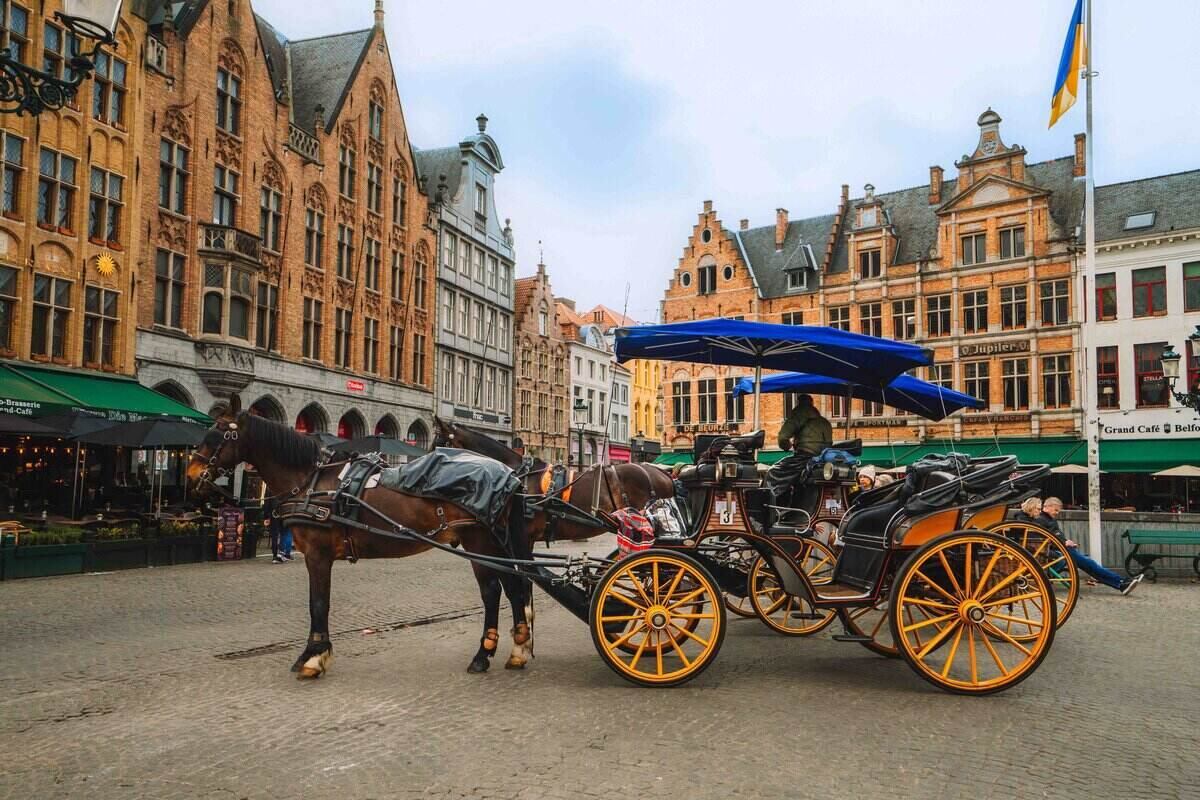
By bike: Cycling is a fantastic way to explore the outskirts of the city, where you’ll find quaint villages and rolling green countryside. You can get around the city centre by bike – and many of the locals do just that – although I think the main hub of Bruges is still best explored on foot so you can take in all the sights.
By taxi: The only time you’ll really need a taxi in Bruges is to get from the station to the centre. If you don’t fancy the bus, there are usually plenty of taxis available at the station. It’s a relatively short journey so prices are generally quite reasonable.
By car: You simply don’t need a car to explore Bruges. If you’re doing a road trip then it’s no problem to arrive by car. But once you’ve parked up, you’re not going to need it until the end of your Bruges excursion – unless you’re doing a day trip of course!
Best time to visit Bruges
Note that most attractions are closed on Mondays and that a lot of restaurants don’t open until the latter part of the week.
There are still plenty of options for dining out, but you’ll need to book in advance to guarantee a spot. This does mean it’s generally a little quieter from Monday to Wednesday.
Personally, I think it’s worth the more limited dining options for a more peaceful experience of the city.
One of the key shoulder seasons, I think spring is a wonderful time to visit Bruges. The city becomes adorned with colourful flowers in every nook and cranny.
European cities don’t get much prettier than Bruges in spring. If you’re visiting in spring, be sure to stop by Beguinage, as it will be covered in a blanket of white and yellow daffodils. Aim for late spring to benefit from fairer weather.
As you’d expect, summer is the most popular time to visit Bruges. The weather is at its best, although still mild and not scorching. Temperatures tend to hover around 19-20 degrees Celsius and rain is less likely – although still pack an umbrella!
The warmer weather does mean a lot of tourists. As Bruges is such a small city, the high volume of tourists is, unfortunately, very noticeable.
Another shoulder season, autumn is a great time to visit if you’d prefer to avoid the droves of tourists that the summer months attract. As the leaves turn golden brown, the city takes on a cosy charm.
Be sure to visit parks like Minnewater to get the full autumnal experience. If you’re visiting in late autumn, be aware that the weather will be chilly and rain quite likely. So pack accordingly!
The main reason that people visit Bruges in winter is due to the delightful Christmas markets. Wander the pretty wooden chalets, go for a skate on the ice rink, and indulge in traditional street food and drink.
As you can imagine, the weather will be cold. If you’re lucky, you may get to see Bruges covered in a glistening blanket of snow for the ultimate postcard-perfect visit.
DESTINATION GUIDE
20 amazing things to do in Bruges
From museums and markets to waffles and walks, here is my guide to the very best things to do in Bruges, the ultimate fairytale town in Belgium.
Brussels or Bruges: which to visit?
Trying to decide whether to visit Brussels or Bruges? I share the pros and cons of both beautiful Belgian cities to help you decide which to visit.
Browse and book the best activities and attractions in Bruges:
Frequently asked questions, how long to spend in bruges.
I’d say that three nights and two full days is a good amount of time to spend in Bruges. Given its small size, you may run out of things to do if you spend longer there. An alternative option is to add on another night and spend your third day in pretty Ghent, which is just a half hour train ride away.
Is Bruges overwhelmed with tourists?
Due to its small size, the city can feel overwhelmed with tourists during peak times. My recommendation? Do not miss out on an early morning stroll around the city, before the crowds descend. It’s the best time to see the unspoiled streets and remarkable beauty of Bruges in all its glory.
Is Bruges a good destination for solo travellers?
Bruges is an excellent destination for solo travellers. In fact, I often recommend it as a great starting point for anyone new to the world of solo travel. You don’t need to navigate any complex public transport systems, English is widely spoken, and it’s a very safe city with low crime rates.
Is Bruges expensive?
Bruges is a relatively expensive city, especially when it comes to food and drink . Just be sure to eat away from the tourist areas (definitely don’t eat on the Market Square) and the prices will be less inflated.
How many Michelin star restaurants in Bruges?
There are currently two Michelin star restaurants in Bruges: Zet’Joe by Geert Van Hecke and Sans Cravate. Bruges is also home to two Bib Gourmand restaurants and 15 other Michelin recommended eateries.
There are some exceptional restaurants in Bruges by exciting, innovative chefs. If you love a spot of fine dining, you’ll find plenty of options in Bruges. Just make sure that you book ahead of time.
Are there Christmas Markets in Bruges?
The main Christmas market takes place in the central Markt, where there is also a tempting ice rink. A second Christmas market takes place in the Simon Stevinplein square.
Wander the cosy wooden chalets, indulge in delicious home-made treats, and do a spot of Christmas shopping. It’s guaranteed to be an unbeatable festive atmosphere.
What are the food and drink specialities in Bruges?
Belgium is famous for waffles, chocolate, beer and fries – all the healthy treats in life! It follows that all of Belgium’s specialities can be found and sampled in Bruges.
Bruges highlights
Historic centre.
The historic centre of Bruges is one of the city’s main appeals. In fact, it was designated a UNESCO World Heritage Site in 2000, owing to its layout being the same as it was in the Middle Ages.
The mediaeval centre is a hub of gothic architecture and quaint streets, all with a lively city feel.
Be sure to wander the historic centre on foot, along hidden streets and romantic bridges. The canals wend their way around the cobbled streets which are lined with recognisable Flanders architecture.
Go shopping, indulge in a traditional Belgian waffle, or pause for a moment in one of the many cafes or bistros.
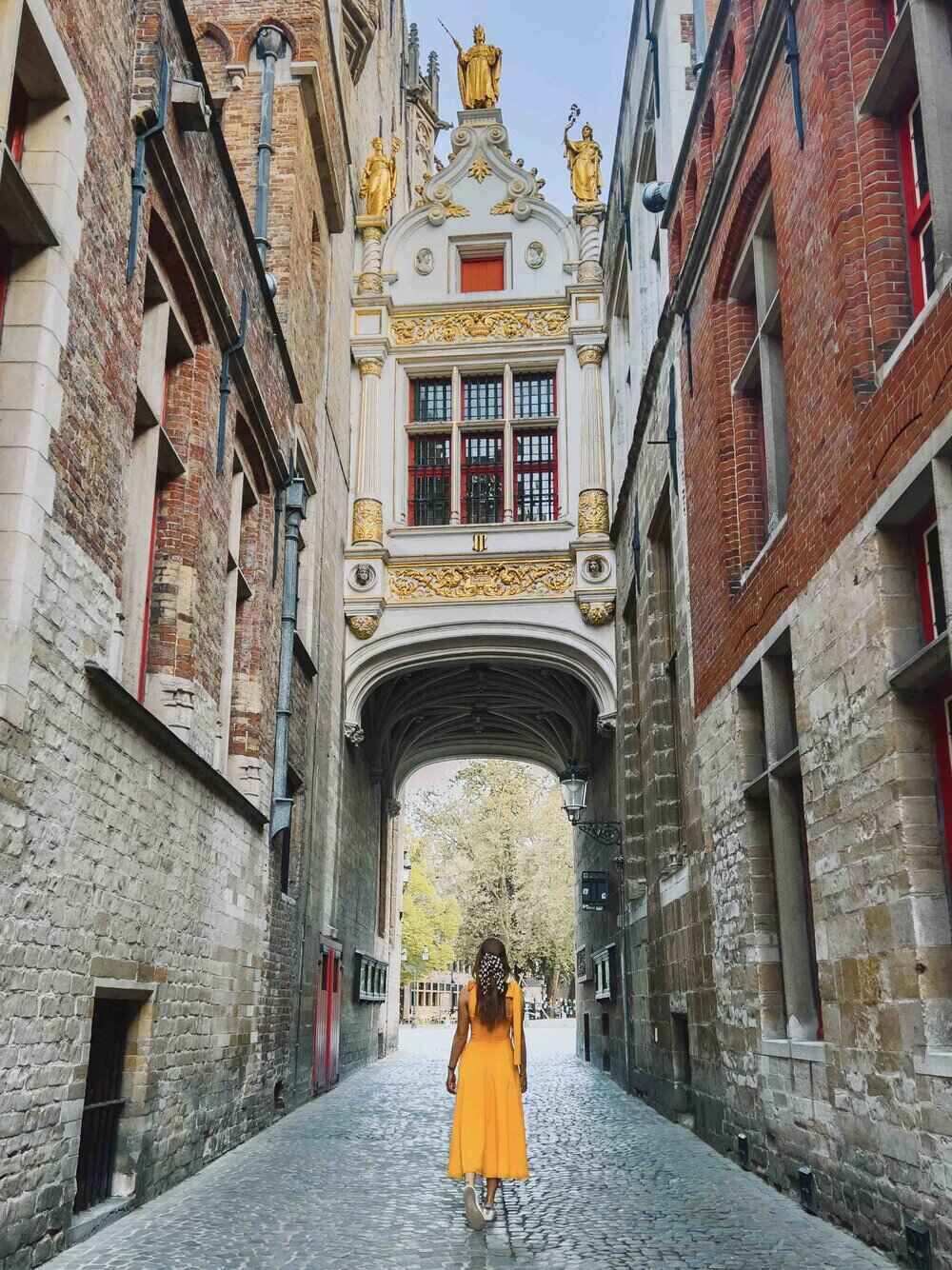
Explore by canal
A visit to Bruges would not be complete with a journey along the canals. Gain a different perspective on the historic centre by seeing it from the calming waters.
There are plenty of canal boat tours available throughout Bruges, with insightful commentary that brings the city to life.
Try to go relatively early, when they open at around 10am to avoid long queues. I recommend picking one up from the jetty at Rozenhoedkaai, as you can enjoy an alfresco drink in the area afterwards.
Seeking out the hidden pockets of Bruges via the waterways is an absolute must.

Bruges breweries
It’s no secret that Belgium is famous for its beer. What better excuse to get seven pints deep, all in the name of ‘soaking up the culture’!
Bruges has three working breweries: De Halve Maan, Bourgogne des Flandres, and Fort Lapin. For a popular guided tour, head to De Halve Maan to learn more about the process of creating their award-winning beers.
A tour would not be complete without a tasting, so make sure you leave time – and room – for this. If you still haven’t had your fill of beer, you’ll find beer infused dishes in many of the restaurants.
Sound like a dream come true? Book a table at Cambrinus, which offers entire menus prepared with beer (and the longest beer menu you’ll ever see).
Don’t have time to finish reading? Save on Pinterest for later:
Pocket Wanderings is a luxury travel and lifestyle brand run by London-based content creator, Jessie Moore. Here you’ll find a community of fellow wanderlusters and adventurers.
Quick Links
About Contact Privacy Policy
Want up to 25% off hotels?
Subscribe to my newsletter and get immediate access to my guide on how to save money on flights and hotels. Our weekly emails are filled with adventure inspiration, insider travel tips and exclusive discounts.
Bruges Travel Guide

Courtesy of Barry O'carroll | EyeEm

Why Go To Bruges
Swans swim its canals; medieval buildings shadow its cobblestones; willow trees weep over its lake; rich chocolates peer from behind its windows; pints of Belgian blondes sit on its cafe tables; and carillon chimes fill its air with music: This is Bruges (or Brugge in Dutch). This idyllic city in northern Belgium is more touristy and yet more quaint than the capital city of Brussels . Plan a trip to Bruges for a taste of medieval Europe in the 21st century, for a friendly small-town feel with world-class charms (the Historic Centre of Brugge , to name one) and, of course, for the beer, fries and chocolate. Whatever your reason for coming to Bruges, you'll be charmed.
Find Flight and Hotel Deals
Navigate forward to interact with the calendar and select a date. Press the question mark key to get the keyboard shortcuts for changing dates.
Navigate backward to interact with the calendar and select a date. Press the question mark key to get the keyboard shortcuts for changing dates.
Best of Bruges
Best hotels in bruges.
- # 1 in Hotel Dukes' Palace Bruges
- # 2 in The Pand Hotel
- # 3 in Hotel de Orangerie

Best Things to Do in Bruges
- # 1 in Rozenhoedkaai
- # 2 in Historic Centre of Brugge
- # 3 in Markt
Popular Tours

Round-Trip Shuttle Service from Zeebrugge to Bruges
(679 reviews)
from $ 27.44

Deluxe Bruges Shore Excursion from Zeebrugge Cruise Port
from $ 72.45

Guided boat trip and walk
(224 reviews)
from $ 48.30
Bruges Travel Tips
Best months to visit.
The best time to visit Bruges is from June to August, when the weather is mild, and the trees are green. Still, the weather year-round is characterized as chilly and damp – summer temps usually don't climb higher than the 70s. Spring and fall are considered shoulder seasons that see fewer tourists and cooler temperatures, with average highs hovering in the 50s. In the winter, temperatures drop but don't reach freezing, and the city offers a variety of holiday events, including its famous Christmas markets. Fall and winter also bring the greatest chance of rain, so keep an umbrella at the ready.
Weather in Bruges
Data sourced from the National Climatic Data Center
What You Need to Know
Hop on a boat tour Canal tours are a great way to get an overview of Bruges. You'll easily find boat operators departing from jetties around the city offering 30- to 45-minute tours. The famous Rozenhoedkaai is a popular spot to hop on a tour.
Indulge in some chocolate Belgium is known for the sweet stuff, so be sure to pause for a chocolate break at a well-known chocolate maker like The Chocolate Line or Sukerbuyc .
Consider a daytrip to Brussels Brussels is an hour's train ride southeast of Bruges, making it an ideal daytrip.
How to Save Money in Bruges
Get a Discover Bruges Card If you stay at a Hotels Regio Brugge member hotel , you have access to a free card , which offers discounts on area attractions and shops.
Get a Musea Brugge Card This card grants you access to a variety of museums, including the Groeningemuseum , over a period of three days for 28 euros (or about $31).
Rent a bike Bruges caters to cyclists. You'll find that bike lanes dot the city and even head into nearby coastal towns.
Culture & Customs
Once a hub for artists of the Flemish Primitive style of painting, art is front and center in Bruges. There are numerous museums with artwork, as well as churches, convents and even a medieval hospital that each boast their own collection of impressive works.
Make sure to bring some euros with you, which is the currency of Belgium. When eating out, it's unlikely you'll need to tip, as it's included as part of the restaurant bill, and restaurant workers earn better compensation than those in the U.S. It's OK to leave a few euros for excellent service, but generally not more than 10% of your bill.
In Bruges, you'll find the locals speak Flemish natively, but many also speak English well.
What to Eat
Residents of Bruges love their beer, Belgian fries and chocolate – Bruges even has its own official city chocolate: the Bruges swan, or Brugsch Swaentje . Bruges offers plentiful chocolate shops, pubs and a handful of breweries, as well as attractions that tell the story of each of the country's celebrated foods, including the Bruges Beer Experience , Choco-Story and Frietmuseum. But the dining scene in Bruges is much vaster than these three staples.
Gruuthuse Hof , which has been open since the mid-1700s, is popular with tourists and serves traditional Belgian dishes like beef stew and duck, and waffles for dessert. For a casual meal, the De Halve Maan Brewery also has a restaurant on the premises with a limited menu if you want a bite with your beer.
If you're celebrating a special occasion or just in the mood to splurge, consider Le Mystique , which serves a blend of French and Flemish cuisine. The restaurant is historic as well, dating to 1869. Dishes with a Flemish touch include beef with braised chicory and seafood, including sea bass and oysters. Flemish cuisine is known for its fries and waffles, as well as beef stew, Belgian endive, and of course, Brussels sprouts. A meal at Bistro Refter is equally indulgent as it's headed by Michelin-starred chef Geert Van Hecke, who offers a contemporary take on Belgian cuisine with dishes like roasted cockerel, fish, steak and, of course, fries.
When it comes to safety, Bruges generally has a low crime rate, is clean and safe for traveling alone, though as in any tourist destination, be aware of pickpocketing and traveling by yourself at night. The State Department does encourage citizens to exercise extreme caution when visiting Belgium due to terrorist groups continuing to plot possible attacks there.
Getting Around Bruges
The best way to get around Bruges is on foot. The city is small – in fact, you can walk from one end to the other in about 30 minutes. Biking is the second-best way to get around. There's also a bus system, but it's most useful in getting from the train station to the city center rather than for exploring the city. Cars are not recommended, since Bruges' streets are narrow and webbed with canals. You can also hire taxis at several taxi stands. The closest major airport is Brussels Airport (BRU), so most visitors take the train into Bruges. The ride from the airport to Bruges is about 90 minutes; tickets start at 21 euros (or around $23). According to the tourism office, taxis from the airport to Bruges cost a flat rate of 200 euros (or about $222). The train station is located just southeast of the city center, about a 20-minute walk from the historic city center or a five-minute bus ride.
Entry & Exit Requirements
A valid passport is required for citizens of the United States to travel to Belgium. U.S. citizens can stay for up to 90 days without obtaining a visa. At customs, you'll have to present a return airline ticket, as well as a passport that is valid for at least three months after the date of your departure. If you're planning to stay in Belgium for more than 90 days, you'll have to obtain the proper visa before leaving the U.S. Keep in mind: The U.S. Department of State issued an advisory for travel in Belgium in December 2018 due to terrorism, warning travelers of potential terror attacks. The State Department recommends registering for the Smart Traveler Enrollment Program ( STEP ) so that you'll receive alerts and be easier to locate in the event of an emergency. For more information, visit the State Department's website .
Considered one of the most photographed areas of Bruges, Rozenhoedkaai , or Quay of the Rosary, is a picturesque spot where the Dijver and Groenerei canals meet.
Explore More of Bruges

Things To Do
Best hotels.

You might also like

# 3 in Best Winter Vacations in Europe

# 12 in Best Cheap European Honeymoon Destinations

# 2 in Best Day Trips from Florence
If you make a purchase from our site, we may earn a commission. This does not affect the quality or independence of our editorial content.
Recommended
The 28 Best Water Parks in the U.S. for 2024
Holly Johnson|Timothy J. Forster May 8, 2024

The 18 Best Napa Valley Wineries to Visit in 2024
Lyn Mettler|Sharael Kolberg April 23, 2024

The 25 Best Beaches on the East Coast for 2024
Timothy J. Forster|Sharael Kolberg April 19, 2024

The 50 Best Hotels in the USA 2024
Christina Maggitas February 6, 2024

The 32 Most Famous Landmarks in the World
Gwen Pratesi|Timothy J. Forster February 1, 2024

9 Top All-Inclusive Resorts in Florida for 2024
Gwen Pratesi|Amanda Norcross January 5, 2024

24 Top All-Inclusive Resorts in the U.S. for 2024
Erin Evans January 4, 2024

26 Top Adults-Only All-Inclusive Resorts for 2024
Zach Watson December 28, 2023

Solo Vacations: The 36 Best Places to Travel Alone in 2024
Lyn Mettler|Erin Vasta December 22, 2023

26 Cheap Beach Vacations for Travelers on a Budget
Kyle McCarthy|Sharael Kolberg December 4, 2023


A Complete Guide to Bruges, Belgium
Distinguished by its canals and cobblestone streets, Bruges is living evidence that fairytales exist. Old world charm aplenty, there’s no question that this is the most beautiful town in Belgium. If you plan to make the trek to West Flanders, here’s everything you need to know to make the most of your time in Bruges in our travel guide to Bruges.
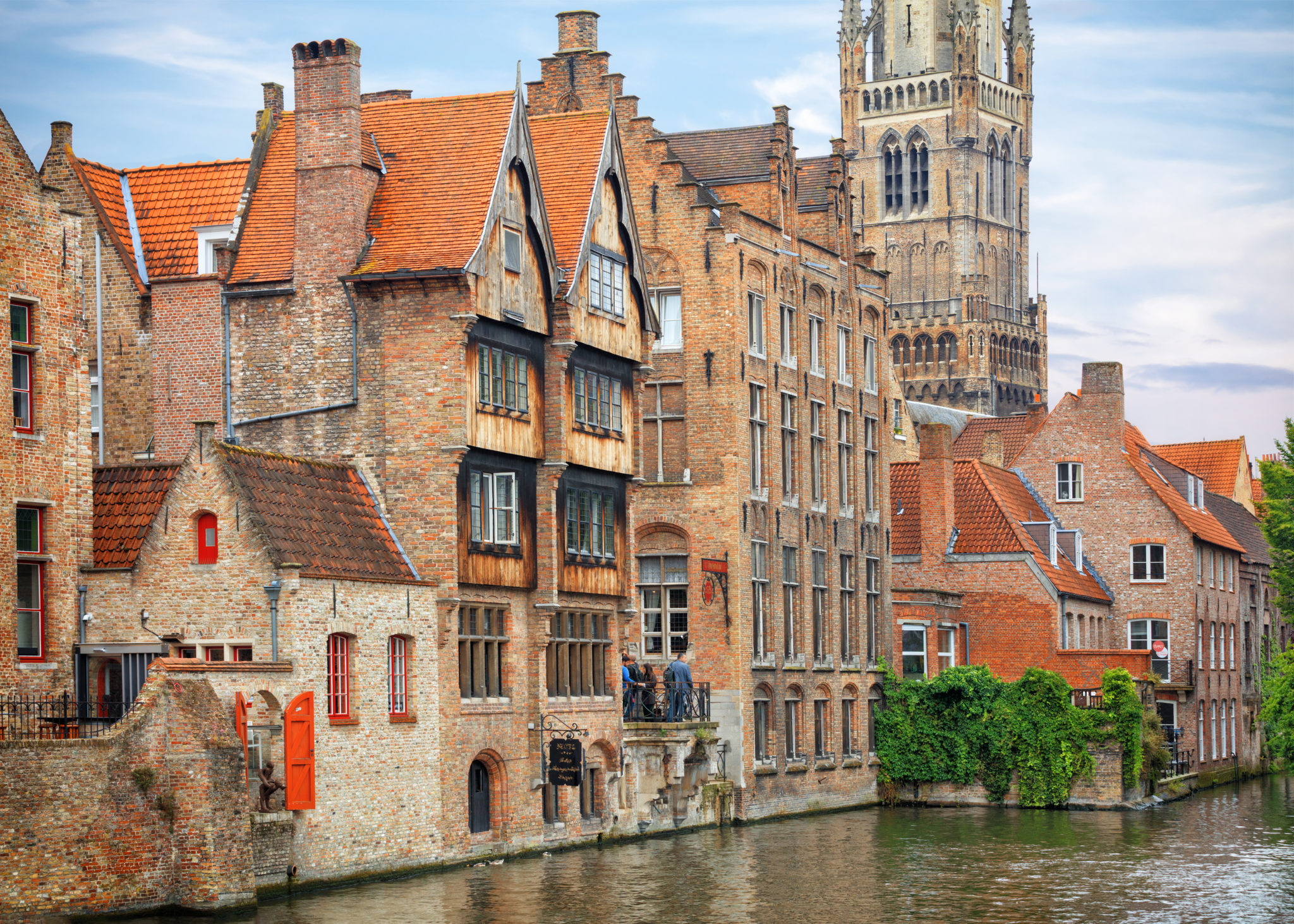
Your Guide to Bruges
Arriving in bruges.
Chances are you will arrive in Bruges at the main train station, a short 10-minute stroll from the centre of town. Pre-load your google maps or follow the signs (and crowds) toward the centre of town. This city is best explored on foot or by bicycle, so getting lost is half of the fun. A city as picturesque as this, there really is no harm in going map-less and seeing where you wind up. If it helps, the Bellfry tower is a great point of reference to look up toward and find your way back to the centre of town.
When to Visit
Bruges is one of the most visited cities in Belgium. The other most visited cities are Brussels, Antwerp and Ghent. However, if I dare say it, Bruges is the most memorable. If you don’t like crowds, opt for an Autumn or Winter visit. If you visit in summer then you can expect to experience some crowds in Bruges. Spring is another popular season however not as chaotic summer, plus you’ll have the added aesthetic of fresh blooms. There really is no bad time to visit Bruges, however, each season has its pros and cons.
How long to stay?
This is a debatable question that warrants a few different answers. You can easily see Bruges in one day. That is more than enough time to see all the highlights, enjoy Flanders culture and experience the city. If you prefer to travel at a slower pace, I would recommend two or three nights in Bruges. This is the kind of city you can really slow down time.
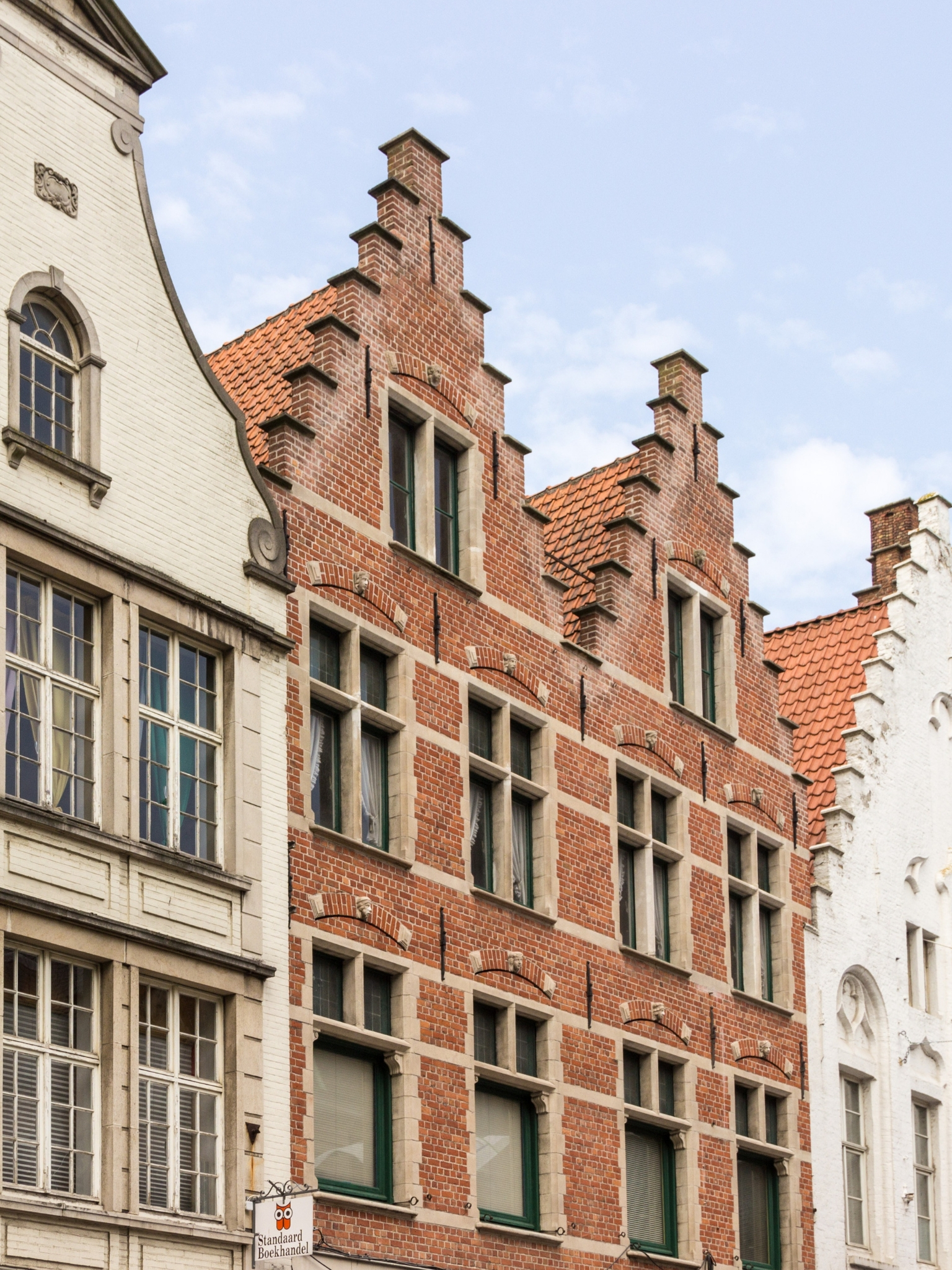
What to See in Bruges: The Highlights
Groenerei canal.
As a waterborne city, the canals of Bruges form a network linking the capital of West Flanders to the North Sea. The canals thus form a core of Bruges’ identity and as you wander around the winding waterways, you can’t miss the Groenerei (Green Canal), the most romantic snapshot of Bruges’ canals. The best photo opportunity is from Peerdebrug (The Horse Bridge) on Peerdenstraat.
Bruges’ iconic Gothic square sits at the heart of the city and is a perfect example of quintessential Gothic architecture and Flanders culture + design. The Stadhuis (Town Hall) is a must see with its original 1376 design in tact. Take a tour inside to spot the original wooden ceiling on the first floor.
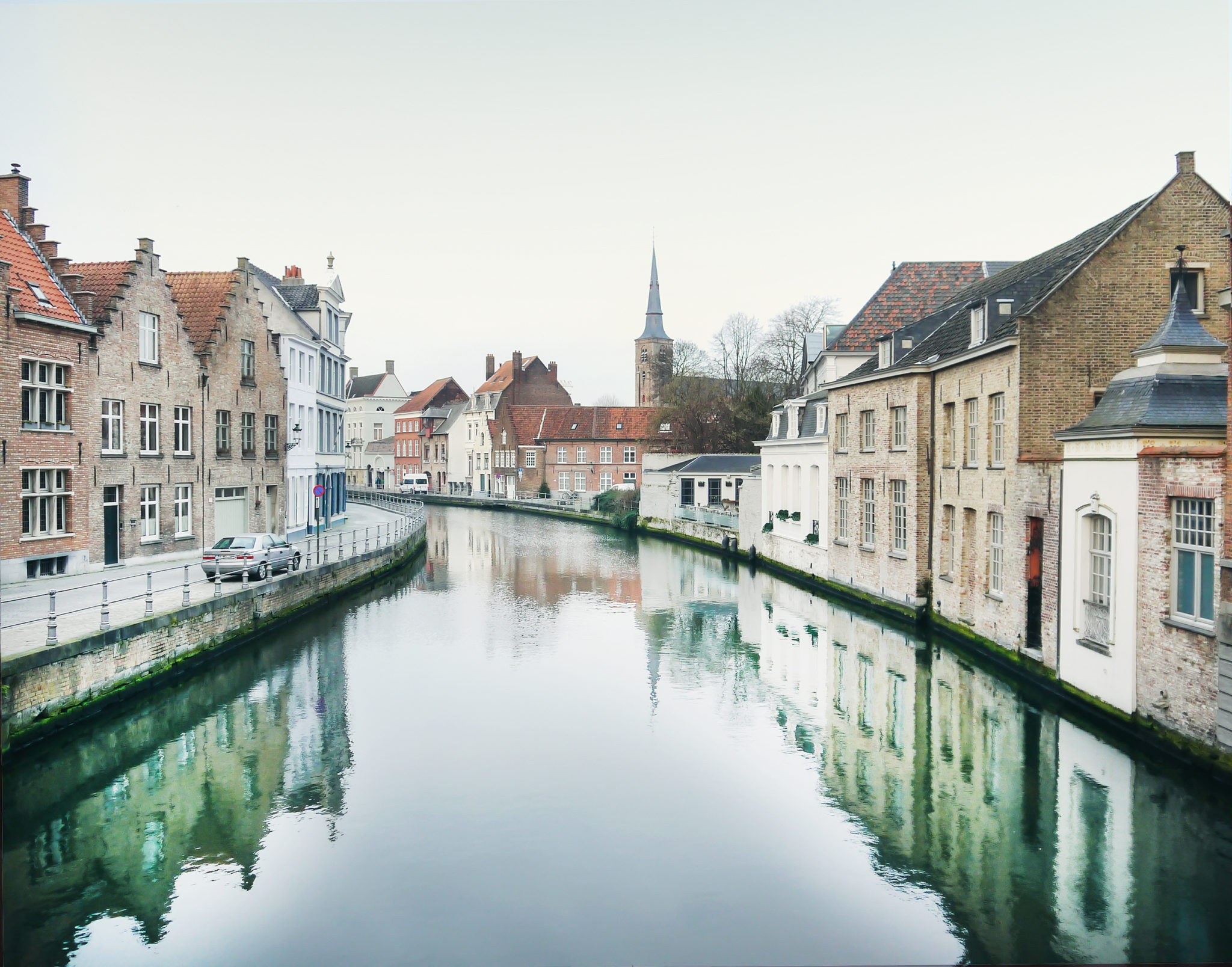
Minnewater Park
Also known as the Park of Love, this is no destination for the recently broken up with or solo traveller who would prefer not to be surrounded by a stream of couples wandering around the waterways. Should you not be one of the aforementioned, however, this is one of the most romantic locations in all of Bruges.
Rozenhoedkaai
As one of the most stunning postcard-worthy photo spots in all of Bruges, you cannot miss the opportunity to visit Rozenhoedkaai, particularly in the evening when the city lights up.
Walpein Square
This quaint and charming little square is filled with al fresco cafes and one of the most beautiful spots in town that is somehow not flooded with tourists.
Bonifacius Bridge
There are many bridges in Bruges but if we had to pick just one you cannot miss, Bonifacious would be it. The addition of the Church of Our Lady in the background makes this another quintessential photo opportunity not to be missed.
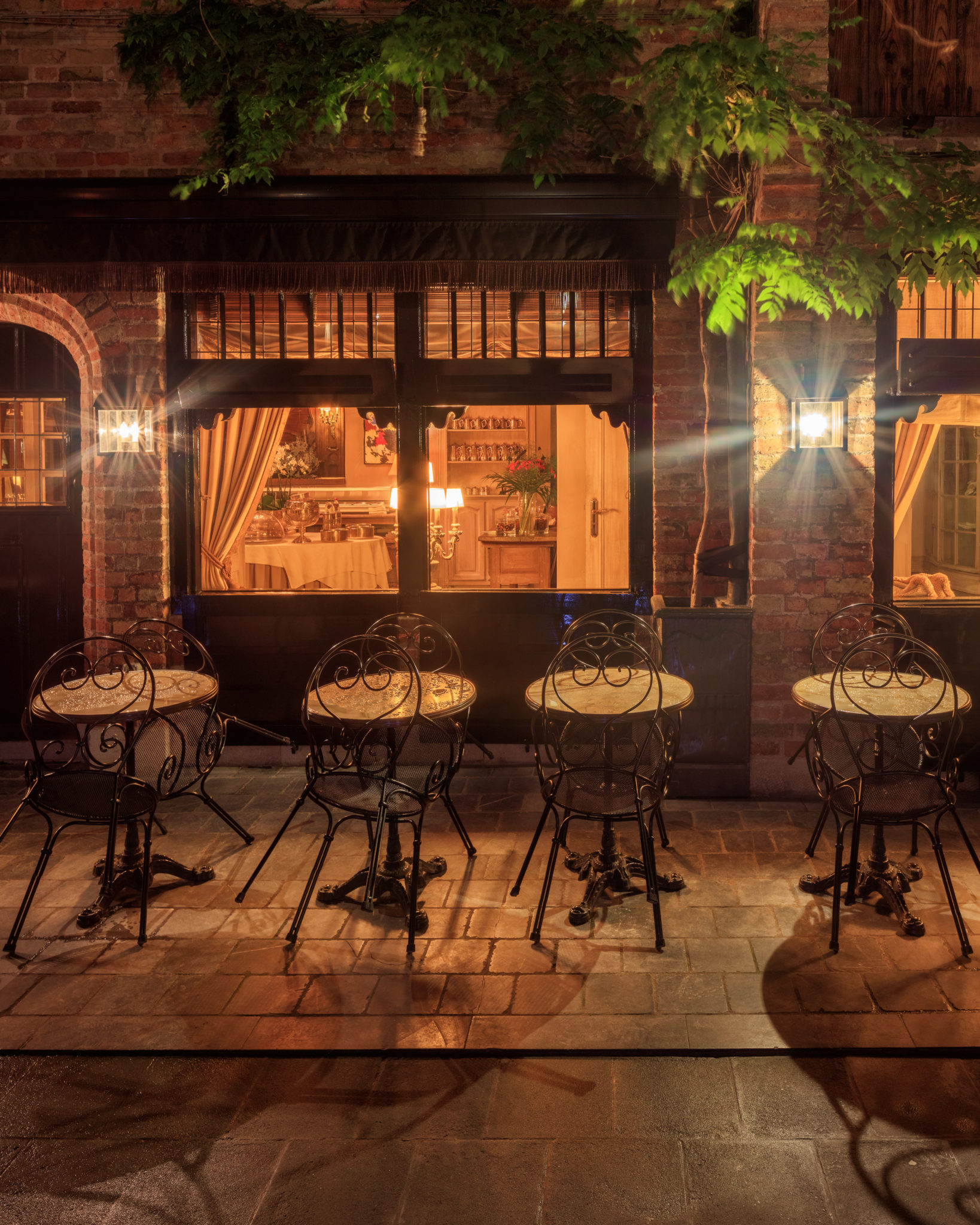
Where to Eat and Drink in Bruges
If you’re staying in town for a couple of days, prepared to be spoiled for choice! Despite the old world charm of Bruges, the restaurant and dining scene is years ahead of its’ time. Here are our top picks:
The Gulliver Tree
This casual coffee shop will quickly become a pit stop on your adventures around town – particularly if you’re fond of homemade baked goods, soups and a cup of tea in the afternoon.
Cordoeaniersstraat 4, Bruges 8000, Belgium
The Olive Tree Brugge
If you’re looking for a mediterranean touch, then look no further than this Greek restaurant. It is one of the most popular spots in town but the meals are huge and the atmosphere hits the spot.
Wollestraat 3, 8000 Brugge, Belgium
Réliva
This is our top pick for vegetarians and vegans as the options are plentiful, the food is incredible and full of unexpected flavour combinations.
Goezeputstraat 6, 8000 Brugge, Belgium
De Bron Vegetarian
This small vegetarian restaurant is open for lunch only, but is a great budget-friendly option for soup and a main meal (the offering changes daily). Note: open only on weekdays, 12pm-2pm.
Katelijnestraat 82, 8000 Brugge, Belgium
One of the best options in town for vegetarians and vegans. De Plaats serve up really fresh, wholesome food and the service is very friendly, making it a great option for a casual lunch or dinner. Note: they close between the end of lunch service and beginning of dinner service, so be sure to check hours before disappointment!
Wapenmakersstraat 5, 8000 Brugge, Belgium
‘t Zwart Huis
Dark and grungy bistro that might just become your favourite place in town. The food is hearty and they cater to dietary requirements, making it a great choice for a casual almost pub-style feed.
Kuipersstraat 23, 8000 Brugge, Belgium

Oyya Waffles & Ice Cream
As the name suggests: the sweet spot in town! Since you can’t come to Belgium without trying at least one waffle, be sure to make a pit stop (and prepare to make it a regular one).
Noordzandstraat 1, 8000 Brugge, Belgium
Schaeverbeke bakery
A lovely little bakery/patisserie serving a range of baked goods, including macarons.
Schaarstraat 2, 8000 Brugge, Belgium
Sanseveria Bagelsalon
This bagel “salon” is the perfect light lunch spot. The decor is casual and they’ve got plenty of takeaway items if you’re planning a picnic in one of Bruges many public parks.
Predikherenstraat 11, 8000 Brugge, Belgium
Carpe Diem Bakery
For old school interior lovers, look no further than the classic bakery that has been around as long as the locals. This typical Flanders bakery is a great way to step back in time and there’s a huge selection of teas, should you fancy a cuppa.
Wijngaardstraat 8, 8000 Brugge, Belgium

More to See & Do in Bruges
Belfry tower.
For a spectacular view over the city and a workout all-in-one, you can’t miss the opportunity to ascend the 366 steps to the top of the Belfry tower. Be sure to plan and book your tickets in advance or arrive early to do so – this is one of the most popular attractions in town.
Groeninge Museum
For a walk through Flemish and Belgian painting styles, look no further than the Groeninge Museum. If you were to pick just one museum to enter, this Fine Arts museum would be our top choice.
Sint Salvatorskathedraal
This impressive church (interior pictured above) is another insight in to a time now passed, with its impressively well-kept 12th-15th century facade and interiors.
Bruges Windmills
Located on the outskirts of town, the windmills around Bruges are where you will capture a great image of the city from afar, particularly at sunset.

Get Out: Elsewhere in Belgium
48 Hours in Ghent
48 Hours in Antwerp
Brooke Saward founded World of Wanderlust as a place to share inspiration from her travels and to inspire others to see our world. She now divides her time between adventures abroad and adventures in the kitchen, with a particular weakness for French pastries.
Find me on: Twitter | Instagram | Facebook
Los Angeles
Plan a trip
First trip solo
Packing guide
20 Best Places for Solo Female Travel
Travel after a break up
20 Places in your 20’s
WAYS TO TRAVEL
Solo travel
Adventure travel
Luxury travel
Learn a language
Become a blogger
Nomadic Matt's Travel Site
Travel Better, Cheaper, Longer
Bruges Travel Guide
Last Updated: April 3, 2024
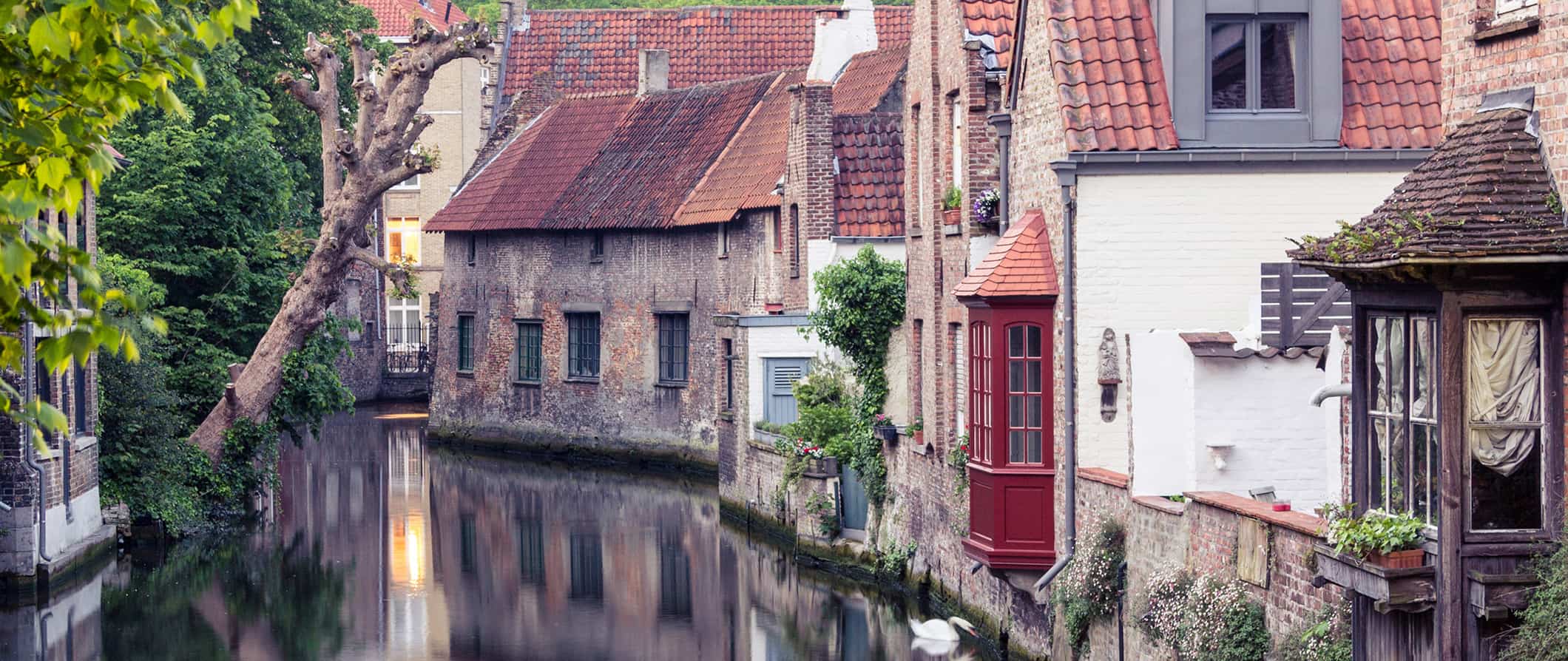
Bruges is one of the main reasons people visit Belgium . It’s one of the most famous medieval cities in Europe, boasting historic buildings, scenic canals, and attractive cobblestone streets. The entire historic center is recognized as a UNESCO World Heritage Site.
The first fortifications here were built in the 1st century BCE though the city didn’t prosper until the Middle Ages when it became an economic hub under the Hanseatic League. It was also home to the world’s first stock exchange (the Bourse), which opened in the 14th century.
Naturally, I found Bruges to be a very charming place to visit. It’s also expensive and touristy and there aren’t a lot of backpackers or budget travelers in Bruges due to the high prices.
That said, if you pass through Belgium, you’d be missing out if you don’t stop and visit Bruges for at least a night. Feast on waffles and chocolate, cruise the canals, and get your cultural fix while perusing the artwork at the Groeninge Museum. There is enough to keep you busy here for a day or two without busting your budget.
This Bruges travel guide can help you plan your trip, save money, and ensure you make the most of your time in this picturesque medieval town!
Table of Contents
- Things to See and Do
- Typical Costs
- Suggested Budget
- Money-Saving Tips
- Where to Stay
- How to Get Around
- How to Stay Safe
- Best Places to Book Your Trip
- Related Blogs on Bruges
Top 5 Things to See and Do in Bruges

1. Take a canal tour
Taking a canal trip down the arteries of Bruges is the perfect way to capture the magic of the city. A half-hour boat trip takes you around secret gardens, picturesque bridges, and ornate medieval buildings. It’s a great way to learn about the city from a different angle. Several companies operate these tours with pretty similar open-air boats that fit 30-40 people and following similar routes. Tours cost around 12-15 EUR, or you can take this combo canal and walking tour for the best of both worlds.
2. Admire Grote Markt
This is the city’s beautiful and medieval central square, dating all the way back to 958 CE. It’s stunning to see, though I’d advise skipping the restaurants here as they are overpriced. Look out for Huis Bouchoute with its giant compass (which points towards the direction of the wind rather than true North), the Provincial Palace, and other museums, including Historium Bruges, the Bruges Beer Experience, and the Salvador Dalí Exhibition – Bruges.
During Christmas, this area is transformed into a gorgeous Christmas market with its very own ice-skating rink which is part of the city’s ‘Winter Glow’, the collective name for the winter activities and decorations. Bruges’ Christmas markets run from late November until the first week of January.
3. See The Burg
The Burg is a city square that was completed in 1376. It boasts Gothic stone décor including the city hall (Stadhuis) which also contains a history museum featuring a small exhibit on the history of the city and impressive vaulted gothic hall with 20th-century murals depicting important historical events. Entry is 8 EUR.
The Basilica of the Holy Blood is also located here (so-called because it supposedly houses a relic of Jesus’s blood). Inside the church, there are two distinct areas: the Romanesque-style lower chapel and the ornate and colorful upper chapel. Entry to the basilica is free, while admission to the associated museum is 5 EUR.
4. Feast on chocolate
With dozens and dozens of chocolate boutiques, a chocolate museum, a chocolate trail, and a chocolate fair, this city is a chocolate-lovers paradise. You’ll find more of the higher-end, refined chocolate in this city — but it’s worth splurging on. Pay a visit to Dumon Artisanal Chocolatiers, BbyB or The Chocolate Line which all whip up a variety of interesting chocolate collections, shapes and flavors in-house. Consider taking a chocolate-making workshop to make your own Belgian chocolates!
5. See the Belfort Belfry
This 83-meter-tall (272 feet) bell tower is one of Bruges’ best-known landmarks. It once housed the treasury and the municipal archives and was used for spotting fires and other threats. After (somewhat ironically) being destroyed by fire one too many times, the belfry was never rebuilt and now only the tower remains. The 47 bells in the tower are played for an hour on Wednesdays, Saturdays and Sundays from 11am and over the summer in special concerts.
If you have 30 minutes to an hour to spare and there’s not much of a queue, it’s worth the climb up the 366 steps to the top to enjoy some spectacular and panoramic views of the city. It costs 15 EUR.
Other Things to See and Do in Bruges
1. visit the groeninge museum.
The Groeninge Museum, also known as the Fine Arts Museum of Bruges is one of the most popular museums in the city, exhibiting works from Bruges’ own Jan van Eyck (a 15th-century master). There is also a world-famous collection of paintings by the Flemish Primitives (artists active in the Burgundian and Habsburg Netherlands during the 15th- and 16th-century). Admission is 15 EUR.
2. Take a hot air balloon ride
While not exactly budget-friendly (prices are around 200 EUR per person) this is a really neat way to see the city from a new perspective. You can spot Bruges’ most iconic buildings and squares from above and scan the green fields as far as your eye can see. Some operators offer both morning and evening flight options too. It’s a cool option for anyone feeling adventurous or in the mood for some romance.
3. Sample the beer
Like the rest of Belgium, there’s a lot of good beer in Bruges. Visit the Brewery De Halve Maan, which dates to 1856, and tour the facilities, where an underground pipeline carries the beer to bottling plants in the suburbs (tours cost 16 EUR and come with a free beer). There’s also ‘T Poatersgat, an amazing underground cellar bar with around 120 Belgian beers on tap. Or try the house beer at Vlissinghe Café, the oldest pub in Bruges (it’s been around for 500 years!). Some beer tastings and tours even include food pairings with chocolate or waffles.
4. Explore by bicycle
Owing to its smaller size, Bruges is a great city to explore by bicycle. Be sure to get out into the countryside if you have the time as the landscape is very pretty and it will be much quieter. Rentals cost around 10 EUR for 4 hours and 13 EUR for a full day. If you want a guided tour, Quasimundo runs regular tours that cover all the highlights. Their tours last 2.5 hours and cost around 33 EUR.
5. Take a food tour
If you’ve got an unquenchable taste for Belgian beer and waffles, take a food tour. Discover Belgium has a variety of different food tours, including a beer and food pairing tour, a chocolate tour, and a gamified food tour where you have to solve puzzles while you learn about the food and city history. There’s also a classic food tour, where you’ll get an overview of the country and its delicious cuisine, visit several different places, and learn about the history and culture behind each dish. Tours range from 50 EUR and last around 4 hours. If you want to learn how to make some Belgian classics yourself, you can learn how to make waffles in this workshop — and eat all the waffles you want too!
6. Tour some of the quirkier museums
Bruges has several small, quirkier museums that are worth visiting if you have some spare time. The Diamond Museum takes you back 550 years to when the technique of cutting diamonds was first applied right here in the city (admission is 12 EUR). There’s also the Chocolate Museum or Choco-Story (14 EUR), where a tour comes with a delicious tasting session, and the much darker Torture Museum, filled with grotesque instruments of torture that were used during the Middle Ages (9 EUR). Last but not least, the interactive (and delicious) Frietmuseum is the only museum in the world dedicated to tracing the history and culture of the french fry (admission is 11 EUR and advance reservations are required ).
7. Meander around Minnewater Park
This beautiful greenspace is a great place for a stroll. The park is filled with weeping willow trees and swans bobbing around Minnewater Lake, or “Lake of Love” (though it’s more like a wider section of the canals than an actual lake). It’s said that the lake’s name is in reference to a pair of doomed medieval lovers, but that if you cross the bridge with your partner, you’ll experience eternal love. It’s worth stopping at the castle for a drink by the water as part of your walk.
8. See the windmills
Belgium has a long history of using windmills, and in the 16th century, there were over two dozen windmills in Bruges (windmills were used for cutting wood, pumping water, and grinding grain). There are a number of historic windmills from the 17th-19th centuries still standing, including the iconic 4 along the city ramparts where you can stroll or cycle along the canal, or relax on the grass. You can only visit one of the windmills, though: Sint-Janshuismolen. It still grinds flour and has a museum in the base where you can learn more about the windmill and grinding process (admission is 5 EUR).
9. Visit Historium Bruges
This interactive museum offers a unique way to learn about the city’s medieval history and everyday life through film and other multimedia exhibits. You can even do a virtual reality experience where you fly through the medieval streetscapes to see what the city used to look like hundreds of years ago. It’s an impressive merging of history and tech and an especially great place to visit for families with kids. Admission is 20 EUR or 25 EUR including the virtual reality experience. It’s recommended to book online beforehand to avoid the line.
For information on other cities in Belgium, check out these guides:
- Brussels Travel Guide
Bruges Travel Costs
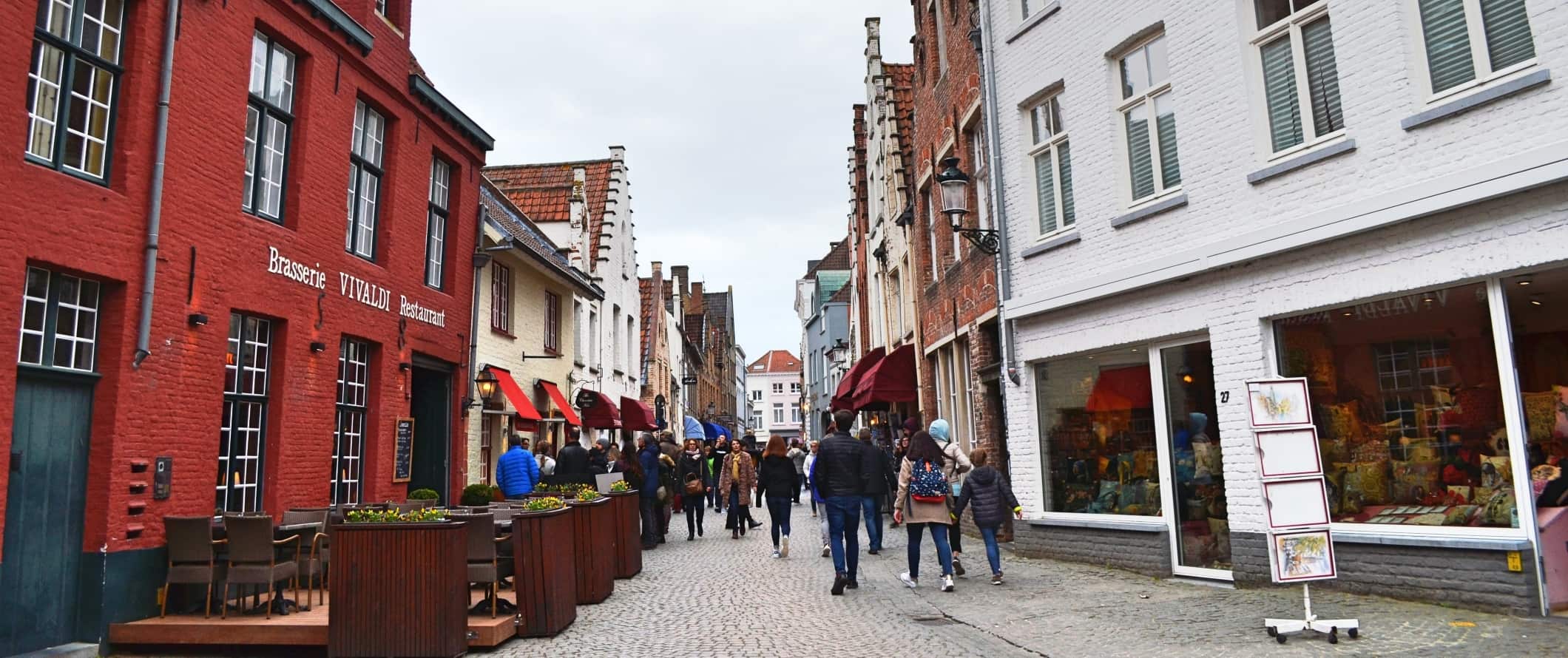
Hostel prices – Dorms with 6-8 beds cost 25-30 EUR per night.. A private room for two with a private bathroom starts around 75-100 EUR. Free Wi-Fi is standard though most hostels don’t offer free breakfast or self-catering facilities. Expect hostel prices to double in the summer.
For those traveling with a tent, camping is available outside the city. A basic plot for two without electricity starts around 20 EUR per night.
Budget hotel prices – Budget two-star hotels start at 75-100 EUR per night. However, there are more options with three-star hotels, which cost between 110-175 EUR per night. Expect basic amenities like free Wi-Fi, TV, and coffee/tea makers.
Airbnb is available here as well, with private rooms starting around 65 EUR per night. You can find whole apartments for around 120 EUR per night. Be sure to book early otherwise prices can double and spots are hard to find.
Average cost of food – Belgian cuisine has been strongly influenced by its European neighbors over the centuries, specifically France, Germany, and the Netherlands. Food here is hearty with chocolate, waffles, fries, and beer being the most iconic cultural staples. Steak and fries, mussels (often with fries), smoked ham, stew, and sausages are just some of the common dishes you’ll find here. Portions are large and filling too (the saying goes that Belgian food takes the portions of German cuisine but adds the quality and delicacy of French cuisine).
Casual meals at cafes cost around 10-20 EUR while fast food (think McDonald’s) costs 8 EUR for a combo meal. Takeaway shops are everywhere, at which you can get a filling cone of fries for 3-5 EUR or a waffle for 3-6 EUR. Pizza is around 15-19 EUR while Chinese food is 16-19 EUR.
A main dish at a casual eatery, especially in the town square, costs around 25-30 EUR (if not more). If you want to splash out on a three-course meal, expect to pay at least 60-75 EUR.
Beer is 3-5 EUR, a glass of wine is 4-5 EUR, and a cocktail is 10-12 EUR. A latte or cappuccino is around 3-4 EUR while a bottle of water is 2 EUR.
If you want to cook your meals, there are some great markets throughout the city. Expect to pay around 40-60 EUR for a week’s worth of groceries.
Backpacking Bruges Suggested Budgets
If you’re backpacking Bruges, expect to spend around 65 EUR per day. This budget covers a hostel dorm, cooking your meals, taking public transportation and walking everywhere, limiting your drinking, and doing most free activities like free walking tours and visiting the markets.
On a mid-range budget of 170 EUR per day, you can stay in your own room, enjoy a few drinks, eat out most meals, take the occasional taxi to get around, rent a bike, and do more paid activities like visiting museums and taking a canal cruise.
On an upscale budget of 300 EUR or more per day, you can do whatever you want. The sky is the limit here.
You can use the chart below to get an idea of how much you need to budget daily. Keep in mind these are daily averages – some days you’ll spend more, some days you’ll spend less (you might spend less every day). We just want to give you a general idea of how to make your budget. Prices are in EUR.
Bruges Travel Guide: Money-Saving Tips
Bruges, a city that seems designed for older travelers and couples, is not a cheap place to visit on a budget. If you want to save money, here are some suggestions to help you get started:
- Walk everywhere – Walking is the best way to see and get around the city. Most of the city’s main attractions are within 15 minutes of each other. There’s really no reason to take a bus or taxi. Save a few euros and walk everywhere.
- Take a free walking tour – Free walking tours are the best way to get the lay of the land, see the main sights, and connect with a local guide who can share their insider tips. Just be sure to tip at the end!
- Get the Musea Brugge Card – This handy little card entitles you to free entry to 27 museums and attractions in Bruges as well as cruises on the canal. You can also get 25% off a variety of concerts, dance and theater performances, and bike rentals. If you are going to do many of the things listed on the card, this pass will save you money!
- Visit the farmer’s market – On a Wednesday morning, the Grote Markt Square is taken over by a market that offers cheaper food and drinks than what you’ll usually find. Restaurants are expensive, so loading up on fresh food at the market will cut down your food expenses.
- Stay with a local – Hospitality networks like Couchsurfing connect you with locals who can give you a free place to share and share their insider tips and advice. It’s the best way to save money and have a more local experience.
- Bring a water bottle – The tap water here is safe to drink so bring a reusable water bottle to save money and reduce your plastic use. LifeStraw is my go-to brand as their bottles have built-in filters to ensure your water is always clean and safe.
Where to Stay in Bruges
There are only a few hostels in Bruges and limited choices for budget accommodation. Here are my recommended places to stay:
- Snuffel Hostel
- St. Christopher’s Inn Bauhaus Hostel
- Lybeer Travellers’ Hostel
- Cornerhouse Level Ten
- Hotel Van Eyck
How to Get Around Bruges
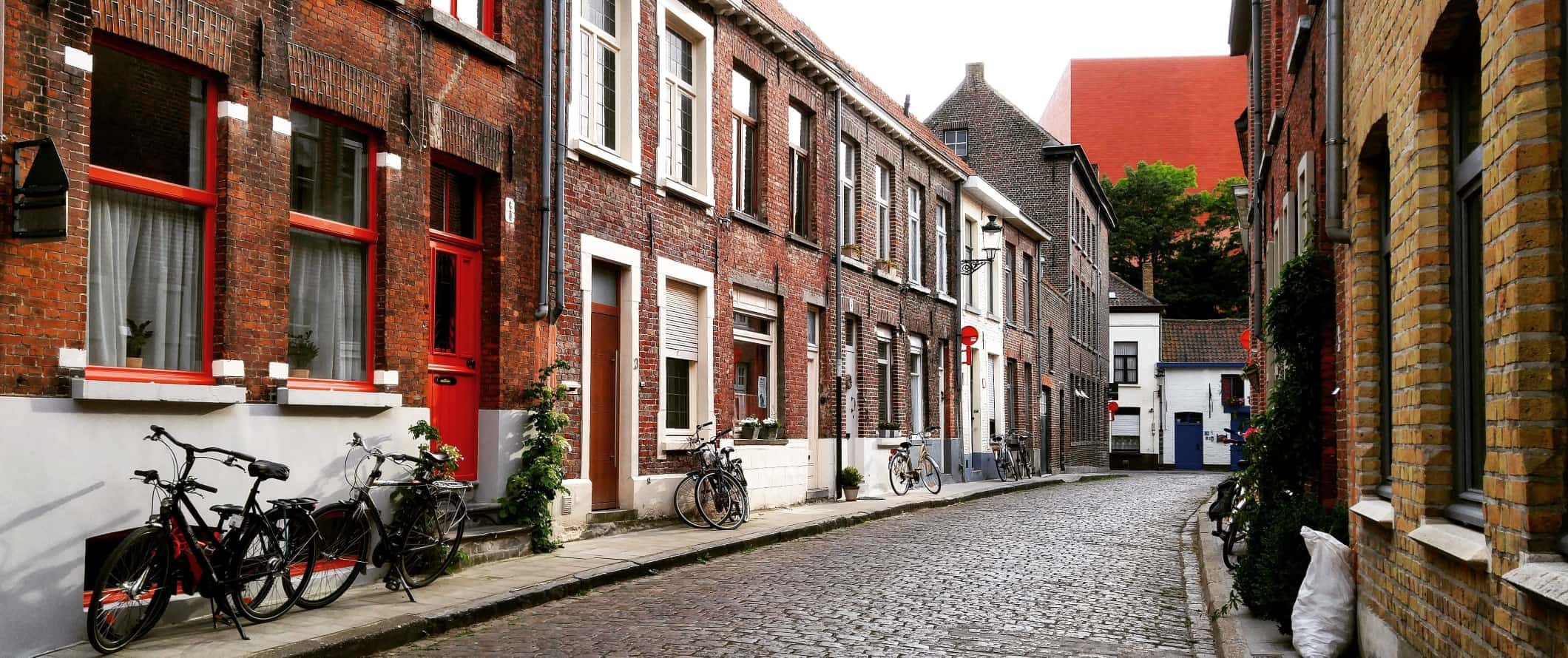
Public transportation – The local bus is operated by De Lijn. Single tickets cost 2.50 EUR and are valid for one hour. If you plan on using the bus a few times throughout the day, a day pass costs 7.50 EUR.
Bicycle – Renting a bicycle is a great way to get around town since it’s compact. Hourly rates start at 4 EUR, while full-day rentals start from 13 EUR. There are a handful of bike rental shops, including Fietspunt Station and Ben’s Bike Bruges where you can rent a city bike and even an e-bike.
Taxi – Taxis are expensive here. The base rate is 23 EUR, then it’s an additional 2.70 EUR per kilometer. Skip them if you can as they will destroy your budget. The city is small too so you really shouldn’t need one.
There are no ridesharing services like Uber here.
When to Go to Bruges
Summer is the best time to visit Bruges. This is when the weather is nicest and the city is in bloom. The average temperature in August is 20°C (68°F), and it rarely gets much hotter than that. Since Bruges is on the coast and has a maritime climate, summers are mild and winters are cold and windy.
Spring and fall are the shoulder seasons, with cooler temperatures and fewer visitors. In April and May, temperatures are under 10°C (40s and 50s°F). Temperatures in the fall range from 8-12°C (47-54°F), and it gets rainy around this time, too. If you don’t want to deal with the summer crowds, this is a good time to visit. Just pack a raincoat and sweater.
Most people avoid visiting in the winter as the temperatures drop to near freezing. But if you want this magical city all to yourself, especially when there are Christmas markets, Bruges is worth a wintry visit!
How to Stay Safe in Bruges
Bruges is very safe to visit. Violent crime is incredibly rare here so travelers should feel safe. However, since it is a touristy city, pickpocketing and petty theft can occur. Always keep your valuables secure and out of reach when out and about, especially in crowds and on public transportation.
Solo female travelers should feel safe here for all those reasons. However, the standard precautions you take anywhere apply here too (never leave your drink unattended at the bar, never walk home alone intoxicated, etc.). There are numerous solo female travel blogs that can provide more specific tips.
Scams here are rare, however, if you’re worried about getting ripped off you can read about common travel scams to avoid here.
If you experience an emergency, dial 112 for assistance.
Always trust your gut instinct. Make copies of your personal documents, including your passport and ID.
The most important piece of advice I can offer is to purchase good travel insurance. Travel insurance will protect you against illness, injury, theft, and cancellations. It’s comprehensive protection in case anything goes wrong. I never go on a trip without it as I’ve had to use it many times in the past. You can use the widget below to find the policy right for you:
Bruges Travel Guide: The Best Booking Resources
These are my favorite companies to use when I travel. They consistently have the best deals, offer world-class customer service and great value, and overall, are better than their competitors. They are the companies I use the most and are always the starting point in my search for travel deals.
- Skyscanner – Skyscanner is my favorite flight search engine. They search small websites and budget airlines that larger search sites tend to miss. They are hands down the number one place to start.
- Hostelworld – This is the best hostel accommodation site out there with the largest inventory, best search interface, and widest availability.
- Booking.com – The best all around booking site that constantly provides the cheapest and lowest rates. They have the widest selection of budget accommodation. In all my tests, they’ve always had the cheapest rates out of all the booking websites.
- Get Your Guide – Get Your Guide is a huge online marketplace for tours and excursions. They have tons of tour options available in cities all around the world, including everything from cooking classes, walking tours, street art lessons, and more!
- SafetyWing – Safety Wing offers convenient and affordable plans tailored to digital nomads and long-term travelers. They have cheap monthly plans, great customer service, and an easy-to-use claims process that makes it perfect for those on the road.
- LifeStraw – My go-to company for reusable water bottles with built-in filters so you can ensure your drinking water is always clean and safe.
- Unbound Merino – They make lightweight, durable, easy-to-clean travel clothing.
- Top Travel Credit Cards – Points are the best way to cut down travel expenses. Here’s my favorite point earning credit cards so you can get free travel!
- BlaBlaCar – BlaBlaCar is a ridesharing website that lets you share rides with vetted local drivers by pitching in for gas. You simply request a seat, they approve, and off you go! It’s a cheaper and more interesting way to travel than by bus or train!
Bruges Travel Guide: Related Articles
Want more info? Check out all the articles I’ve written on backpacking/traveling Belgium and continue planning your trip:
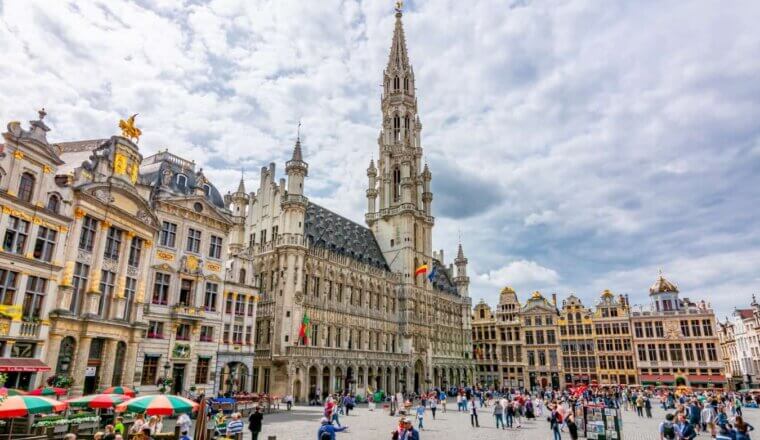
The Best Things to Do and See in Brussels
Get my best stuff sent straight to you, pin it on pinterest.
- Where To Stay
- Transportation
- Booking Resources
- Related Blogs

The EPIC One Day in Bruges Itinerary for 2024 (& Map!)
Is it worth spending just one day in Bruges? Is 24 hours enough time to see Bruges?
Coming from someone who looks for any excuse possible to be whisked away to a Belgian city, Bruges easily tops my list of my favorite cities not just in the nation, but in Europe as a whole!
After numerous visits, I’ve found that whether you’re looking for a romantic getaway or a family-friendly vacation, the fairytale city of Bruges is the perfect destination. This historic city in Belgium is filled with beautiful architecture and picturesque canals that make it feel like an escape from the world.
Not only have I provided you with the best one day itinerary for Bruges, but also information on the best time to visit, numerous practical tips for your trip, and everything you need to know about where to stay, what to eat, and what to do!
With this ultimate guide in hand, you can be confident you’ll have the best insider tips before stepping foot in this medieval city.
Are you debating between Brussels and Bruges? Read my ultimate guide on how to choose between Bruges and Brussels to help settle your decision.
What Can You Do in Bruges for One Day?

Bruges, Belgium is a quaint little town that shines in all its glory with colorful historic buildings and winding canals.
It would take you weeks to explore the entirety of this city, so we have put together an ultimate one day in Bruges itinerary for those who want to see as much of it as possible even if you’re short on time!
There are many different things on offer when visiting such a beautiful spot, but here are some must-do’s when visiting Bruges as well as meal ideas and so on.
This itinerary starts in the morning and ends on an overnight in Bruges, so you may need to alter the itinerary slightly if you plan on arriving mid-day, or aren’t staying for a full 24 hours.
Just be sure to pay attention to where the attractions are if you decide to do them out of order so you don’t end up retracing your steps!
Morning – One Day in Bruges

First off, breakfast . Now, if you’re like me, breakfast is a must on a day full of sightseeing and these two breakfast spots are sure to start your day off right.
Head down to Sanseveria Bagelsalon for delicious bagel breakfast sandwiches and coffee for the perfect on-the-go meal, or to Balthasar Brugge for an assortment of both modern and traditional Dutch breakfast dishes.
Depending on which month you visit Bruges, you may have to wait in line for some of the more popular tourist attractions. So, our next stop brings us to Market Square. Get up high by climbing the stairs of the Belfry Tower and witness panoramic views over the city of Bruges’ streets and gothic rooftops.
By doing this earlier in the morning, you’ll be rewarded with far fewer tourists in the tower itself as well as the streets, making for some pretty spectacular photos. On your return, start making your way through Market Square (it’s among the most popular places to visit in Bruges in one day).
Since we don’t recommend eating lunch here as it is almost always overpriced and tourist-quality food (a nice way of saying poor-quality… do NOT try the waffles here), it’s the perfect late morning start to check out the unique shops, architecture, and pick out a few museums you’d like to see! We suggest the Groeninge Museum .
Afternoon- One Day in Bruges

Once you have finished exploring the square, we suggest checking out any museums or art galleries if that’s high on your list. Since you may need to wait in line for a while, you’ll want to make sure you get there early for the quickest entry.
✔️ Pro Tip : do some research before getting to Bruges on the museums and galleries you want to see, and find out when they open and if you can buy your tickets online. This will save you plenty of time during your one day in Bruges from standing in lines for excessively long periods of time!
Next, we’re moving towards Burg Square . Filled with old, vibrant buildings, plenty of shops, and the opportunity to take a horse and buggy ride, this area of the city is sizzling with culture.
After you’ve made your way through this bustling square, make your way over to the Church of our Lady Bruges ! This church is one of the most iconic landmarks in Bruges. The building itself dates back to medieval times when it was first built as a church for worshipers from all over Europe.
Nowadays, people flock here every day to enjoy its rich history while also posing with the statue that has graced its front entrance for over 100 years.
Once you’ve taken in all of these big sights and squares, it’s time for lunch! Looking for traditional Dutch food? Check out De Gastro or Sfeerbistro De Twijfelaar for spectacular Belgian cuisine. Looking for a vegetarian or gluten-free option? Check out Het Visioen !

If you’d rather stick to just the sweet stuff like chocolate and waffles, I hear you. House of Waffles on Wollestraat St. is serving up the best homemade Belgian waffles with all the fixings and toppings you could want. They also have a menu of popular favorites for those looking to explore new flavors!
As for the best chocolate, it wouldn’t be a trip to Bruges without stopping at The Chocolate Line . They show you everything from how the cocoa bean is collected to how the chocolate bar is made, and offer one of the largest varieties of chocolates in the country! It’s easily one of the best things to do in Bruges in one day.
Afterward, be sure to check out the Choco-Story Museum which is dedicated to the world of chocolate.
Evening- One Day in Bruges

Once you’ve had your fill of delicious Belgian favorites, we suggest taking a canal boat ride . They offer an exclusive Bruges experience of both the city, the bridges, and the canals, all while the driver tells you about the history of Bruges and the ancient buildings you’ll be gliding by.
They’re typically only about €10 per adult and €6 per child, and are a fun and exciting way of seeing the city! You won’t feel as though you’re missing out on anything since you’ll be both relaxing and sightseeing at the same time.
Last on our list is the Bruges City Hall . While you can take tours through here, we recommend just photographing the exterior unless you’re a true history enthusiast.
We also suggest visiting around sunset when the windows glow with a beautiful orange light! It’s the prettiest time to see this architecturally stunning building, so you won’t regret saving it for the end of your day.
Now, just because you’re technically done sightseeing, the evening doesn’t need to end there. We suggest heading to dinner at either Réliva , ONE Restaurant , or The Olive Tree Brugge .
While these are some of the top spots in the city, there are dozens of more places to grab a cozy, evening meal at a reasonable price. Just remember to avoid the main squares when deciding on a food spot!
To finish off your evening, hit a couple of local bars (I enjoyed the Halve Maan Brewery ) for a pint or two before walking back to your accommodation. Yes, you may be exhausted from all of the walking and sightseeing, but it really will be worth it.
This is the best time to enjoy an evening surrounded by the locals, which from our experiences, is the best time to truly get to know a new country’s culture. It’s funny the magic of a local pub, isn’t it?
This is our ultimate one day in Bruges itinerary, but if you have more time you’ll be able to see far more museums, find the more authentic souvenir shops , learn more about Bruge’s history with lacemaking, and more!
Map of One Day in Bruges Itinerary
The map below shows the most efficient walking course of our above itinerary, though you may want to do it slightly out of order if you plan on visiting places at the best times for tourist levels and time of day.
How to Get to Bruges

If you’re coming from within Western Europe, it’s likely that the best and most scenic way of getting to Bruges is via the Eurail . The train is fast, affordable, convenient, and easy to use in comparison to flying and the train station is very easy to navigate.
However, if you’re coming from central or Eastern Europe, it will most certainly be faster to fly, and also may save you a little bit of money. Do some research on both before deciding which one is best for you.
If you’re coming from outside of Europe altogether, then you will have to take a plane to enter the Union. Keep in mind that you can choose to fly into other cities, then take the train to Bruges, as well!
Not only can this save you some money, but it can also give you the opportunity to explore some other wonderful European cities.
How to Get Around During Your One Day in Bruges

Since you’ll only be spending one day in Bruges, your best option will be to walk pretty much everywhere .
Bruges is extremely walkable , with many of the major attractions and sites within close proximity to one another, so as long as you’ve packed good walking shoes you shouldn’t have any problems.
Other fun ways of getting around include renting bikes or taking a horse and buggy ride (if you’re looking for unique things to do in Bruges!) Bikes are a great option for exploring the city in an efficient manner, while also saving your feet a bit of walking, and are quite affordable.
In fact, this is actually how the majority of locals get around Bruges, so you should fit right in (as long as you stay in the bike paths!)
The horse and buggy ride may not get you to a specific point, but it is a fun way of seeing the city and makes for some very romantic and cute pictures. Our other favorite way of getting around is to take a canal cruise.
Again, you’ll be returned to the same spot that you started, but these boat rides offer you a very unique perspective on the city that you wouldn’t get otherwise!
The canals are absolutely beautiful and you’ll get to see far more of the city since many of the houses sit directly on the banks of the canals with no walkable sidewalks. Thus, by taking the boat ride, you’ll get to experience more of the city than if you were to stay on foot or bicycle the entire time.
What to Eat in Bruges

Of course, you’ve heard of Belgian fries, beer, waffles, chocolate, cheese curds, and so on. But, what about all of the other traditional dishes the Dutch enjoy? Here are a few of our favorites!
✔️ Moules-Frites
One of the most traditional and delicious plates in Belgium are Moules-Frites. Mussels steamed in either white wine or beer and light seasoning are served with a heaping bowl of frites (fries) for soaking up the delicious sauce once the mussels are gone.
✔️ Waterzooi
This traditional Flemish dish dates back to the Middle Ages and is both creamy, savory, and just oh-so-good. Filled with flaky fish chunks, salty butter, and rich egg yolks, this is one of the best comfort foods you can find in Belgium.
✔️ Carbonnades flamandes
This ultimate comfort food is a rich and decadent stew filled with tender meat that has been simmered for hours in Belgian beer in a Dutch crockpot. Also served with a side of frites for dipping, you’re sure to need a nap after this meal.
✔️ Sirop de Liège
This sticky and ultra sweet paste made of just dates, apples, and pears is delicious on bread, with cheese and meats, or slathered on a fluffy Dutch pancake!
✔️ Croquettes aux crevettes grises
Small grey shrimp get covered in a creamy, white bechamel sauce, rolled in crunchy breadcrumbs, and fried for the ultimate Belgian staple!
Where to Stay in Bruges
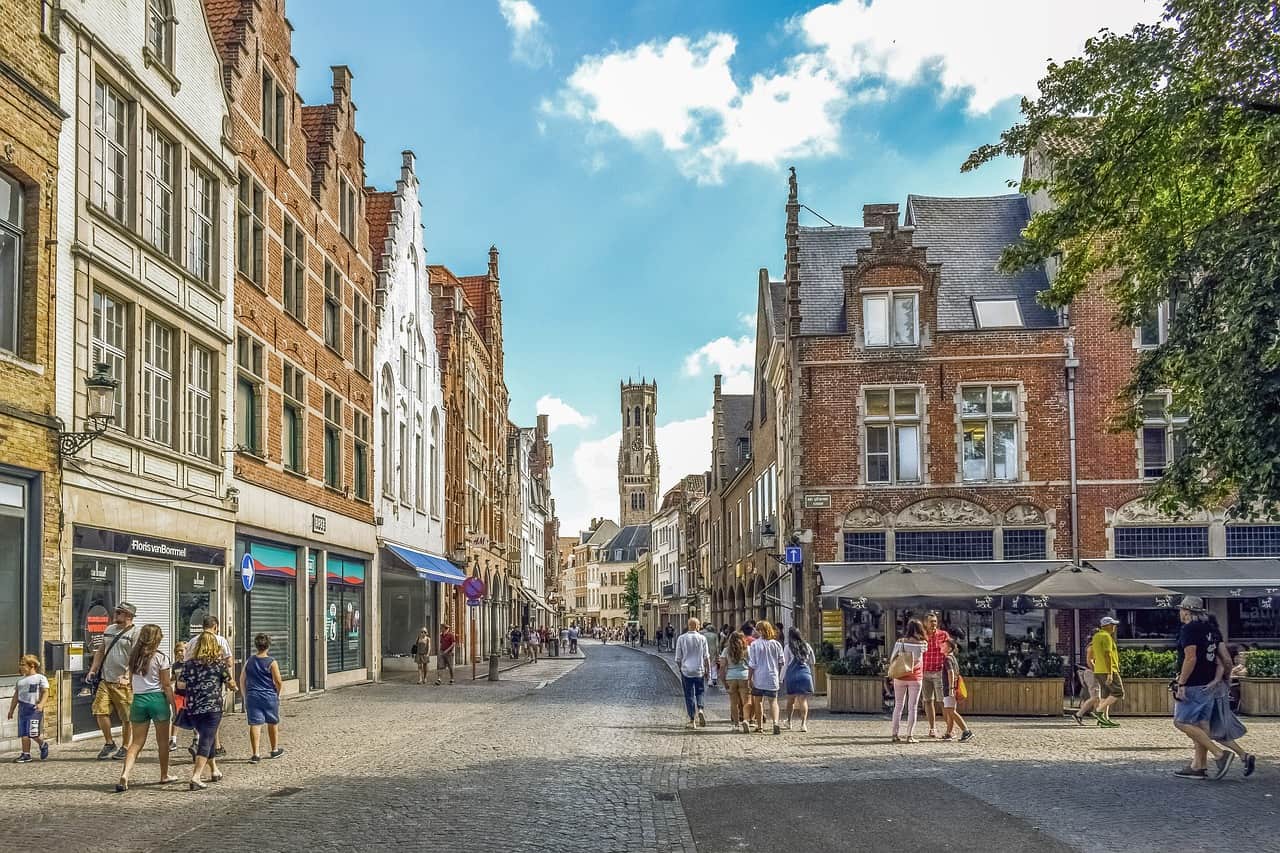
Whether you’re looking to stay in the center of Market Square surrounded by the hustle and bustle of dozens of shops and restaurants or if you’re a budget traveler looking for a clean and unique accommodation, some of the best places stay in Bruges can be found in the areas below!
✔️ The City Centre
Bustling with life and popular attractions such as the Belfry Tower and the enormous City Hall, Market Square and the surrounding streets are both expensive and beautiful.
If you’re looking to be in the middle of all the action as to save time on exploring and getting from place to place, this is where we suggest staying if you only have 1 day in Bruges.
✔️ Sint-Anna Quarter
This area of the city is in close proximity to the city center (about a 12-minute walk) and is close to multiple popular museums and is located in a quiet neighborhood.
More of a locals spot, this is a unique place to stay with its beautiful, tight network of windy streets, nearby windmills, and medieval architecture.
✔️ Ezelstraat Quarter
Located on the western edge of the city center, this ancient part of the city is over 800 years old! Brimming with both ancient architecture, fascinating museums, and modern bars and restaurants, this is the best area to stay in for budget travelers and couples alike.
You can find cheap accommodations and spend your evenings bar-hopping the night away!
✔️ Magdalena Quarter
Simply full of quaint parks, this is a fantastic area for people traveling with kids. It’s located outside of the city center so you can guarantee some quieter nights, and the cobblestone streets in this part of town are very charming.
Just a 10-minute walk from Market Square, you can be in the middle of the top sights in no time.
✔️ Sint-Gillis Quarter
Close to the beautiful Hof de Jonge park, the Sint-Gilliskerk Catholic Church, and plenty of low-key cafes and breweries, this is a great place to stay if you’re looking for a more off-the-beaten-path accommodation.
Though it is slightly more expensive than some of the other areas in the city, it is good for both families and couples.
Travel Tips for Visiting Bruges

Whether you’re visiting Bruges for one day or one month, these are some of our best insider tips for getting the most out of your experience!
✔️ Beer is Cheaper than Water
Owing to the hundreds of nearby breweries and distilleries, beer is almost always cheaper than water here. Also, since many restaurants will only offer bottled water, you can expect to pay around €3 per bottle versus about the same amount for an entire pitcher of beer.
✔️ There is No Crazy Nightlife Scene
Just because the fun and wild Amsterdam is nearby, doesn’t mean you’re going to get the same experience in Bruges. Instead, you’ll find dozens of cozy bars and the occasional live music spot or two. But, don’t expect to find chaotic street parties and an abubndance of public intoxication.
✔️ Pack Good Walking Shoes
Almost every street in Bruges is made up of broken, warped, and misshapen cobblestones. So, leave your heels at home and pack a nice pair of comfortable shoes that can last a few miles of walking on bumpy terrain instead!
✔️ There’s No Such Thing as “Diet Food”
When in Bruges… indulge! Chocolate, waffles, beers, Belgian fries with curry… you get the picture. Most traditional Belgian meals are rich with meats, gravies, cheese, and salt. So, I would save your diet until you return home.
✔️ You Won’t Pay for Most Attractions
The best attractions in Bruges are, well, all around you! Stroll along the canals, photograph the beautiful buildings, and enjoy an espresso while people-watching in Market Square. These are truly the best way to experience Bruges.
FAQ: One Day in Bruges
In this next section, I’m going to dive into answering all of the essential questions you’ll need to know about before spending a full day in Bruges!
Is 1 Day Enough for Bruges?

If you are visiting Bruges, Belgium for the first time in your life and want to see all of the sights, try all of the foods, and join in all of the activities and festivities… then one day may not be enough.
That being said, in just one day in Bruges you’ll be able to experience the best this gothic city has to offer!
From wandering the windy streets, taking a canal boat tour ride, sampling some Belgian chocolate, stuffing your face with waffles and beer, checking out the incredible town hall, and climbing the iconic Belfry of Bruges Tower, you are sure to have an exciting and magical trip to Bruges even if you only have a little time.
So, we truly believe it depends on you! If you don’t mind missing out on a few of the smaller sights and attractions, then you can definitely visit Bruges for just a day.
But, if you prefer to explore each city you visit to the fullest, then we highly suggest at least two days in Bruges.
How Long Should You Spend in Bruges?
A recommended visit to Bruges would ideally span at least two full days . It’s not a huge city so 3 days may be a lot for some people, so this amount of time allows ample for visiting the iconic attractions such as the Belfry of Bruges and Basilica of the Holy Blood, and meandering through the charming alleys and soaking up the atmosphere without rushing.
With an extra day, you can explore the city at a more leisurely pace, find local eateries, taste more of the rich and savory Belgian cuisine, and even venture into the surrounding countryside or take a boat tour on the canals.
Can You Do Bruges as a Day Trip?

Bruges is a quaint and charming medieval European town with an abundance of canals lined by colorful houses built around them to mimic Venice’s urban design – but on a smaller scale – giving Bruges the nickname, “Venice of the North.”
You’ll find many shops along these narrow cobbled lanes selling goods from Belgian chocolate to Flemish lacework, all of which makes it worth visiting Bruges alone.
The canal-lined streets are perfect for walking, biking, or just taking pictures of this centuries old town. Bruges has preserved its old-world charm (so well that it’s been recognized as a UNESCO World Heritage Site ), so whether you’re a history buff, nature lover, or culture connoisseur there is something here for everyone!
Is Bruges or Ghent Better?

In my humble opinion, Bruges is better, but each city has its own distinctive charm. Bruges, with its well-preserved medieval architecture and picturesque canals, feels like stepping back in time. It’s perfect for those who want to experience a fairy-tale ambiance.
Ghent, on the other hand, is vibrant and youthful, thanks to its large student population. It offers a seamless blend of historic charm and contemporary culture, appealing to those who like a bustling city vibe. So, whether Ghent or Bruges is better really depends on your personal preferences!
Can You Do Bruges and Brussels in One Day?
While it’s physically possible to visit Bruges and Brussels in one day, doing so would require an early start and a late finish, resulting in a very rushed experience. Each city is rich with history, culture, and attractions that deserve time to be fully appreciated.
If short on time, a more rewarding approach would be to prioritize what you want to see and do most in one city, preferably starting with Bruges for its smaller, more walkable city center. For those who must visit both, consider the main highlights and plan your schedule efficiently to make the most of your day.
What is the Best Time to Visit Bruges?

While many folks believe the best time to visit Belgium is in the warmer months of summer (high season for tourists), we typically disagree.
Yes, this is when you’ll find wonderfully warm weather and a hip night scene, but it’s also when you’ll find massive tourist crowds, long wait times at restaurants and attractions, and crowded cobblestone streets.
Instead, we believe the best time to visit Bruges is in the shoulder season months of April and May and late August through September . Bruges is also stunning during the winter holidays and offers plenty of outdoor markets (similar to Grote Markt in Antwerp) worth exploring!
If your goal when visiting Bruges is to see the iconic tulip fields, then your best chance to enjoy them will be in April and May when they are at their peak blooming period.
Believe it or not, they actually don’t usually bloom past the end of May, so if you visit during the height of summer you’ll miss them!
These shoulder season months also coincide with the majority of people still in prime work periods and school is still in session, so you’ll get to enjoy all of what Bruges has to offer with far fewer tourists!
You’ll still experience comfortable weather (though it may be a bit rainy), get to chat with lots of locals, and have little to no wait times at most of the major attractions.
In our experience, the best time to visit Bruges is from April through May !
How Much Does Bruges Cost?

Though slightly more expensive than other popular European cities such as Lisbon or Budapest, Bruges is still quite affordable and can definitely be visited on a budget .
For flights, it’s best to book them as far in advance as possible to get the best deals . Similarly for trains , keep an eye out for when the tickets go on sale (usually between 90-120 days before the departure date ) to save money when booking.
As for accommodations , budget hostels average around 40 euros per person per night . Mid-range hotels average around 90-100 euros per night for double occupancy. And luxury hotels can range anywhere from 150 euros to over 300 euros per night .
However, keep in mind that each of these averages will vary depending on the time of the year that you visit , how many people will be staying in the room , and the area of town that you decide to stay in.
When it comes to meals, you can either spend a little – or a lot – of money. Don’t forget that while Bruges is slightly more off-the-beaten-path than other towns in Belgium, it’s still quite touristy and many of the businesses thrive from the revenue of tourists .
So, avoid eating your meals at sit-down restaurants in the center of Market Square or Burg Square if you’re looking to save some money.
Also, due to meal taxes and gratuity, sit-down meals will be one of your biggest expenses. The average lunch will cost you between €10-15 and dinner will cost you around €15-20 per person.
Whereas an on-the-go waffle with all the toppings you could dream of, Belgian fries, and other popular street foods will only set you back up to €5. If you’re really looking to travel on a budget, avoid the sit-down restaurants in the center of the city .
As for inter-city transportation, bicycles cost around €13 per day for an adult, or about €3-4 per hour if you decide to only keep the bike for an hour or two.
Boat canal rides cost around €10 , and the horse and carriage rides are about €55 per 30 minutes. So, if you’re on a budget, pack some good shoes and be ready to do some walking .
Overall, your meals and your accommodation will be your biggest expenses, so be sure to use this guide to help you save some money if you’re looking to stick to a budget!
What are the Best Things To Do for One Day in Bruges in Winter

If you have the option of visiting Bruges in winter, do it! The medieval city center gets covered in white lights and is absolutely stunning to walk through during the holidays.
Here are some of our favorite things to do in Bruges in winter!
✔️ Drink Mulled Wine
This tasty treat is served all over town from wooden stalls that go up every holiday season.
Enjoy with a hot meal for the ultimate cozy dinner, or grab a glass to walk around with as you stroll the cobblestone streets looking at all of the decorations and beautiful lights.
✔️ Take a Carriage Ride
Looking for a romantic stroll around town? What better way to do it than wrapped up in blankets, sipping hot chocolate (or mulled wine) with your loved one.
Not to mention… this would make one hell of a proposal!
✔️ Shop for Holiday Gifts
Many of the stores around Bruges sell authentic, handmade items around the holidays which make for the perfect holiday gifts for your loved ones back home.
Be sure to leave room in your suitcase for all of your special finds!
✔️ Go Ice Skating
In the wintertime, Bruges holds several ice skating rinks around town making for the ultimate winter activity!
Try your hand at this fun winter sport for the first time, or cruise around the ponds in style with your loved one.
✔️ Visit the Bruges Christmas Markets
Starting in late November, Bruges begins setting up their holiday markets for the Christmas season.
Dozens of stalls sell everything from crafts to artwork, food, jewelry, and everything in between.
Whether you’re looking to shop or simply get into the Christmas spirit, this is the perfect full-day activity for anyone spending 1 day in Bruges in the winter!
What To Do if you have More than One Day in Bruges

For some people, one day in Bruges is plenty of time. But for others (like me), one day was just the beginning! Just in case you find yourself in the same boat on your trip to Bruges, I recommend keeping your itinerary flexible so that you can add or remove time in Bruges if you wish.
If you do decide to extend your stay in Bruges, you’ll have the opportunity to explore more museums, spend some time people-watching, and even join a couple of exciting tours!
Here are some ideas for if you have more than one day in Bruges and want to see as much of the city as possible.
First, if you are traveling to Bruges pretty much solely for the food (I hear ya!), you have to visit the Frietmuseum ! This museum is dedicated to showcasing the history of potatoes and how to make scrumptious Belgian (french) fries.
There are also several chocolate museums (like the ones I mentioned above) as well as endless chocolate shops that offer free tastings, guided tours, and the option to purchase TSA-approved chocolatey treasures!
Also, any art enthusiast should have the Gruuthusemuseum high on their list. This museum boasts extensive collections of impressive works from the 15 th -19 th centuries.
If you have the time, a trip to the scenic Minnewater park and castle is great for families, couples, and those looking to get away from the city. It’s known for its “ lake of love ” and magical ambiance. Another impressive castle to hop on a train and go visit is the Streekhuis Castle Tillegem .
You can also go visit one of the last active windmills in the region called Sint-Janshuismolen . It dates back to the 18 th -century is a real joy to see.
Of course, you can skip adding activities to your days and simply people watch and enjoy the local ambiance. Bruges truly feels like a fairytale land with its stunning medieval architecture and pristine canals.
Spend some time strolling the streets with a coffee in hand for a magical experience you won’t soon forget!
Day Trips to Bruges

Due to Bruge’s location on the far western side of the small country, it can be slightly difficult to get there for just a day trip from neighboring cities outside of Belgium.
While we highly recommend that you do visit, keep in mind the distances that you may need to travel roundtrip in order to make it happen.
We have created a list of the nearby cities that tourists typically visit from and how long it will take for you to get there so you can estimate if it’s a good fit for your itinerary or not.

✔️ Day Trip to Bruges from Ghent
45 minutes roundtrip of traveling by train (highly suggested!)
✔️ Day Trip to Bruges from Brussels
2 hours and 15 minutes roundtrip of traveling by train
✔️ Day Trip to Bruges from Antwerp
3 hours roundtrip of traveling by train
✔️ Day Trip to Bruges from Rotterdam
4 hours roundtrip of traveling by train
✔️ Day Trip to Bruges from Paris
5 hours and 15 minutes roundtrip of traveling by train
✔️ Day Trip to Bruges from Amsterdam
6 hours roundtrip of traveling by train
✔️ Day Trip to Bruges from Dunkirk, France
8 hours roundtrip of traveling by train
Guided Tours in Bruges
The guided tours listed below are just a few of the dozens of exceptional tours available to you during your one day in Bruges!
If you’re limited on time, these tours are a great way of ensuring you squeeze a lot of sightseeing and activities in before it is time to depart.
From authentic food and beer tours to in-depth city walking tours with local guides, there are tons of benefits to joining one of the fun tours below!
Other One Day in a City Articles
Enjoying our one day itineraries? Check out our others from more popular destinations across Europe!
One Day in Paris One Day in Prague One Day in Budapest One Day in Berlin One Day in Porto One Day in Lisbon One Day in Amsterdam One Day in Barcelona One Day in Brussels One Day in Ghent
3 Incredible Day Trips from Brussels
If I had known about these 3 incredible towns in Belgium, I would have spent WAAAY less time in Brussels…
And no, they aren’t Ghent or Antwerp!

Bruges is known for its medieval streets, architecture, and canals and is the perfect place for families, couples, and solo travelers (male and female).
Owing to its perfect balance of small town Europe and medieval charm, we truly believe you’ll have a hard time finding something to complain about here.
With plenty of options when it comes to attractions, activities, and sightseeing, you’re bound to have an exceptional time during your one day in Bruges . We hope this itinerary gives you some ideas for your next visit to this amazing Belgian city!
Hey there! I'm Emily Concannon, a seasoned globetrotter who has backpacked her way across over a dozen European countries, immersing myself in the diverse cultures, languages, and cuisines of the region.
My passion for travel transcends personal experiences; I've spent years learning how to transform my globetrotting knowledge into personalized itineraries for fellow travelers worldwide.
With a tally of 26 countries (and counting!) under my belt, my day job involves extensive research on different countries which often leads me to booking a new adventure every chance I get!

A Weekend in Bruges: How to Plan The Perfect Bruges City Break
Planning to spend a weekend in Bruges and not sure where to start? Don’t miss this step by step guide – everything you need to know for the perfect Bruges city break.
It’s no secret that I am completely and utterly enchanted by Bruges . Small and compact, but with plenty to do, it is the perfect city break destination .
I first visited the city six years ago – I spent a week wandering around Bruges, getting to know the different neighbourhoods, seeing all the big attractions, finding a few off-the-beaten track spots too.
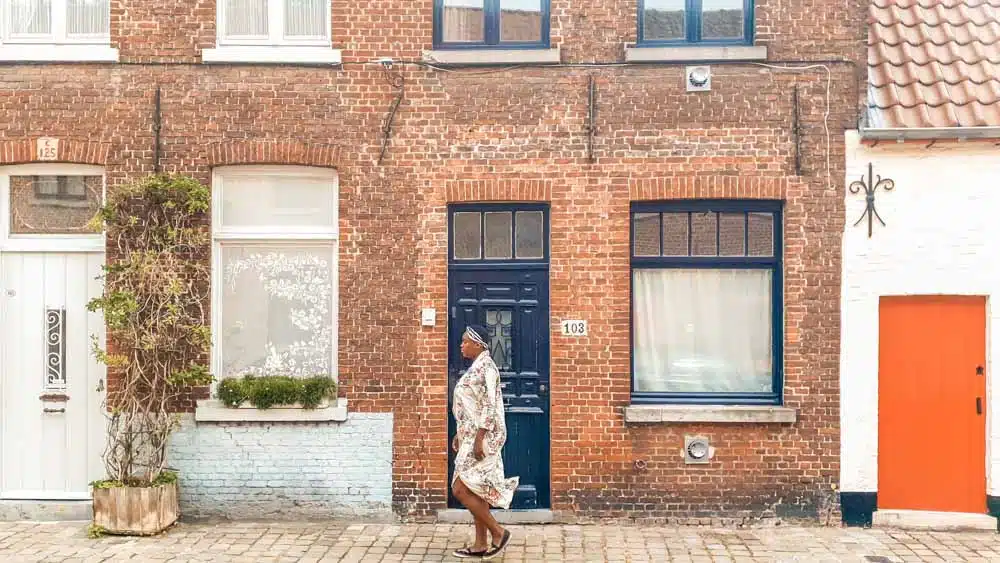
I’ve returned several times since – each time discovering a different side of the city, seeing it during different seasons. Each time coming away with plans for yet another trip.
But this isn’t about me, it’s about you. So you are planning to spend 2 days in Bruges? I’ll bet you have a lot of questions – how to get there, what to see, where to stay…
Don’t worry: I have you covered – the perfect weekend in Bruges itinerary, complete with handy and practical tips to help you plan your trip. Let’s go!
PS: Looking for a more in-depth guide to the best things to see and do in Bruges – read this .
The Perfect Bruges Weekend Break Itinerary
What to do in bruges in 2 days – day one.
I recommend spending the first day of your Bruges city break (or mid-week soiree) checking out some of the main sights in the city centre.
Markt + Belfry of Bruges
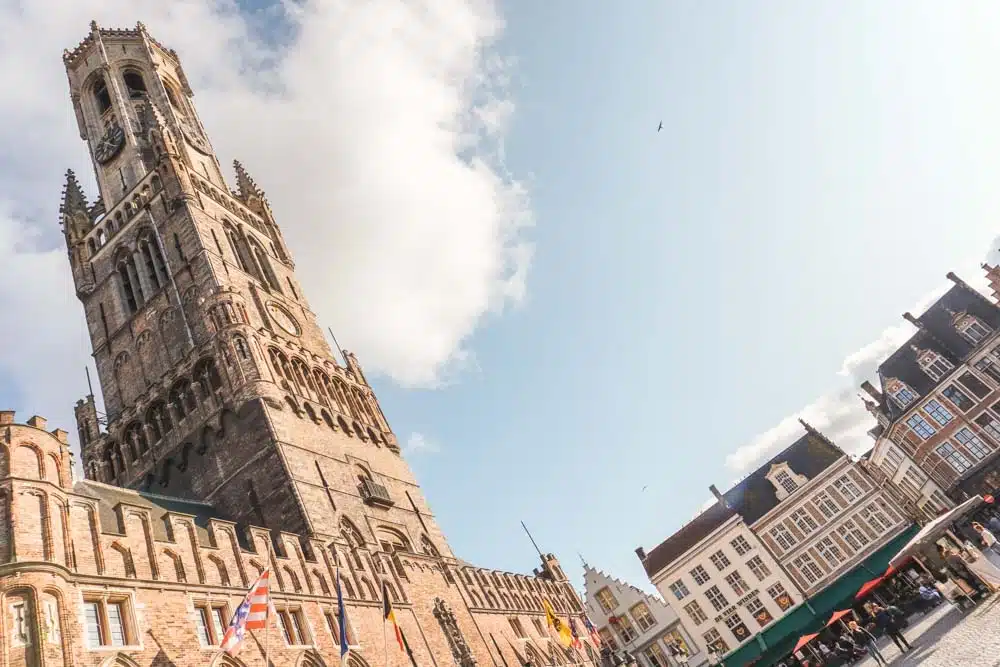
You are not allowed to leave Bruges without checking out Markt and the Belfort – it’s kind of like leaving London without at least glancing at Buckingham Palace.
Markt is a beautiful old square that dates all the way back to the 10th century and has played a central role in the city’s history ever since.
The most famous of all the buildings is the Belfort, an 83-metre tall medieval tower with panoramic views of the city. It’s 366 steps to the top but it’s 1000% worth it for the view.
Other historical buildings on the square include the Provincial Court. Together, the mishmash of architectural styles is an absolute charm.
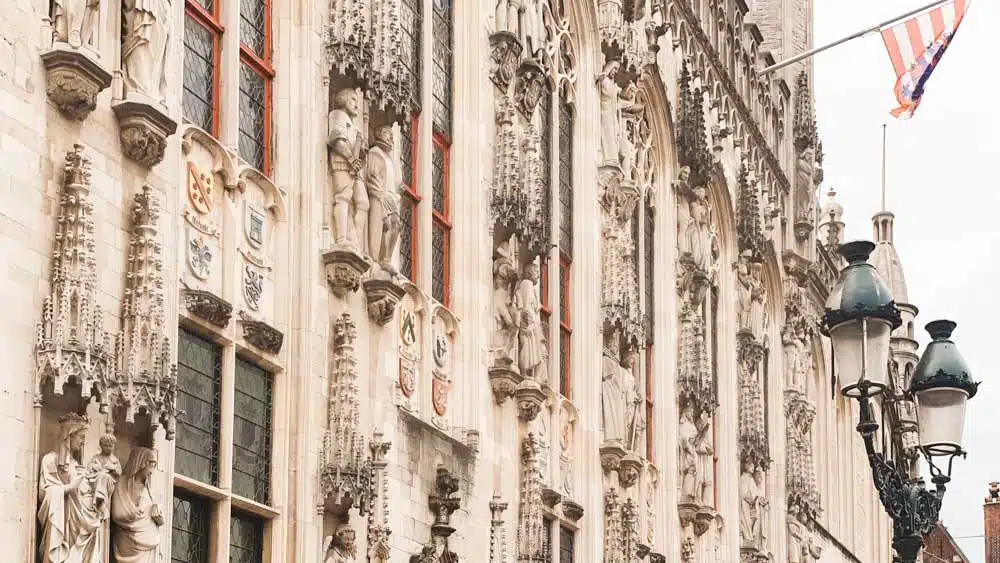
The city’s second most famous but equally beautiful square is Burg, and it’s a must see for your long weekend in Bruges.
It’s historic and atmospheric – no surprise, considering it is believed to have been inhabited since the 2nd Century CE.
The name “Burg” refers to the fortress that once stood on the square, and, while that’s long gone, it’s still home to some of the city’s most important political buildings including Bruges City Hall and the Old Civil Registry.
You’ll also find the Basilica of the Holy Blood on Burg – a chapel housing a relic of holy blood, said to have been brought to the city from the Holy Land in 1150.
Burg is probably my pick for a gorgeous spot to stop and enjoy a coffee during your 2 day break in Bruges.
Quay of the Rosary
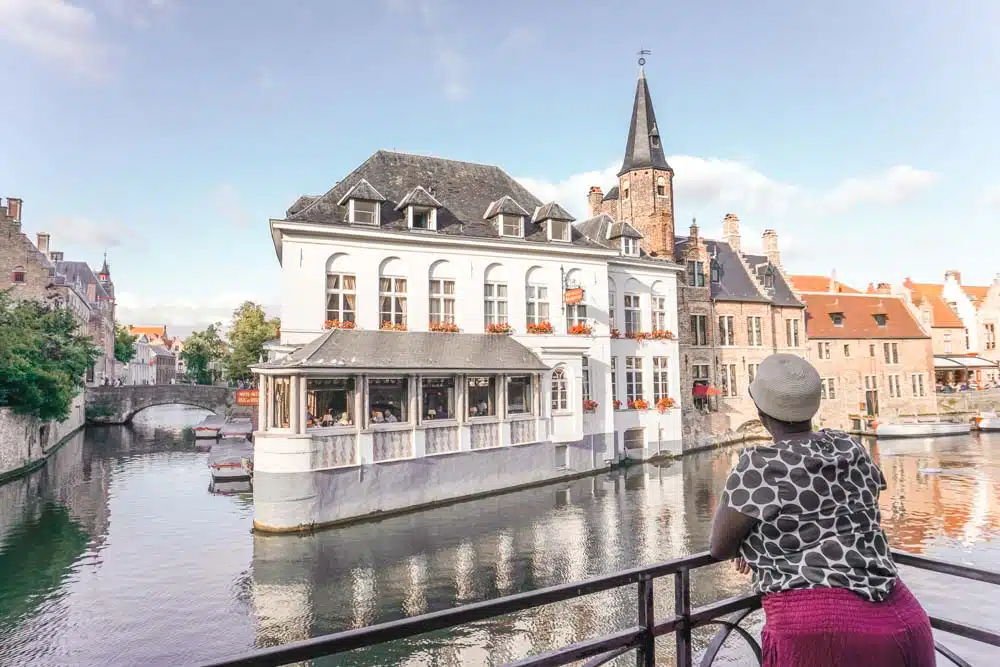
All of Bruges is stupendously pretty, so to be considered a stand-out view it’s got to be pretty spectacular.
That’s what you’ll find with the Quay of the Rosary (Rozenhoedkaai). It’s a gorgeous scene, with canals and historic buildings to make you feel like you’ve been transported back in time.
Make sure you double check your camera battery before you visit.
Hop on a Canal Cruise
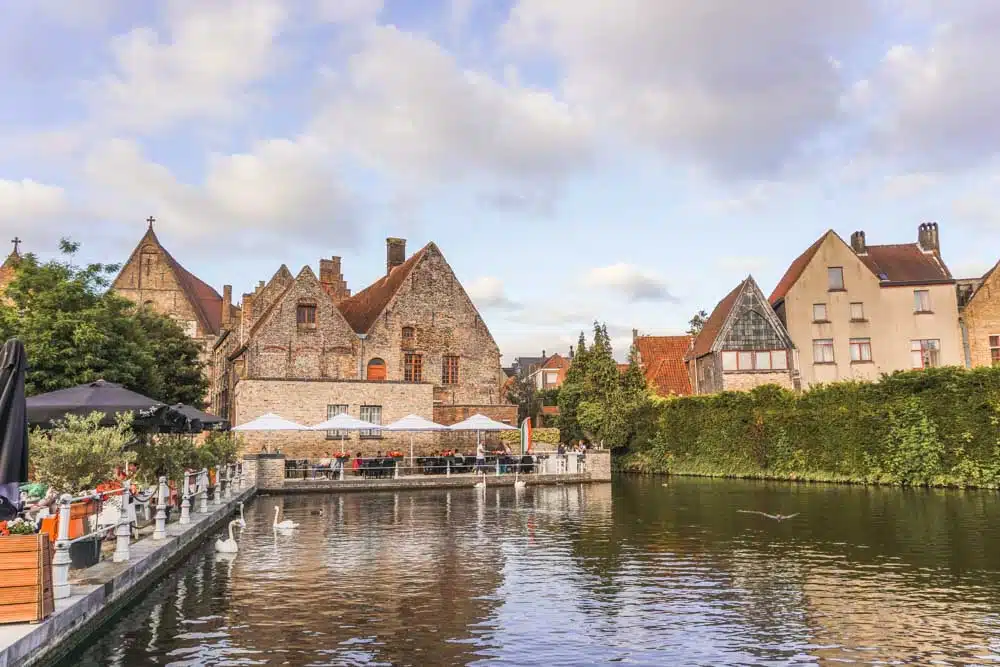
It’s obvious where Bruges gets its nickname “The Venice of the North” from. The canals that once formed an important lifeblood for the city’s trade, now offer visitors the chance to see the city at its very prettiest.
Cruises run between March and November – pick any one of the five landing stages to depart from, hop on and enjoy the half-hour long ride.
Top Tip: Book a Canal Cruise and Guided Walking Tour for an In-Depth Look at the City
Groeninge or Gruuthuse Museum
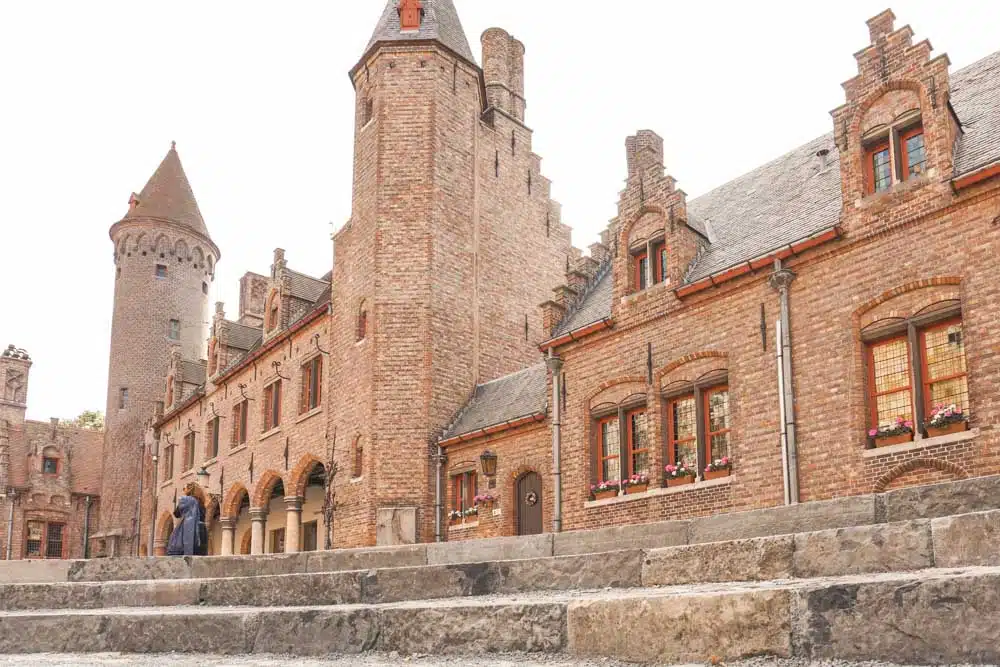
It’s decision time peeps – there are two museums on this side of Bruges and you need to make your decision about which one you want to go to.
The first, The Groeninge Museum , is a walk through Flemish art throughout the centuries, with a heavy focus on art up to the 17th century. I’ve been and can’t say that I found it that thrilling.
The second is the recently-renovated Gruuthuse Museum , where visitors can peek into the life and home of one of Bruges’ former great merchant families, the Van-Brugghe-Van der Aa family.
2be Beer Experience
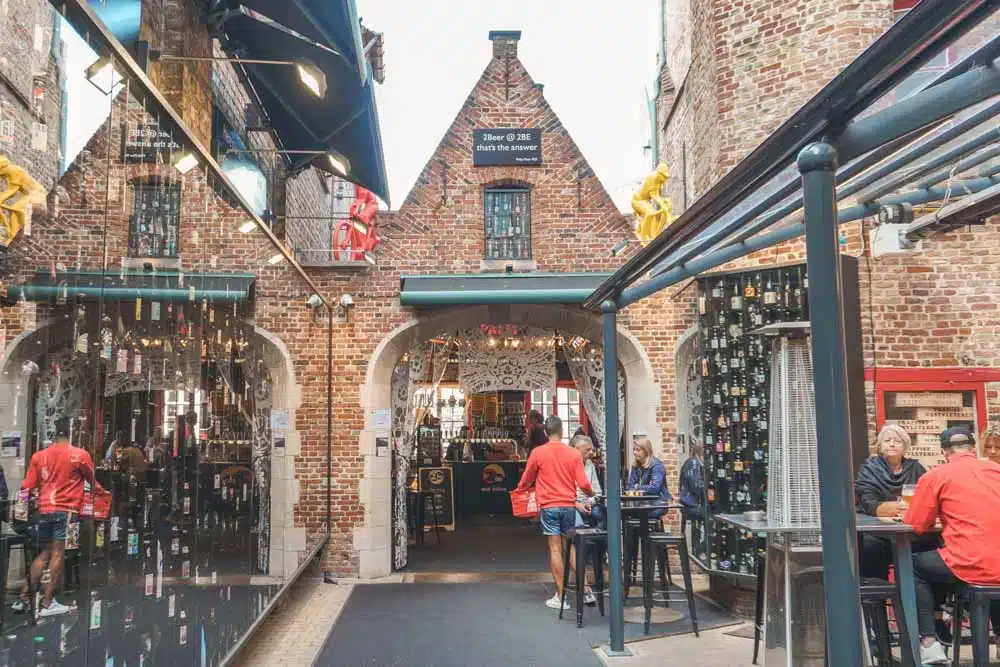
The Belgians do beer really, really well – so you’ve just got to give it a go while you’re enjoying your mid-week or weekend break to Bruges.
Part tasting centre and part museum, you’ll learn everything you need to know about beer here – and then plenty more.
Find out more about the history of beer in Belgium, as well as the intricacies of its production. And then once the learning is over, be sure to enjoy a glass or two.
Another option if you love beer is to take a guided tour of the city’s best breweries . This is a fun way to find out more about the beer scene in Bruges.
Love Belgian Beer? Check out my guide to discovering the best beer in Bruges .
What to do in Bruges in 2 days – Day Two
For the second day on our Bruges weekend break itinerary, I recommend heading out a little bit further to check out some of the city’s hidden gems.
Sint-Janshospitaal
Before the sweetness of Minnewater Park later today, it’s time to take a dark turn and visit Sint-Janshospitaal, one of Bruges’ more unusual attractions.
It’s one of the best preserved Medieval hospitals in Europe, and you can check out some of the old wards.
I swear, nothing will make you more grateful for modern medicine than a visit to this quirky attraction.
Minnewater Park
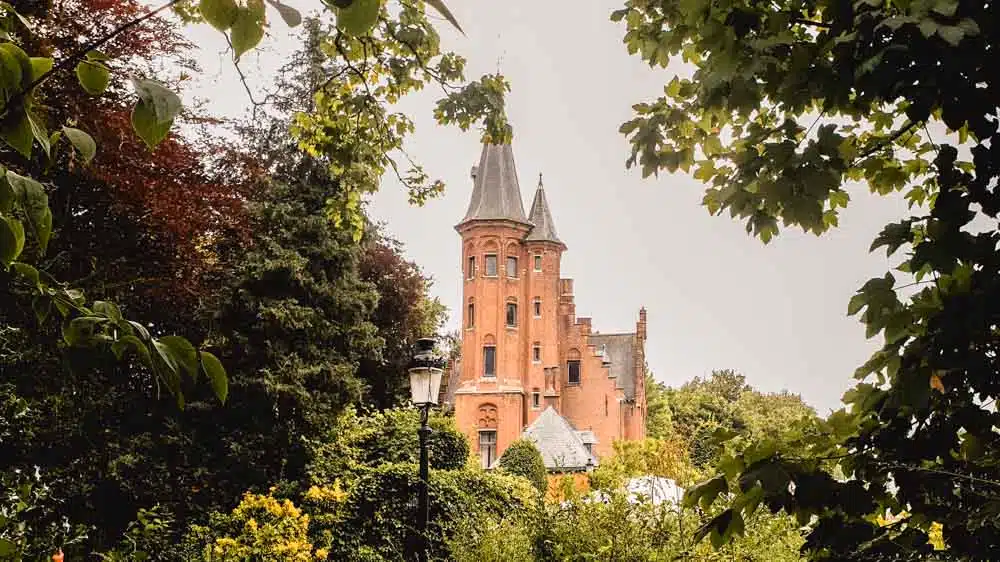
Bruges is all very sappy and romantic, but nowhere more so than Minnewater Park.
There’s a local myth that it’s where two secret lovers met, and it remains a favourite place for romantic strolls.
Of course, you don’t need a partner to enjoy its beauty. You can also head off solo and enjoy the sights, including the beautiful flora and still lake.
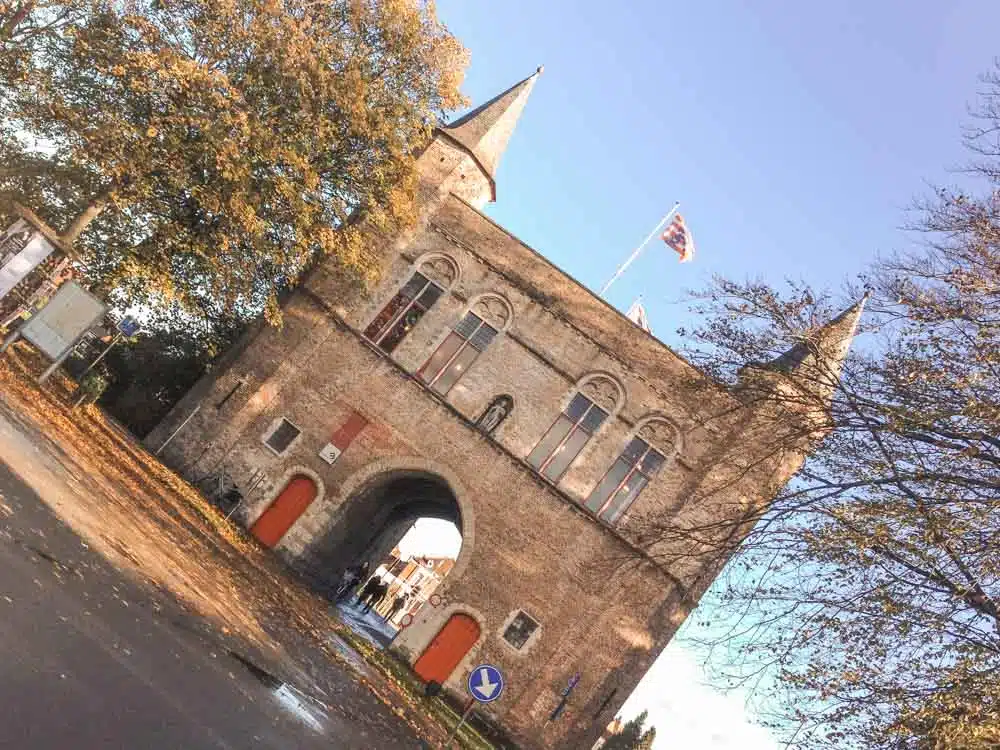
For some more beautiful sights (and to shake off the memories of that medieval medicine), I recommend a stroll around De Vesten – Bruges’ old city ramparts.
They create a large green belt all around the city, which are popular with joggers and walkers.
I particularly love them because along the way there are four beautiful windmills to admire and a couple of the old city gates still stand.
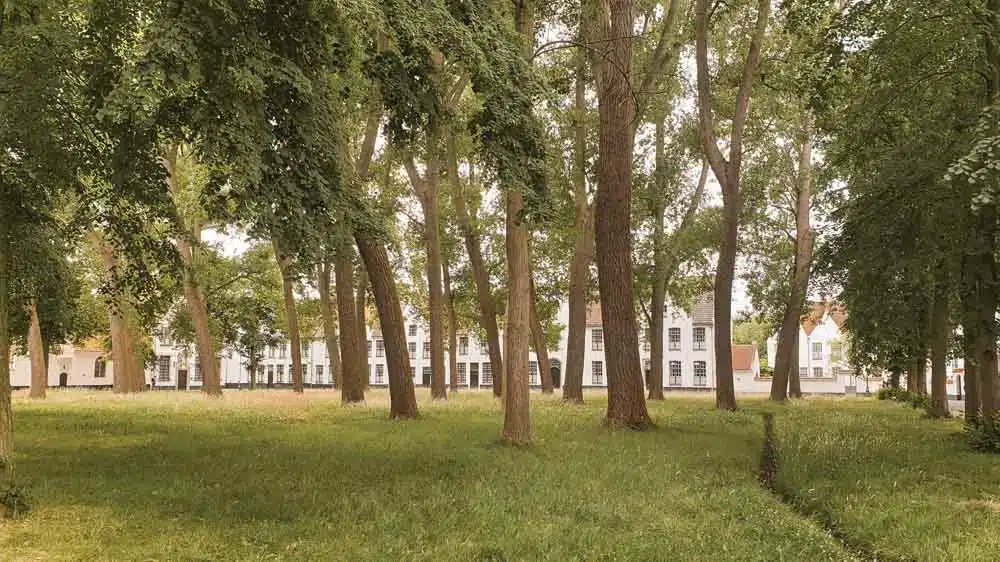
I highly recommend spending some time wandering around Beguinages, one of Bruges’ oldest and most beautiful spots.
The Beiguinages – one of the few remaining left in the country – used to act as a sanctuary for women who opted to live a celibate life, strictly adhering to the rules of the beguines, in exchange for somewhere to live.
Today, the Begijinhof is home to a convent and offers a unique peek into the life of days gone by.
Handy Tips for Planning Your Weekend in Bruges
Should you book an organised tour or book your weekend in bruges independently .
If you’re planning a Bruges weekend away, one of your first decisions is whether to go at it alone or join in an organised tour.
Both options have their merits and really depend on what you’re looking for out of your 2 days in Bruges.
I love travelling solo and have done it all over the world. There’s something so fabulous about answering to no-one and being totally in charge of your own itinerary.
Feel like sleeping in ‘till noon? No one’s there to judge. Planning on spending four hours just at the Frites museum? You do you.
Of course, there are some drawbacks to solo travel – it’s not all as easy as it looks on Instagram .
Solo travel means putting in the hard yards worrying about logistics like what plane to catch and organising tickets to attractions.
By contrast, organised group tours are a great way to maximise what you see during your 48 hours in Bruges. Someone else will take care of the boring stuff, while you just get to explore the city’s sights.
Plus, I love meeting other travellers on tours. It’s never easier to make new friends than when you’re off gallivanting around a new city.
One good compromise can be taking shorter tours or having an independent guide. This way you’ll keep the flexibility and independence of solo travel, while also letting an expert take care of the boring practicalities.
As with any European weekend break , there are many great places to find Bruges city break packages, whether they be all-inclusive tours or just accommodation packages.
Some of my favourites include Love Holidays , Easyjet , Lastminute.com and Expedia – you can also snap up some great savings if you book accommodation and transport through the same site.
Best Way to Travel for a Bruges Mini Break
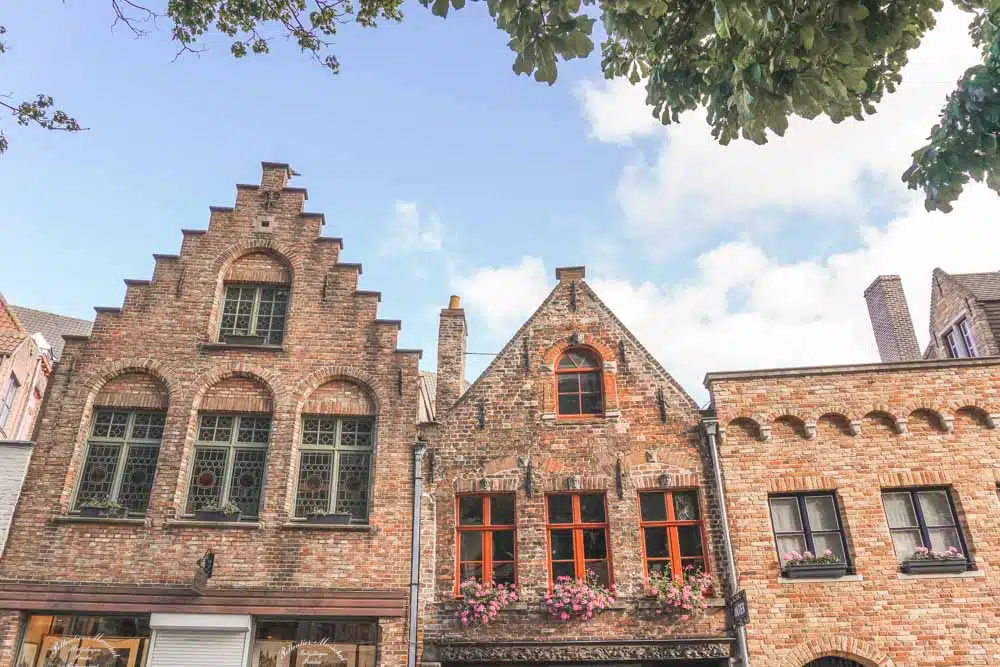
If you’re planning 2 days in Bruges, then I feel it’s safe to assume you’re probably coming from Europe.
In this case, you have a fair few options for how to travel for your Brugge city break.
By Plane
Flying is the obvious choice, and is often quick and easy from other European cities. The nearest airport to Bruges is Ostend-Bruges (often just called ‘Ostend), which is about 25 kilometres away.
Check flights on Skyscanner.
While flying is quick and convenient, there are other options – some of which are a little more carbon neutral.
By Ferry
If you’re nearby and with a vehicle, then driving is a convenient option – particularly if you want to also head to a nearby destination like Ostend or Zebrugge.
If you’re coming from the UK, then there’s a ferry that goes directly to Belgium from Hull, but it is quite long.
Otherwise, you can get a ferry to Dunkirk or Calais from Dover, which are both short drives (less than an hour and a half) from Bruges with DFDS Seaways and P&O Ferries .
By Train
Bruges is well-connected by rail to many European destinations. You can catch trains from Paris, Amsterdam and London (Eurostar) to Brussels and change for the one-hour onward train to Bruges. Use Trainline to check prices and book tickets.
Looking for more information? Read my step-by-step Europe Packing List .
Where to Stay for Your Weekend in Bruges
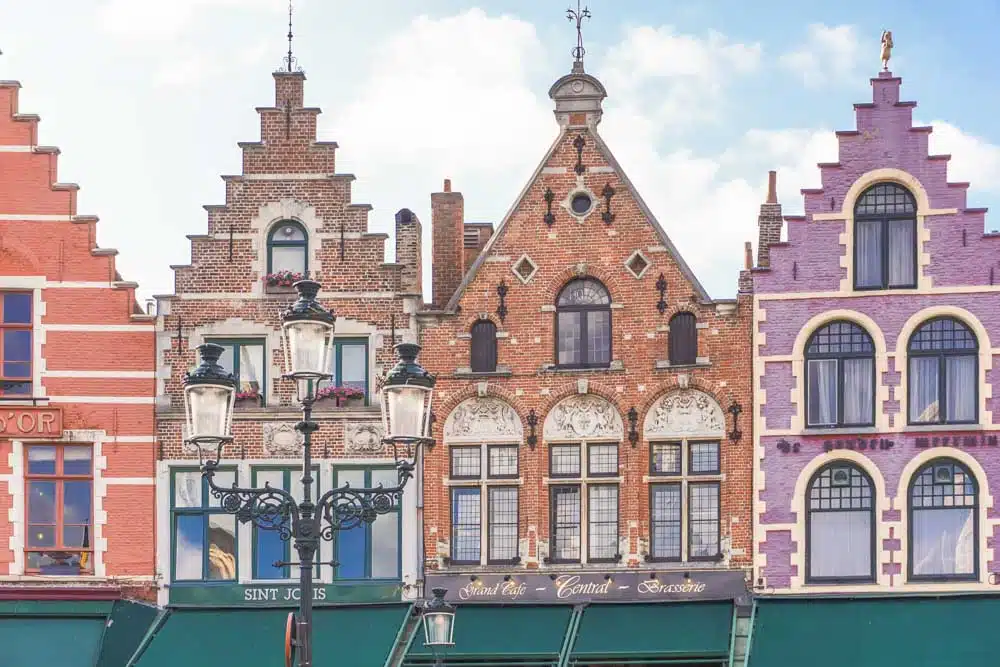
There are a few options for where to stay in Bruges, but I highly recommend going central and staying around Markt or Burg.
This will mean you’re super central for all of the top Bruges attractions, including the city’s best restaurants and bars. Which are an important stop on any city break.
If you’re looking for something a little more budget-friendly or prefer to avoid the crowds, then the neighbourhood of Sint Anna is a little more residential.
The Hotel de Orangerie is one of the best hotels in Bruges, while the Novotel Centrum offers reasonably good value a short walk to the centre of town.I also love using Plum Guide to find places to stay – each property is hand-selected by the staff to ensure only the very best make it onto the site. Think swish, spacious, and light.
Read Next: The Best Places to Stay in Bruges + The Best Airbnbs in Bruges
Useful Resources for Your Bruges Trip
Here are some of my favourite sites to help you plan your weekend trip to Bruges.
- Skyscanner : my favourite platform for finding the fastest and cheapest flights to Bruges. You can even search the whole month to easily compare prices.
- Eurostar : If you are looking to catch the train from the UK to Belgium, then Eurostar is where you need to go. It’s fast, comfortable and safe.
- Rail Europe : If you are planning to visit Bruges from another EU country by train, then you can book your tickets via Rail Europe.
- Booking.com : A popular website to book hotels and accommodation, Booking usually offers the best value of all the major sites.
- Plum Guide : Handpicked, high-quality holiday rentals.
- Hotels.com : Another great option with competitive deals and prices.
- Tripadvisor : I’m sure you’ve heard of this one – the review site to end all review sites. But did you know you can also book hotels and accommodation through the site?
- Get Your Guide : A great website to find activities and tours (from half-day to multiple days) in Bruges.
- Viator : Another option for finding activities and tours in Bruges – Viator is an oldie but a goodie, with lots of choice.
Getting Around Bruges
One of the great things about Bruges is that it’s super easy to get around on foot. Most of the sites are in a pretty compact area, so you won’t be trekking for hours to find the notable spots.
There’s also a good public bus network that travels around the city and to stops including the railway station and airport.
Note that Uber does not operate in Bruges, however there are plenty of taxis that you can flag.
48 Hours in Bruges – Map
Love This? Save and Share on Pinterest!
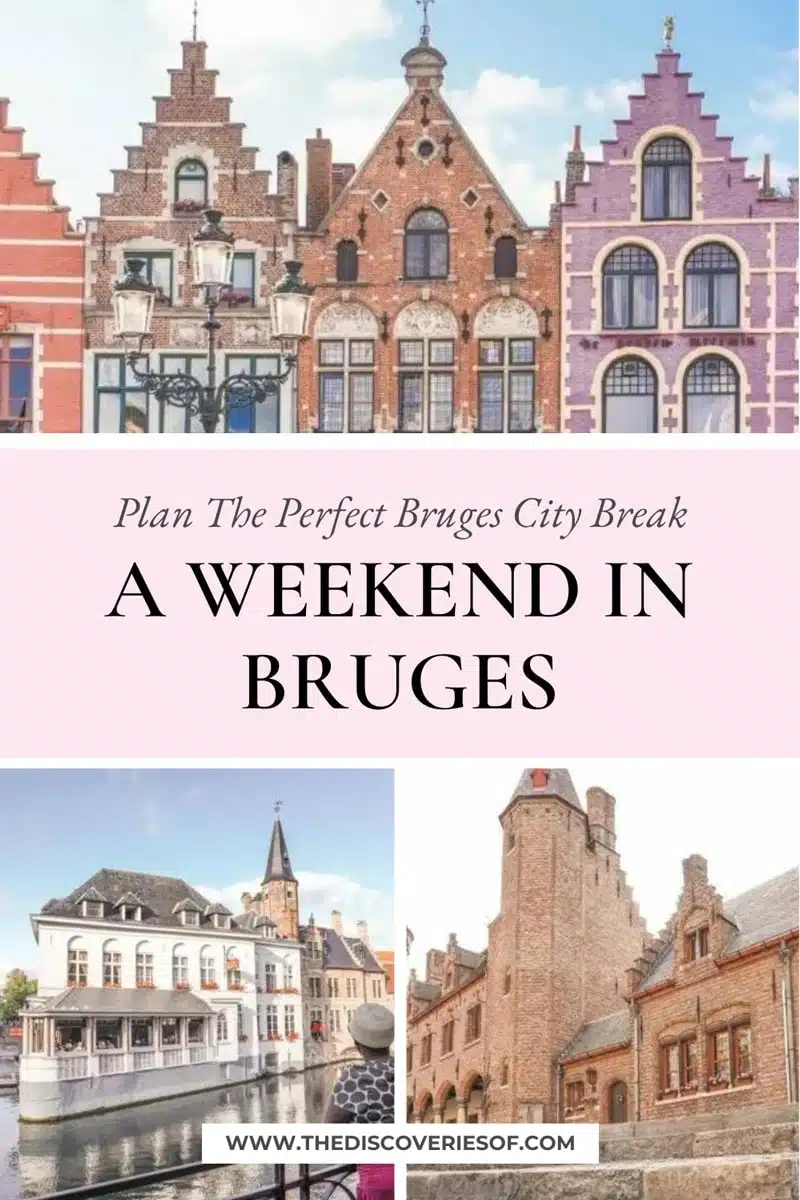
Read More Travel Tips for Your Bruges Weekend Break
- 25 Rather Brilliant Things to do in Bruges
- How to Plan a Day Trip to Bruges
- Where to Stay in Bruges – An Area Guide
- The Best Airbnbs in Bruges
- Bruges Beer Guide
- A Handy Bruges Tourist Map
- Baarle Hertog & Nassau – a day trip from Bruges
I’m Julianna Barnaby - a professional travel writer and geek extraordinaire. I started The Discoveries Of to help you to discover the best of new destinations from around the world.
Discovering new places is a thrill - whether it’s close to home, a new country or continent, I write to help you explore more and explore differently.
Related Posts
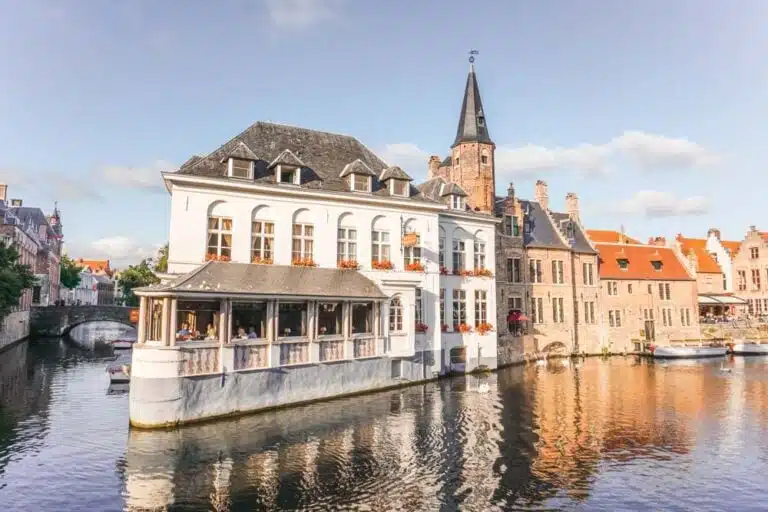
Bruges Map: A Handy Tourist Map of Brugge’s Must-See Attractions
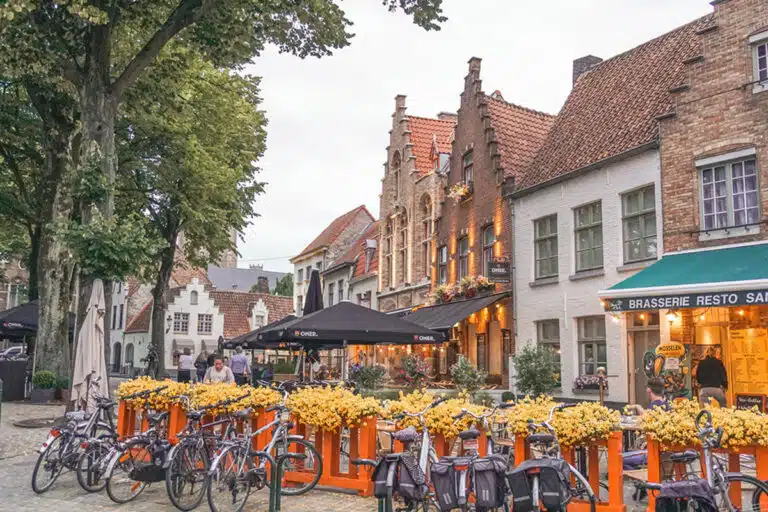
Where to Stay in Bruges: Top Places and Areas for Your Trip
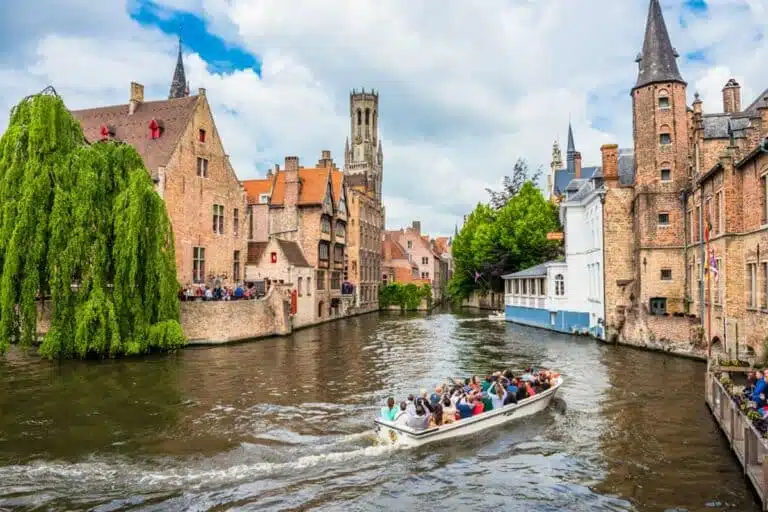
A Day Trip to Bruges: How to Plan + See the Best of Bruges in a Day
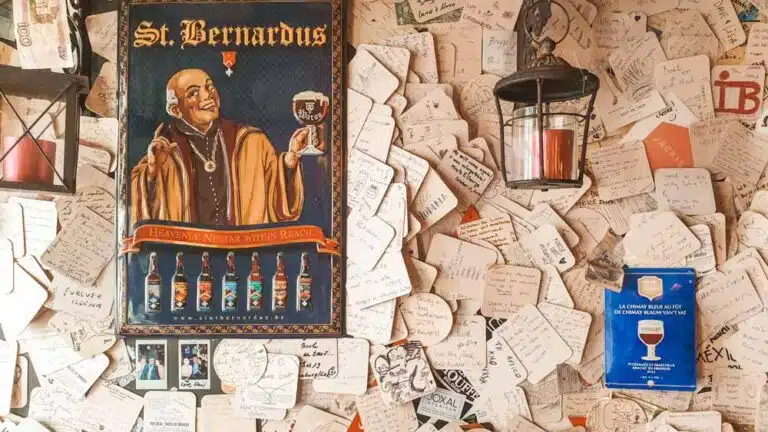
The Bruges Beer Guide: Discovering The City’s Best Beers, Bars + Breweries
Leave a reply cancel reply.
Your email address will not be published. Required fields are marked *

Follow me on Instagram for travel inspiration, tips, and guides.
Turn your dream vacation into reality

One Day in Bruges (Best Itinerary + Map)
- December 26, 2023
One day in Bruges walking itinerary that covers all the tourist attractions (+ a map and tips on how to see Bruges on a day trip).
Bruges (Brugge in Dutch) is one of the most picturesque cities in Europe.
It is the perfect medieval fairytale destination for a weekend trip. Located in northwest Belgium, Bruges is the capital of West Flanders. The city is often called the Venice of the North because it’s crisscrossed by canals.
Charming squares with horse-drawn carriages, and picturesque canals lined with Gothic houses. Is there anything more to ask for?
One day in Bruges itinerary
This self-guided walking tour will show you the best of Bruges in 1 day. The itinerary is designed in such a way, that it’s suitable both for day-trippers and overnight visitors.
In fact, it’s an improved version of my Bruges one day itinerary that I followed when I visited the city in December.
Find a map of this Bruges itinerary (with all attractions and restaurants’ websites) at the end of the article.
Already have a hotel booked? See whether your hotel is in a good area in my guide to the best Bruges hotels on the canal .
One day in Bruges (the best day trip itinerary)
- Start the day with breakfast at That’s Toast!
Visit the Church of Our Lady
- Admire the facade of the Hospital of St. John
- See the most picturesque bridge
Explore the Quay of the Rosary
Eat a waffle at house of waffles, admire the architecture at market square.
- Climb the Belfry
- Visit the City Hall and Liberty of Bruges
- See the famous relic in the Basilica of the Holy Blood
- Finish your one day in Bruges with a beer at ‘t Brugs Beertje
Have breakfast at That’s Toast!
09:00 AM – 10:00 AM Start your day in Bruges with breakfast at That’s Toast! or Li O Lait .
That’s Toast! offers a great variety of savoury and sweet toasts. We tried the Triple Madame and the Triple French toasts. Both were so good, that I regretted we had only 1 day in Bruges and won’t have time for another visit.

If you prefer bagels with eggs for breakfast, then Li O Lait is your place.
10:00 AM – 10:30 AM Church of Our Lady (Onze-Lieve-Vrouwekerk) is a 14th-century church. Its tower is the second-highest brick tower in the world (122.3 metres high).
However, the most famous treasure of the church is the artwork Madonna and Child by Michelangelo. It was the artist’s only sculpture that left Italy before Michelangelo’s death.
The entrance is free, but you have to pay to see the Madonna and Child.

Admire the facade of Hospital of St. John
10:30 AM – 10:50 AM The hospital of St. John (Oud Sint-Janshospitaal) is founded in the 12th century. This makes it one of the oldest surviving hospitals in Europe.
In the Middle Ages, it was a place, where nuns and monks were taking care of sick travellers and pilgrims. The exhibition features surgical and medical instruments as well as various religious artifacts.
Don’t visit the museum unless you’re interested in medieval medicine. Nevertheless, don’t miss to see the building from the outside. It’s a gorgeous red brick building with a lovely inner yard.

See the picturesque Bonifacius Bridge
10:50 AM – 11:10 AM Bonifacius Bridge is one of the most picturesque places in the city. Despite its medieval look, the bridge is rather new dating from the early 20th century.

11:10 AM – 11:40 AM Cross the bridge and continue towards the Quay of the Rosary (Rozenhoedkaai). Quay of the Rosary is the most photographed place in Bruges. Here the Groenerei and Dijver canals meet, creating a strikingly beautiful and romantic scene.

12:00 PM – 02:00 PM A trip to Bruges is not complete without waffles. So for a lunch, stop at House of Waffles . They have an extensive menu of waffles ranging from sweet toppings to heavy savoury options. We tried the ones with caramel and chocolate toppings.

02:00 PM – 02:15 PM Market Square (Markt) is the heart of the Historic centre. A weekly market is held here since 958. The square is dominated by the Belfry tower, surrounded by colourful medieval houses and Gothic buildings.

Climb the Belfry of Bruges
02:15 PM – 03:00 PM Belfry of Bruges (Belfort van Brugge) is one of the most famous belfries in Belgium. During the Middle Ages, the town archives were kept here.
The top of the tower (83m) is accessible by a steep staircase. Be prepared to climb 366 steps to the top. Nevertheless, the view totally worth the effort.

Time for chocolate
03:00 PM – 03:30 PM Oliviers Chocolate Shop & Bar is a must for every chocolate lover. It’s a family-owned chocolate shop that offers more than 60 different chocolates and truffles! Don’t miss to try the hazelnut hot chocolate.
For cramique (traditional Belgian bread) and meringue cakes stop at Aux Merveilleux de Fred . It’s a fine bakery with an incredible chandelier.

Burg Square
03:40 PM – 03:50 PM Burg Square means castle square in Dutch. The square took his name from the castle that Baldwin I, Count of Flanders built here in the 9th century. It was a military fortress used for defence against the Normans.
Visit the City Hall
03:50 PM – 04:10 PM City Hall (Stadhuis) is the most impressive building on Burg Square. And it’s definitely worth to take a peek inside. It is possible to visit the Gothic hall and Historic hall. The entrance fee also includes access to the Liberty of Bruges.

Liberty of Bruges
04:10 PM – 04:25 PM Liberty of Bruges (Brugse Vrije) is the city’s former law court. Today, the building houses the city archives. You can visit only the Renaissance hall where you can see the 16th century Charles V chimneypiece.

See the famous relic in Basilica of the Holy Blood
04:25 PM – 05:00 PM Basilica of the Holy Blood (Basiliek van het Heilig Bloed) initially served as a chapel of the Count of Flanders. It consists of a lower Romanesque church and an upper Gothic church. The latter houses a piece of cloth said to be soaked in the blood of Jesus Christ.
It’s free to visit the lower chapel, but there is an entrance fee to see the artifact.

Dinner at Ribs ‘n Beer
For traditional Belgian food visit Gruuthuse Hof or In Den Wittenkop . Try the Flemish stew with fries or the mussels.
However, if you need a break from the Belgian food, go to Ribs ‘n Beer or Paul’s Boutique Brugge . Ribs ‘n Beer is a little out of the Historic Centre, but believe me, it is worth the walk. The “all you can eat ribs” come in two main variations – grilled and slow-cooked (with different sauces).

I recommend booking a table in advance for all four restaurants.
Have a beer at ‘t Brugs Beertje
Finish the day with a glass of beer at ‘t Brugs Beertje . It’s an authentic beer pub with an excellent range of beers (over 300). If you like fruit beers, try Kasteel Rouge.
More ideas for your 1 day in Bruges
If you have more time, check out these tourist attractions.
Take a canal boat tour
See this magnificent city from a different angle by taking a boat tour. The canal boats run from March till the end of October. During the winter, the boats run only during the weekends (if the weather is not freezing). The trip lasts about 30min and costs €10 (only cash).
There are several companies to choose from. The starting points are Huidenvettersplein 13, Rozenhoedkaai, Wollestraat 32, Nieuwstraat 11 and Katelijnestraat 4.
Take a rickshaw tour
If you’re not into boats, take a rickshaw tour . It’s a great way to explore the city. Plus, the tour includes places that can’t be reached by boat.
Saint Saviour’s Cathedral
Saint Saviour’s Cathedral (Sint-Salvatorskathedraal) is the city’s oldest parish church. It’s a huge cathedral with beautifully coloured stained glass windows. Also, the church features a rich collection of Flemish paintings.

Lake of Love
Lake of Love (Minnewater) is a lovely park area with a lake, willow trees and swans. It’s the most peaceful and serene place in the city. Minnewater is perfect for a stroll or picnics. However, if you’re visiting the city in the winter, you’d better skip it.
Choco-Story
If you’re interested in the history of chocolate and the methods of its preparation, then visit the Chocolate Museum. There are free chocolate samples and a chocolate-making demonstration at the end of the tour. Please note that the museum closes at 5 PM.
You can book tickets in advance here .
Torture Museum
Torture Museum (Foltermuseum De Oude Steen) is housed in one of the oldest prisons in Europe! The unique exhibition is quite shocking and intriguing. You can see on display all kinds of torture instruments and devices.

Getting around in Bruges
You can find a detailed map of the itinerary here .
The historic centre is quite small and walkable. You won’t need public transport at all. You can download a city map here .
How to get to Bruges
Bruges is easily accessible by train from Brussels, Ghent or any major European city. The Central train station is about a 15min walk from the Historic centre. You can check timetables and book tickets online at SNCB official site .
If you’re arriving by car it’s best to leave it on the outskirts of the city. Many shopping streets are car-free during the weekends. The most convenient parking is at the Central train station (Chantrellstraat 42-62).
If you’re arriving from Brussels Airport, there is a direct train from the airport to Bruges. The journey is about 90min and it costs about €20.
Another option is by bus. FlixBus has several direct buses every day from the airport to Bruges. The journey is 2 hours, but the prices start at €5. The bus stops at Bargeplein, which is right next to the Central train station.
If you’re arriving from the Brussels South Charleroi Airport, there is only one direct option. The Flibco shuttle bus takes you directly to Bruges (2h journey).
Day trips from Bruges
If you’re interested in WWI this is a must. There were three major battles here and the city was almost completely destroyed in WWI.
How to get to Ypres There is no direct train, so I recommend going by car or taking an organized tour.
Great War Flanders Fields Tour is the best option (for an organized tour). What I like about it is that the groups are small and the guide is very knowledgeable. The tour also includes the Menin Gate Memorial and the iconic poppy fields of Flanders.

Ghent is a small medieval city with a gorgeous castle. It’s a perfect destination for a day trip (find more information in my itinerary for a day trip to Ghent ).
How to get to Ghent The fastest way to get there is by train (20min journey). Take a train from Bruges train station to Gent-Sint-Pieters train station. From there you can take the tram (line 1) or walk 2km to the city centre.
It will take you about 50min by car.

Brussels is the capital city of Belgium. Again, it’s easier to get there by train (1h journey). Brussels can be done in a day (for the best experience follow my 1 day itinerary in Brussels ).
However, I would recommend you to stay at least one night. There are some interesting museums to visit and a lot of great restaurants. Plus, it’s a lot bigger than Bruges.
How to get to Brussels Take a train from Bruges train station to Brussels Central train station. From there it’s a short walk to the historic attractions.
Antwerp is a medieval port city with a stunning cathedral. It’s a 1h 30min journey by train. It’s a better day trip from Brussels, but it can be done from Bruges, too.
If you plan to stay overnight, check out the best hotels in Antwerp city centre .
How to get to Antwerp Take a train from Bruges train station to Antwerp train station. The city centre is within walking distance from there.
How many days in Bruges
Is one day in bruges enough.
1 day in Bruges is completely enough to explore its historic centre. If you follow this itinerary you can cover the main attractions only in a day.
Nevertheless, it’s worth staying at least one night to see the city at night time. The historic buildings are beautifully illuminated in the evenings. Plus, you can enjoy peaceful tranquillity and long walks along the canals.
If you plan to visit Bruges on a day trip from Brussels, take an early train at around 8 AM. There are trains every 20min and the journey is about an hour.
If you plan a trip around Belgium, divide your time between Brussels and Bruges. For example, stay 2-3 nights in each city. Then from Brussels, you can take a day trip to Antwerp. And you can easily reach Ghent from Bruges.
Best time to visit Bruges
Bruges is a very popular European destination for a weekend or day trip. Plus, the city is especially busy on weekends. Thus, if possible choose the weekdays for your vacation.
For sunny and warm weather, visit the city from May to September. The busiest period is July, August and of course Easter and Christmas.
Winters are not very cold with short daylight hours. During my visit in December, it was almost dark at 4 PM and the sun was rising after 8 AM. Nevertheless, December is a great time to visit Bruges because of the Christmas markets.
Practical information about Bruges
Belgium is a part of the Schengen Agreement (the European border-free area). So you don’t need a Belgium visa, but rather a Schengen visa. If your country is part of the Schengen Agreement, you’ll need only a valid passport or ID card.
The official currency of Belgium is the Euro. Although credit cards (mostly Visa and Mastercard) are widely accepted in Bruges, you’ll need cash. The smaller restaurants and merchants take only cash. Also, American Express is not popular and not accepted in most places.
Belgium has three official languages – French, German, and Dutch. Bruges is located in the Flemish Region of the country (the Dutch-speaking part of Belgium). However, most of the people are fluent in English, too.
Belgium operates on a 230V supply voltage and 50Hz. The associated plug types are C and E.

Follow now for exclusive content
About the author
The rickshaw tour we took was the perfect way to see the city. Our guide was very knowledgeable and happy to answer any questions!
Hi Hazel, Totally agree with you! The rickshaw tour is the best way to see the city.
I don’t see the “day in Brugge” map you refer to in your article… Where May of find that?
It is right at the beginning of the section – Getting around in Bruges (the first sentence after this title). Here is a direct link to the map , in case you still can’t find it.
Bonjour, hello Milena,
If you had to choose between doing a day in Bruges or doing a day in Ghent, which one would you choose and why? We will be coming from brussels. Thanks in advance!
Hi Christine,
If I had to choose between Ghent and Bruges, I’d definitely choose Bruges. The city is much prettier and more charming than Ghent with many beautiful buildings. In addition, Bruges offers more memorable attractions and the food is better.
Leave a Reply Cancel Reply
Your email address will not be published. Required fields are marked *
Name *
Email *
Add Comment *
I accept the privacy policy
Post Comment
Bruges Travel Guide
Book your individual trip , stress-free with local travel experts
- roughguides.com
- Travel guide
- Local Experts
- Travel Advice
- Accommodation
Plan your tailor-made trip with a local expert
Book securely with money-back guarantee
Travel stress-free with local assistance and 24/7 support
“Somewhere within the dingy casing lay the ancient city,” wrote Graham Greene of BRUGES , “like a notorious jewel, too stared at, talked of, and trafficked over”. And it’s true that Bruges’s reputation as one of the most perfectly preserved medieval cities in western Europe has made it the most popular tourist destination in Belgium, packed with visitors throughout the season. Inevitably, the crowds tend to overwhelm the city, but you’d be mad to come to Flanders and miss the place: its museums hold some of the country’s finest collections of Flemish art, and its intimate, winding streets, woven around a skein of narrow canals and lined with gorgeous ancient buildings, live up to even the most inflated tourist hype. See it out of season, or in the early morning before the hordes have descended, and it can be memorable – though not so much on Mondays, when many of the sights are closed.
Jan van Eyckplein
Kantcentrum & jeruzalemkerk, onze lieve vrouwekerk, st-salvatorskathedraal, the groeninge museum, the hospitaalmuseum and the memling collection.
The obvious place to start an exploration of the city is in the two principal squares: the Markt , overlooked by the mighty belfry, and the Burg , flanked by the city’s most impressive architectural ensemble. Almost within shouting distance, along the Dijver, are the three main museums, among which the Groeninge offers a wonderful sample of early Flemish art. Another short hop brings you to St Janshospitaal and the important paintings of the fifteenth-century artist Hans Memling , as well as Bruges’s most impressive churches, the Onze Lieve Vrouwekerk and St-Salvatorskathedraal .
Further afield, the gentle canals and maze-like cobbled streets of eastern Bruges – stretching out from Jan van Eyckplein – are extraordinarily pretty. The most characteristic architectural feature is the crow-step gable, popular from the fourteenth to the eighteenth century and revived by the restorers of the 1880s and later, but there are also expansive Georgian-style mansions and humble, homely cottages. There are one or two obvious targets here, principally the Kantcentrum (Lace Centre), where you can buy locally made lace and watch its manufacture, and the city’s most unusual church, the adjacent Jeruzalemkerk . Above all, however, eastern Bruges excels in the detail, surprising the eye again and again with its sober and subtle variety, featuring everything from intimate arched doorways and bendy tiled roofs to wonky chimneys and a bevy of discrete shrines and miniature statues.
Brief history
Bruges started out as a ninth-century fortress built by the warlike first count of Flanders, Baldwin Iron Arm , who was intent on defending the Flemish coast from Viking attack. The settlement prospered, and by the fourteenth century it shared effective control of the cloth trade with its two great rivals, Ghent and Ypres (now Ieper), turning high-quality English wool into clothing that was exported all over the known world. An immensely profitable business, it made the city a focus of international trade, and at its peak the town was a key member of – and showcase for the products of – the Hanseatic League , the most powerful economic alliance in medieval Europe. Through the harbours and docks of Bruges, Flemish cloth and Hansa goods were exchanged for hogs from Denmark, spices from Venice, hides from Ireland, wax from Russia, gold and silver from Poland and furs from Bulgaria. The business of these foreign traders was protected by no fewer than 21 consulates, and the city developed a wide range of support services, including banking, money-changing, maritime insurance and an elementary shipping code, known as the Roles de Damme .
Despite (or perhaps because of) this lucrative state of affairs, Bruges was dogged by war . Its weavers and merchants were dependent on the goodwill of the kings of England for the proper functioning of the wool trade, but their feudal overlords, the counts of Flanders, and their successors, the dukes of Burgundy (from 1384), were vassals of the rival king of France . Although some of the dukes and counts were strong enough to defy their king, most felt obliged to obey his orders and thus take his side against the English when the two countries were at war. This conflict of interests was compounded by the designs the French monarchy had on the independence of Bruges itself. Time and again, the French sought to assert control over the cities of West Flanders, but more often than not they encountered armed rebellion. In Bruges, Philip the Fair precipitated the most famous insurrection at the beginning of the fourteenth century. Philip and his wife, Joanna of Navarre, had held a grand reception in Bruges, but it had only served to feed their envy. In the face of the city’s splendour, Joanna moaned, “I thought that I alone was Queen, but here in this place I have six hundred rivals”. The opportunity to flex royal muscles came shortly afterwards when the city’s guildsmen flatly refused to pay a new round of taxes. Enraged, Philip dispatched an army to restore order and garrison the town, but at dawn on Friday May 18, 1302, a rebellious force of Flemings crept into the city and massacred Philip’s sleepy army – an occasion later known as the Bruges Matins : anyone who couldn’t correctly pronounce the Flemish shibboleth schild en vriend (“shield and friend”) was put to the sword. There is a statue celebrating the leaders of the insurrection – Jan Breydel and Pieter de Coninck – in the Markt.
The Habsburgs , who inherited Flanders – as well as the rest of present-day Belgium and Holland in 1482 – whittled away at the power of the Flemish cities, no one more so than Charles V , the ruler of a vast kingdom that included the Low Countries and Spain. As part of his policy, Charles favoured Antwerp at the expense of Flanders, and to make matters worse, the Flemish cloth industry began its long decline in the 1480s. Bruges was especially badly hit and, as a sign of its decline, failed to dredge the silted-up River Zwin , the town’s trading lifeline to the North Sea. By the 1510s, the stretch of water between Sluis and Damme was only navigable by smaller ships, and by the 1530s the city’s sea trade had collapsed completely. Bruges simply withered away, its houses deserted, its canals empty and its money spirited north with the merchants.
Some four centuries later, Georges Rodenbach ’s novel Bruges-la-Mort e alerted well-heeled Europeans to the town’s aged, quiet charms, and Bruges – frozen in time – escaped damage in both world wars to emerge as the perfect tourist attraction.
Tailor-made travel itineraries for Belgium, created by local experts

8 days / from 2808 USD
The best of the Netherlands and Belgium
This trip will bring you the best of two countries: the Netherlands and Belgium. From the quaint streets, canals and windmills of Holland to beer and Belgium chocolate tasting in three beautiful Belgium cities. This trip has it all.

9 days / from 3024 USD
Experience the Liberation Route in BeNeLux
Explore the path of the World War II Liberation Route through Belgium, Luxembourg and the Netherlands. Visit important landmarks and museums on the way with this self drive itinerary, with enough time to explore cities such as Brussels and Rotterdam on the way.

10 days / from 5616 USD
Taste of Three - Belgium, France and Switzerland
Start your journey in Belgium and explore Brussels, Ghent and Bruges. A high-speed train will then take you to Strasbourg, from where you'll discover the Alsace. Proceed to Basel as your base, from where you'll see plenty of Switzerland: Zermatt, Matterhorn, Mount Pilatus and much more.
Jan van Eyckplein , a five-minute walk north of the Markt, is one of the prettiest squares in Bruges, its cobbles backdropped by the easy sweep of the Spiegelrei canal. The centrepiece of the square is an earnest statue of Van Eyck , erected in 1878, whilst on the north side is the Tolhuis , whose fancy Renaissance entrance is decorated with the coat of arms of the dukes of Luxembourg, who long levied tolls here. The Tolhuis dates from the late fifteenth century, but was extensively remodelled in medieval style in the 1870s, as was the Poortersloge (Merchants’ Lodge), whose slender tower pokes up above the rooftops on the west side of the square. Theoretically, any city merchant was entitled to be a member of the Poortersloge, but in fact membership was restricted to the richest and the most powerful. An informal alternative to the Town Hall, it was here that key political and economic decisions were taken – and this was also where local bigwigs could drink and gamble discreetly.
Beyond the east end of the Spiegelrei canal is an old working-class district, whose low brick cottages surround a substantial complex of buildings that originally belonged to the wealthy Adornes family, who migrated here from Genoa in the thirteenth century. Inside the complex, the Kantcentrum (Lace Centre), on the right-hand side of the entrance, has a busy workshop and offers very informal demonstrations of traditional lacemaking in the afternoon (no set times). They sell the stuff too – both here and in the shop at the ticket kiosk – but it isn’t cheap: a smallish Bruges table mat, with two swans, for example, costs €20–25; if you fancy having a go yourself, the shop sells all the gubbins.
Across the passageway from the Kantcentrum is one of the city’s real oddities, the Jeruzalemkerk (Jerusalem Church; same times & ticket as the Kantcentrum), which was built by the Adornes family in the fifteenth century as an approximate copy of the Church of the Holy Sepulchre in Jerusalem after one of their number, Pieter, had returned from a pilgrimage to the Holy Land. The interior is on two levels: the lower one is dominated by a large and ghoulish altarpiece, decorated with skulls and ladders, in front of which is the black marble tomb of Anselm Adornes, the son of the church’s founder, and his wife Margaretha. There’s more grisliness at the back of the church, where the small vaulted chapel holds a replica of Christ’s tomb – you can glimpse the imitation body down the tunnel behind the iron grating. To either side of the main altar, steps ascend to the choir, which is situated right below the eccentric, onion-domed lantern tower.
Next door to the Gruuthuse, the Onze Lieve Vrouwekerk is a rambling shambles of a building, a clamour of different dates and styles whose brick spire is – at 122m – one of the tallest in Belgium. Entered from the south, the nave was three hundred years in the making, an architecturally discordant affair, whose thirteenth-century grey-stone central aisle is the oldest part of the church. The central aisle blends in with the south aisle, but the later, fourteenth-century north aisle doesn’t mesh at all – even the columns aren’t aligned. This was the result of changing fashions, not slapdash work: the High Gothic north aisle was intended to be the start of a complete remodelling of the church, but the money ran out before the work was finished.
In the south aisle is the church’s most acclaimed objet d’art, a delicate marble Madonna and Child by Michelangelo . Purchased by a Bruges merchant, this was the only one of Michelangelo’s works to leave Italy during the artist’s lifetime and it had a significant influence on the painters then working in Bruges, though its present setting – beneath gloomy stone walls and set within a gaudy Baroque altar – is hardly prepossessing.
Michelangelo apart, the most interesting part of the church is the chancel beyond the black and white marble rood screen. Here you’ll find the mausoleums of Charles the Bold and his daughter Mary of Burgundy, two exquisite examples of Renaissance carving, their side panels decorated with coats of arms connected by the most intricate of floral designs. The royal figures are enhanced in the detail, from the helmet and gauntlets placed gracefully by Charles’s side to the pair of watchful dogs nestled at Mary’s feet. Oddly enough, the hole dug by archeologists beneath the mausoleums during the 1970s to discover who was actually buried here was never filled in, so you can see Mary’s coffin, the urn containing the heart of her son and the burial vaults of several unknown medieval dignitaries, three of which have now been moved across to the Lanchals Chapel.
Just across the ambulatory from the mausoleums is the Lanchals Chapel , which holds the imposing Baroque gravestone of Pieter Lanchals, a one-time Habsburg official who had his head lopped off by the citizens of Bruges for corruption in 1488. In front of the Lanchals gravestone are three relocated medieval burial vaults , each plastered with lime mortar. The inside walls of the vaults sport brightly coloured grave frescoes , a type of art which flourished hereabouts from the late thirteenth to the middle of the fifteenth century. The iconography is fairly consistent, with the long sides mostly bearing one, sometimes two, angels apiece, and most of the angels are shown swinging thuribles (the vessels in which incense is burnt during religious ceremonies). Typically, the short sides show the Crucifixion and a Virgin and Child. The background decoration is more varied with crosses, stars and dots all making appearances as well as two main sorts of flower – roses and bluebells. The frescoes were painted freehand and executed at great speed – Flemings were then buried on the day they died – hence the delightful immediacy of the work.
The earthly remains of Mary of Burgundy and Charles the Bold
The last independent rulers of Flanders were Charles the Bold , the Duke of Burgundy, and his daughter Mary of Burgundy , both of whom died in unfortunate circumstances, Charles during the siege of the French city of Nancy in 1477, she after a riding accident in 1482, when she was only 25. Mary was married to Maximilian , a Habsburg prince and future Holy Roman Emperor, who inherited her territories on her death – thus, at a dynastic stroke, Flanders was incorporated into the Habsburg empire.
In the sixteenth century, the Habsburgs relocated to Spain, but they were keen to emphasize their connections with – and historical authority over – Flanders, one of the richest parts of their expanding empire. Nothing did this quite as well as the ceremonial burial – or reburial – of bits of royal body. Mary was safely ensconced in Bruges’s Onze Lieve Vrouwekerk, but the body of Charles was in a makeshift grave in Nancy . The Emperor Charles V, the great grandson of Charles the Bold, had – or thought he had – this body exhumed and carried to Bruges, where it was reinterred next to Mary. There were, however, persistent rumours that the French, the traditional enemies of the Habsburgs, had deliberately handed over a dud skeleton, specifically one of the knights who died in the same engagement. In the 1970s, archeologists had a bash at solving the mystery. They dug beneath Charles and Mary’s mausoleums in the Onze Lieve Vrouwekerk , but, among the assorted tombs, they failed to authoritatively identify either the body or even the tomb of Charles; Mary proved more tractable, with her skeleton confirming the known details of her hunting accident. Buried alongside her also was the urn which contained the heart of her son, Philip the Fair, placed here in 1506.
From St Janshospitaal, it’s a couple of minutes’ walk north to St-Salvatorskathedraal (Holy Saviour Cathedral) a bulky Gothic edifice that mostly dates from the late thirteenth century, though the ambulatory was added some two centuries later. A parish church for most of its history, it was only made a cathedral in 1834 following the destruction of St Donatian’s by the French. This change of status prompted lots of ecclesiastical rumblings – nearby Onze Lieve Vrouwekerk was bigger and its spire higher – and when part of St Salvators went up in smoke in 1839, the opportunity was taken to make its tower higher and grander in a romantic rendition of the Romanesque style.
Recently cleaned, the cathedral’s nave has emerged from centuries of accumulated grime, but it remains a cheerless, cavernous affair. The star turn is the set of eight paintings by Jan van Orley displayed in the transepts. Commissioned in the 1730s, the paintings were used for the manufacture of a matching set of tapestries from a Brussels workshop and, remarkably enough, these have survived too and hang in sequence in the choir and nave. Each of the eight scenes is a fluent, dramatic composition featuring a familiar episode from the life of Christ – from the Nativity to the Resurrection – complete with a handful of animals, including a remarkably determined Palm Sunday donkey. The tapestries are actually mirror images of the paintings as the weavers worked with the rear of the tapestries uppermost on their looms; the weavers also had sight of the tapestry paintings – or rather cartoon copies, as the originals were too valuable to be kept beside the looms.
Entered from the nave, the cathedral Schatkamer occupies the adjoining neo-Gothic chapter house, whose nine rooms are packed with ecclesiastical tackle, from religious paintings and statues through to an assortment of reliquaries, vestments and croziers. The labelling is poor, however, so it’s a good idea to pick up the English-language mini-guide at the entrance. Room B holds the treasury’s finest painting, a gruesome, oak-panel triptych, The Martyrdom of St Hippolytus , by Dieric Bouts (1410–1475) and Hugo van der Goes (d. 1482). The right panel depicts the Roman Emperor Decius, a notorious persecutor of Christians, trying to persuade the priest Hippolytus to abjure his faith. He fails, and in the central panel Hippolytus is pulled to pieces by four horses.
From the east side of the Markt, Breidelstraat leads through to the city’s other main square, the Burg , named after the fortress built here by the first count of Flanders, Baldwin Iron Arm, in the ninth century. The fortress disappeared centuries ago, but the Burg long remained the centre of political and ecclesiastical power with the Stadhuis (which has survived) on one side and St-Donaaskathedraal (which hasn’t) on the other. The French army destroyed the cathedral in 1799 and although the foundations were laid bare in the 1950s, they were promptly re-interred – they lie in front of and underneath the Crowne Plaza Hotel .
The southern half of the Burg is fringed by the city’s finest group of buildings, beginning on the right with the Heilig Bloed Basiliek (Basilica of the Holy Blood) named after the holy relic that found its way here in the Middle Ages. The church divides into two parts. Tucked away in the corner, the lower chapel is a shadowy, crypt-like affair, originally built at the beginning of the twelfth century to shelter another relic, that of St Basil, one of the great figures of the early Greek Church. The chapel’s heavy and simple Romanesque lines are decorated with just one relief, carved above an interior doorway and showing the baptism of Basil in which a strange giant bird, representing the Holy Spirit, plunges into a pool of water.
Next door, approached up a wide, low-vaulted curving staircase, the upper chapel was built a few years later, but has been renovated so frequently that it’s impossible to make out the original structure; it also suffers from excessively rich nineteenth-century decoration. The building may be disappointing, but the large silver tabernacle that holds the rock-crystal phial of the Holy Blood is simply magnificent, being the gift of Albert and Isabella of Spain in 1611. One of the holiest relics in medieval Europe, the phial of the Holy Blood purports to contain a few drops of blood and water washed from the body of Christ by Joseph of Arimathea. Local legend asserts that it was the gift of Diederik d’Alsace, a Flemish knight who distinguished himself by his bravery during the Second Crusade and was given the phial by a grateful patriarch of Jerusalem in 1150. It is, however, rather more likely that the relic was acquired during the sacking of Constantinople in 1204, when the Crusaders simply ignored their collective job description and robbed and slaughtered the Byzantines instead – hence the historical invention. Whatever the truth, after several weeks in Bruges, the relic was found to be dry, but thereafter it proceeded to liquefy every Friday at 6pm until 1325, a miracle attested to by all sorts of church dignitaries, including Pope Clement V.
The phial of the Holy Blood is still venerated and, despite modern scepticism, reverence for it remains strong. It’s sometimes available for visitors to touch under the supervision of a priest inside the chapel, and on Ascension Day (mid-May). it’s carried through the town centre in a colourful but solemn procession, the Heilig-Bloedprocessie , a popular event for which grandstand tickets are sold at the main tourist office from March 1.
The shrine that holds the phial during the procession is displayed in the tiny Schatkamer , next to the upper chapel. Dating to 1617, it’s a superb piece of work, the gold and silver superstructure encrusted with jewels and decorated with tiny religious figures. The treasury also contains an incidental collection of ecclesiastical bric-a-brac plus a handful of old paintings. Look out also, above the treasury door, for the faded strands of a locally woven seventeenth-century tapestry depicting St Augustine’s funeral, the sea of helmeted heads, torches and pikes that surround the monks and abbots very much a Catholic view of a muscular State supporting a holy Church.
The Groeninge Museum possesses one of the world’s finest samples of early Flemish paintings, from Jan van Eyck through to Hieronymus Bosch and Jan Provoost. These paintings make up the kernel of the museum’s permanent collection, but there are later (albeit lesser) pieces on display too, reaching into the twentieth century, with works by the likes of Constant Permeke and Paul Delvaux.
Arguably the greatest of the early Flemish masters, Jan van Eyck (1385–1441) lived and worked in Bruges from 1430 until his death eleven years later. He was a key figure in the development of oil painting, modulating its tones to create paintings of extraordinary clarity and realism. The Groeninge has two gorgeous examples of his work, beginning with the miniature portrait of his wife, Margareta van Eyck , painted in 1439 and bearing his motto, “als ich can” (the best I can do). The painting is very much a private picture and one that had no commercial value, marking a small step away from the sponsored art – and religious preoccupations – of previous Flemish artists. The second Eyck painting is the remarkable Madonna and Child with Canon George van der Paele , a glowing and richly symbolic work with three figures surrounding the Madonna: the kneeling canon, St George (his patron saint) and St Donatian, to whom he is being presented. St George doffs his helmet to salute the infant Christ and speaks by means of the Hebrew word “ Adonai ” (Lord) inscribed on his chin strap, while Jesus replies through the green parrot in his left hand: folklore asserted that this type of parrot was fond of saying “ Ave ”, the Latin for welcome. The canon’s face is exquisitely executed, down to the sagging jowls and the bulging blood vessels at his temple, while the glasses and book in his hand add to his air of deep contemplation. Audaciously, van Eyck has broken with tradition by painting the canon among the saints rather than as a lesser figure – a distinct nod to the humanism that was gathering pace in contemporary Bruges.
The Groeninge possesses two fine and roughly contemporaneous copies of paintings by Rogier van der Weyden (1399–1464), one-time official city painter to Brussels. The first is a tiny Portrait of Philip the Good , in which the pallor of the duke’s aquiline features, along with the brightness of his hatpin and chain of office, are skilfully balanced by the sombre cloak and hat. The second and much larger painting, St Luke painting the Portrait of Our Lady , is a rendering of a popular if highly improbable legend that Luke painted Mary – thereby becoming the patron saint of painters. The painting is notable for the detail of its Flemish background and the cheeky-chappie smile of the baby Christ.
Also noteworthy is the spookily stark Surrealism of Paul Delvaux ’s (1897–1994) Serenity . One of the most interesting of Belgium’s modern artists, Delvaux started out as an Expressionist but came to – and stayed with – Surrealism in the 1930s. This painting is a classic example of his oeuvre and, if it whets your artistic appetite, you might consider visiting Delvaux’s old home, in St-Idesbald, which has been turned into a museum with a comprehensive selection of his paintings (see The Atlantikwall).
The Groeninge also owns a couple of minor oils and a number of etchings and drawings by James Ensor (1860–1949), one of Belgium’s most innovative painters, and Magritte ’s (1898–1967) characteristically unnerving The Assault ; for more on Magritte
Opposite the entrance to the Onze Lieve Vrouwekerk is St-Janshospitaal , a sprawling complex that sheltered the sick of mind and body until well into the nineteenth century. The oldest part – at the front on Mariastraat, behind two church-like gable ends – has been turned into the slick Hospitaalmuseum, while the nineteenth-century annexe, reached along a narrow passageway on the north side of the museum, has been converted into a really rather tatty exhibition-cum-shopping centre called – rather confusingly – Oud St-Jan .
The Hospitaalmuseum divides into two, with one large section – in the former hospital ward – exploring the historical background to the hospital through documents, paintings and religious objets d’art. Highlights include a pair of sedan chairs used to carry the infirm to the hospital in emergencies, and Jan Beerblock’s The Wards of St Janshospitaal , a minutely detailed painting of the hospital ward as it was in the late eighteenth century, the patients tucked away in row upon row of tiny, cupboard-like beds. Other noteworthy paintings include an exquisite Deposition of Christ , a late fifteenth-century version of an original by Rogier van der Weyden, and a stylish, intimately observed diptych by Jan Provoost, with portraits of Christ and the donor – a friar - on the front and a skull on the back.
The old chapel inside the Hospitaalmuseum displays six wonderful paintings by Hans Memling (1433–1494). Born near Frankfurt, Memling spent most of his working life in Bruges, where Rogier van der Weyden instructed him. He adopted much of his tutor’s style and stuck to the detailed symbolism of his contemporaries, but his painterly manner was distinctly restrained, often pious and grave. Graceful and warmly coloured, his figures also had a velvet-like quality that greatly appealed to the city’s burghers, whose enthusiasm made Memling a rich man – in 1480 he was listed among the town’s major moneylenders.
Of the six works on display, the most unusual is the Reliquary of St Ursula , comprising a miniature wooden Gothic church painted with the story of St Ursula. Memling condensed the legend into six panels with Ursula and her ten companions landing at Cologne and Basle before reaching Rome at the end of their pilgrimage. Things go badly wrong on the way back: they leave Basle in good order, but are then – in the last two panels – massacred by Huns as they pass through Germany. Memling had a religious point to make, but today it’s the mass of incidental detail that makes the reliquary so enchanting, providing an intriguing evocation of the late medieval world. Equally delightful is the Mystical Marriage of St Catherine , the middle panel of a large triptych depicting St Catherine, who represents contemplation, receiving a ring from the baby Jesus to seal their spiritual union. The complementary side panels depict the beheading of St John the Baptist and a visionary St John writing the Book of Revelation on the bare and rocky island of Patmos. Again, it’s the detail that impresses: between the inner and outer rainbows above St John, for instance, the prophets play music on tiny instruments – look closely and you’ll spy a lute, a flute, a harp and a hurdy-gurdy. Across the chapel are two more Memling triptychs, a Lamentation and an Adoration of the Magi , in which there’s a gentle nervousness in the approach of the Magi, here shown as the kings of Spain, Arabia and Ethiopia.
Memling’s skill as a portraitist is demonstrated to exquisite effect in his Portrait of a Young Woman , where the richly dressed subject stares dreamily into the middle distance, her hands – in a superb optical illusion – seeming to clasp the picture frame. The lighting is subtle and sensuous, with the woman set against a dark background, her gauze veil dappling the side of her face. A high forehead was then considered a sign of great womanly beauty, so her hair is pulled right back and was probably plucked – as are her eyebrows. There’s no knowing who the woman was, but in the seventeenth century her fancy headgear convinced observers that she was one of the legendary Persian sibyls who predicted Christ’s birth; so convinced were they that they added the cartouche in the top left-hand corner, describing her as Sibylla Sambetha – and the painting is often referred to by this name.
The sixth and final painting, the Virgin and Martin van Nieuwenhove diptych, is exhibited in the adjoining side chapel. Here, the eponymous merchant has the flush of youth and a hint of arrogance: his lips pout, his hair cascades down to his shoulders and he is dressed in the most fashionable of doublets – by the middle of the 1480s, when the portrait was commissioned, no Bruges merchant wanted to appear too pious. Opposite, the Virgin gets the full stereotypical treatment from the oval face and the almond-shaped eyes through to full cheeks, thin nose and bunched lower lip.
At the heart of Bruges is the Markt , an airy open space edged on three sides by rows of gabled buildings and with horse-drawn buggies clattering over the cobbles. The burghers of nineteenth-century Bruges were keen to put something suitably civic in the middle of the square and the result was the conspicuous monument to the leaders of the Bruges Matins, Pieter de Coninck, of the guild of weavers, and Jan Breydel, dean of the guild of butchers. Standing close together, they clutch the hilt of the same sword, their faces turned to the south in slightly absurd poses of heroic determination.
The biscuit-tin buildings flanking most of the Markt form a charming architectural chorus, their mellow ruddy-brown brick shaped into a long string of pointed gables, each gable of which is compatible with but slightly different from its neighbour. Most are late nineteenth- or even twentieth-century re-creations – or re-inventions – of older buildings, though the old post office , which hogs the east side of the square, is a thunderous neo-Gothic edifice that refuses to camouflage its modern construction. The Craenenburg Café , on the corner of St Amandsstraat at Markt 16, occupies a modern building too, but it marks the site of the eponymous medieval mansion in which the guildsmen of Bruges imprisoned the Habsburg heir, Archduke Maximilian, for three months in 1488. The reason for their difference of opinion was the archduke’s efforts to limit the city’s privileges, but whatever the justice of their cause, the guildsmen made a big mistake. Maximilian made all sorts of promises to escape their clutches, but a few weeks after his release his father, the Emperor Frederick III, turned up with an army to take imperial revenge. Maximilian became emperor in 1493 and he never forgave Bruges, doing his considerable best to push trade north to its great rival, Antwerp.
Discover more places in Belgium

- Travel Guide Morocco
- Travel Guide Namibia
- Travel Guide South Africa
- Travel Guide China
- Travel Guide India
- Travel Guide Indonesia
- Travel Guide Japan
- Travel Guide Laos
- Travel Guide Malaysia
- Travel Guide Myanmar (Burma)
- Travel Guide Nepal
- Travel Guide Philippines
- Travel Guide Singapore
- Travel Guide South Korea
- Travel Guide Sri Lanka
- Travel Guide Taiwan
- Travel Guide Thailand
- Travel Guide Australia
- Travel Guide Fiji
- Travel Guide New Zealand
- Travel Guide Belize
- Costa Rica Travel Guide
- Travel Guide Cuba
- Travel Guide Guatemala
- Travel Guide Honduras
- Travel Guide Jamaica
- Travel Guide Nicaragua
- Travel Guide Panama
- Travel Guide Puerto Rico
- Travel Guide Trinidad and Tobago
- Travel Guide Albania
- Travel Guide Austria
- Travel Guide Belgium
- Travel Guide Bosnia-Herzegovina
- Travel Guide Bulgaria
- Travel Guide Cyprus
- Travel Guide Czechia (Czech Republic)
- Travel Guide Denmark
- Travel Guide England
- Travel Guide Estonia
- Travel Guide Finland
- Travel Guide France
- Travel Guide Germany
- Travel Guide Greece
- Travel Guide Hungary
- Iceland Travel Guide
The Rough Guides to Belgium and related travel guides
In-depth, easy-to-use travel guides filled with expert advice.
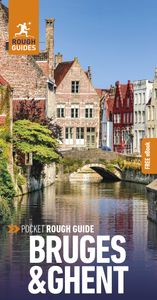
Find even more inspiration here

Planning your own trip? Prepare for your trip
Use Rough Guides' trusted partners for great rates
written by Rough Guides Editors
updated 30.04.2021
Ready to travel and discover Belgium?
Get support from our local experts for stress-free planning & worry-free travels.
- Where to stay
- Travel advice

18 Best Things to do in Bruges, Belgium in 2024
Written By: The Planet D
Updated On: January 19, 2024
Looking for things to do in Bruges? You have come to the right place. Belgium travel writer Sam Van den Haute of Checkout Sam shares the very best things to do in Bruges. We are excited about this post as we have yet to visit this picturesque town and have always wanted to go since watching the movie In Bruges.
Bruges, also known also as ‘Brugge’ in Dutch, is one of Europe’s most well-preserved fairytale cities. Located in the western Flemish region of Belgium, Bruges will truly transport you to places you’ve only read about in storybooks while allowing you to indulge in modern comforts and cuisine.
Table of Contents
Things to do in Bruges, Belgium
Imagine yourself strolling down a quaint cobblestone path, past winding canals teeming with swans and cathedrals from the middle ages. Just add some modern shopping spots and the smell of chocolate to that scene and you’ve got the enchanting, medieval city of Bruges.
Let’s take a look at the top attractions in Bruges that you won’t want to miss on your visit to this bewitching destination.
1. Quay Of The Rosary
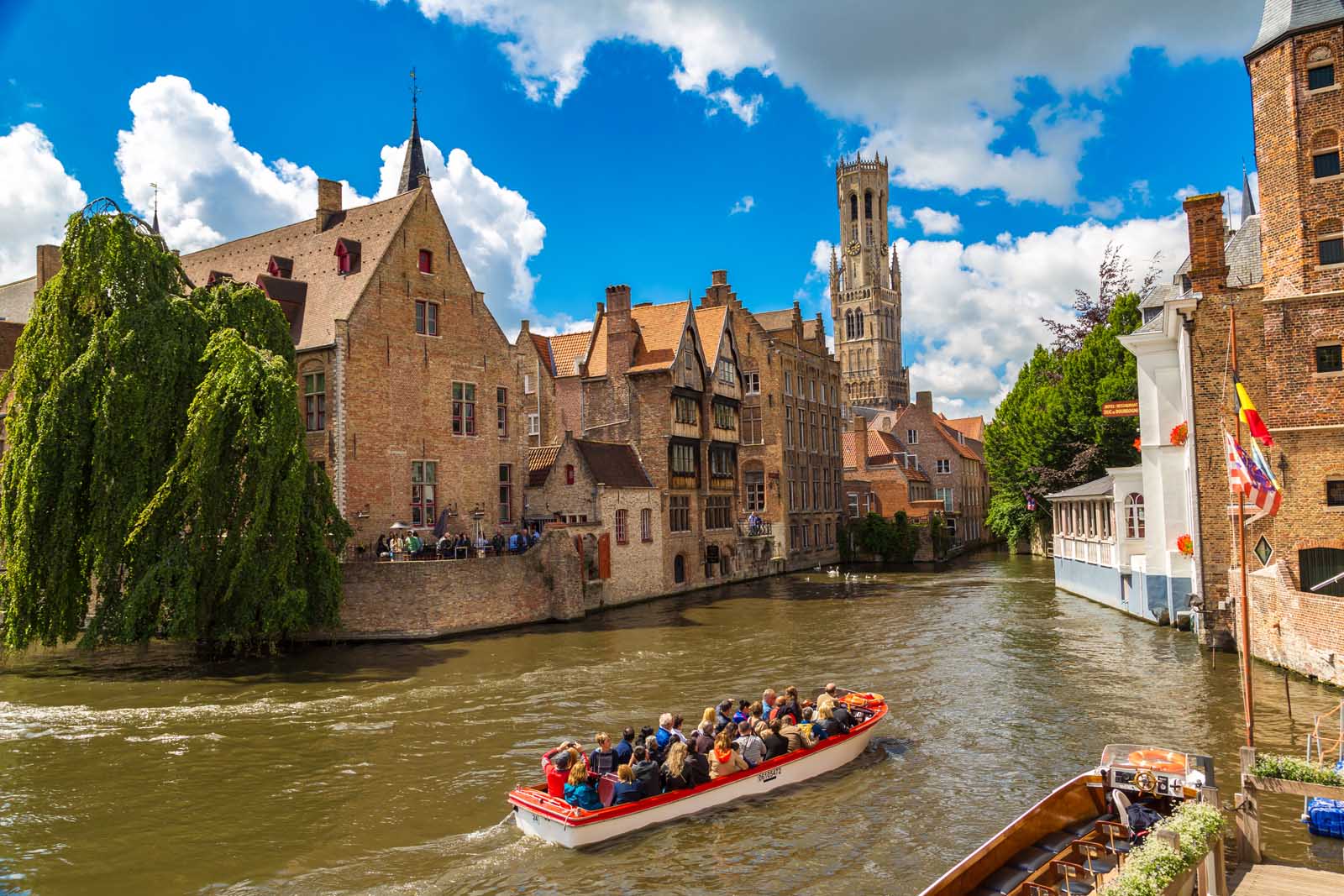
Rozenhoedkaai (Quay Of The Rosary) is the most photographed place in Bruges. Located on a sharp bend of the Dijver Canal it offers the loveliest view in Bruges. The medieval buildings are located directly on the canal between the stone bridge and where the Dijver and Groenerei Canals meet. It’s impossible to miss as it is a popular starting point for boat tours.
This guided boat and walking tour follows a local guide as you see Bruges from the Canals on the water. You’ll discover the narrowest street in Bruges, the basilica, and the Fish Market on your walking tour. You’ll then get onto a canal boat tour at the Quay of the Roasary and sail along the canals to view the facades covered in ivy as you float under bridges admiring the beauty of the city. Details here.
Visit the 2Be – Beer Wall
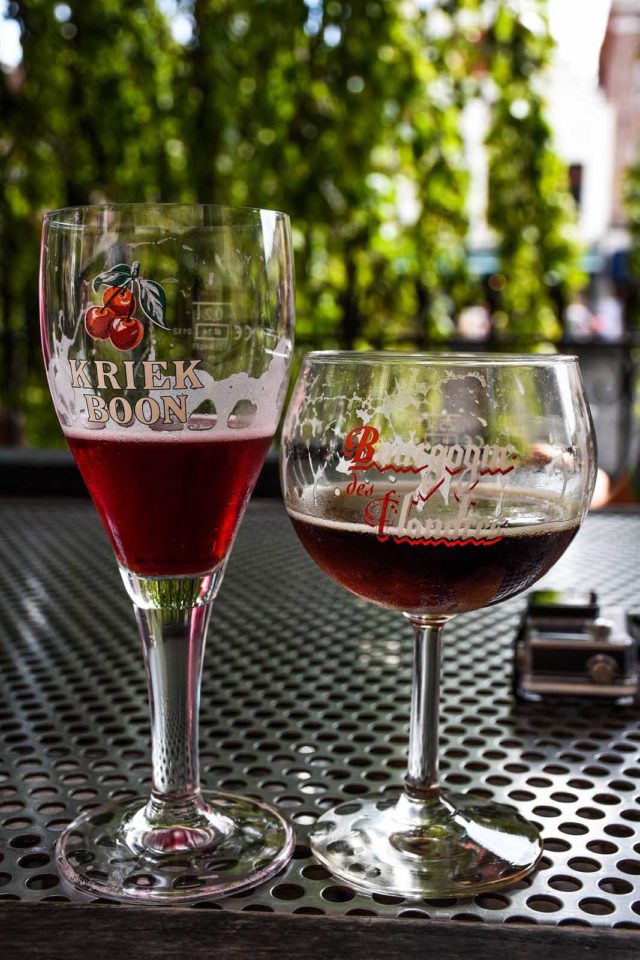
Hot Tip: Make your way to 2Be for a cold beer across the Canal to view the famous beer wall. Belgium is famous for its beer and 2Be houses more than 1000 different beers along its 30-meter-long beer wall.
Beer fans will love this highly rated tour . This Bruges beer experience sets off on foot to learn about and taste Belgian beer. It includes visits to local hidden gems and a popular beer bar. The tour includes Five tasters and three locations including a brewery. Plus a mini chocolate pairing.
2. the Old Town of Bruges
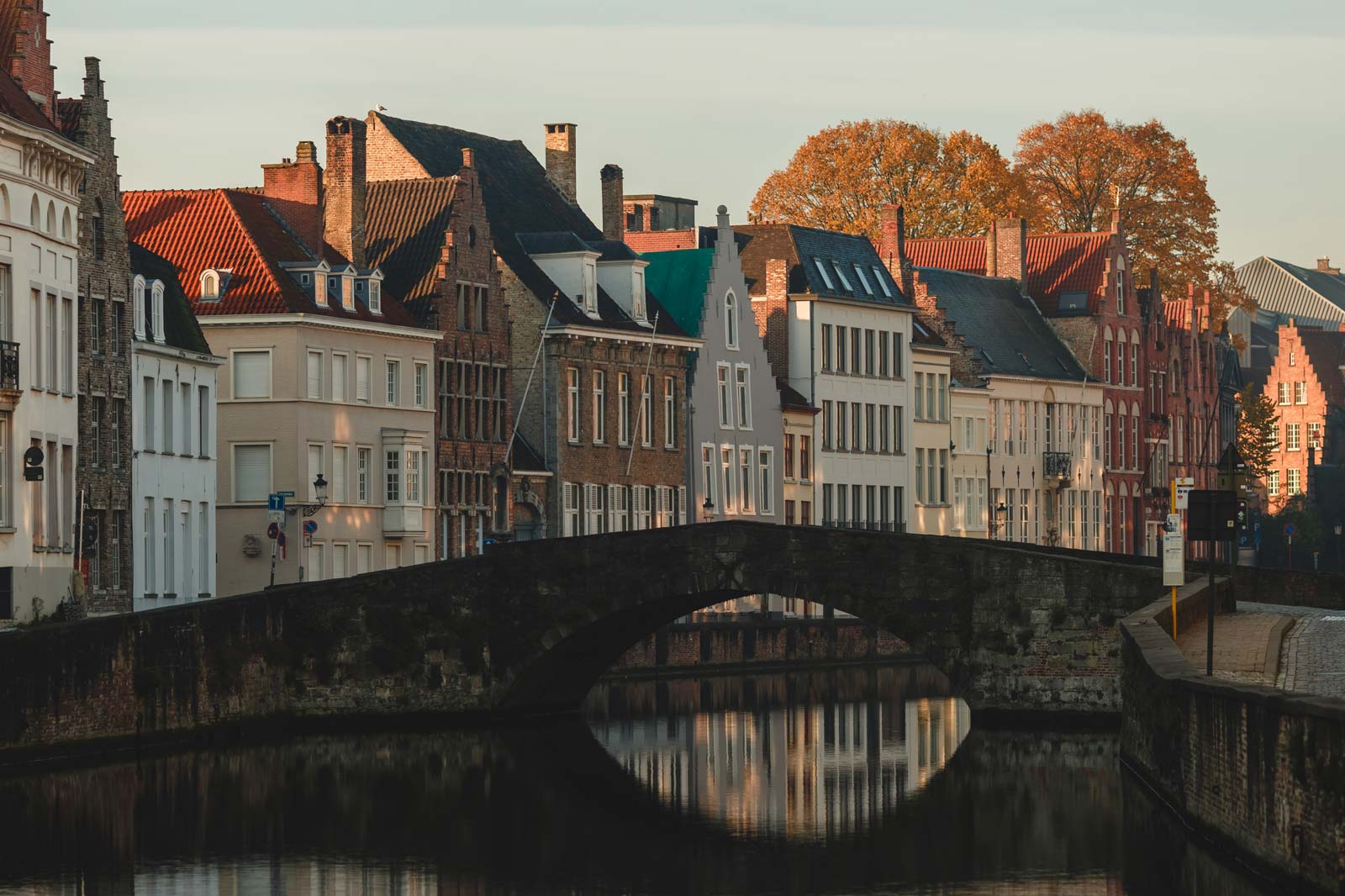
Home to over 117,000 people, Bruges, is often referred to as the “ Venice of the North. ” With canals weaving through the Old Town surrounded by the grand canal, Bruges is the perfect place to find a mixture of fun things to do and see. But unlike Venice, there’s the option of discovering small quiet corners to relax and soak in the splendor.
The Old Town of Bruges is a designated UNESCO World Heritage Site and its small area packs a large punch. Many of the top attractions in Bruges are easily accessible as you wander the streets and explore the canals. With its unique historic pathways, churches, and parks, you will discover a city in Europe that stands out from the rest.
This private walking tour is recommended to explore the town center. You’ll see most of the top Bruges attractions such as the Belfry of Bruges and Onze-Lieve-Vrouwekerk a church containing the Madonna and child by Michelangelo. You’ll wander the canals and alleyways and end with an optional boat trip along the canal to see the sights. More details here
3. Lake of Love
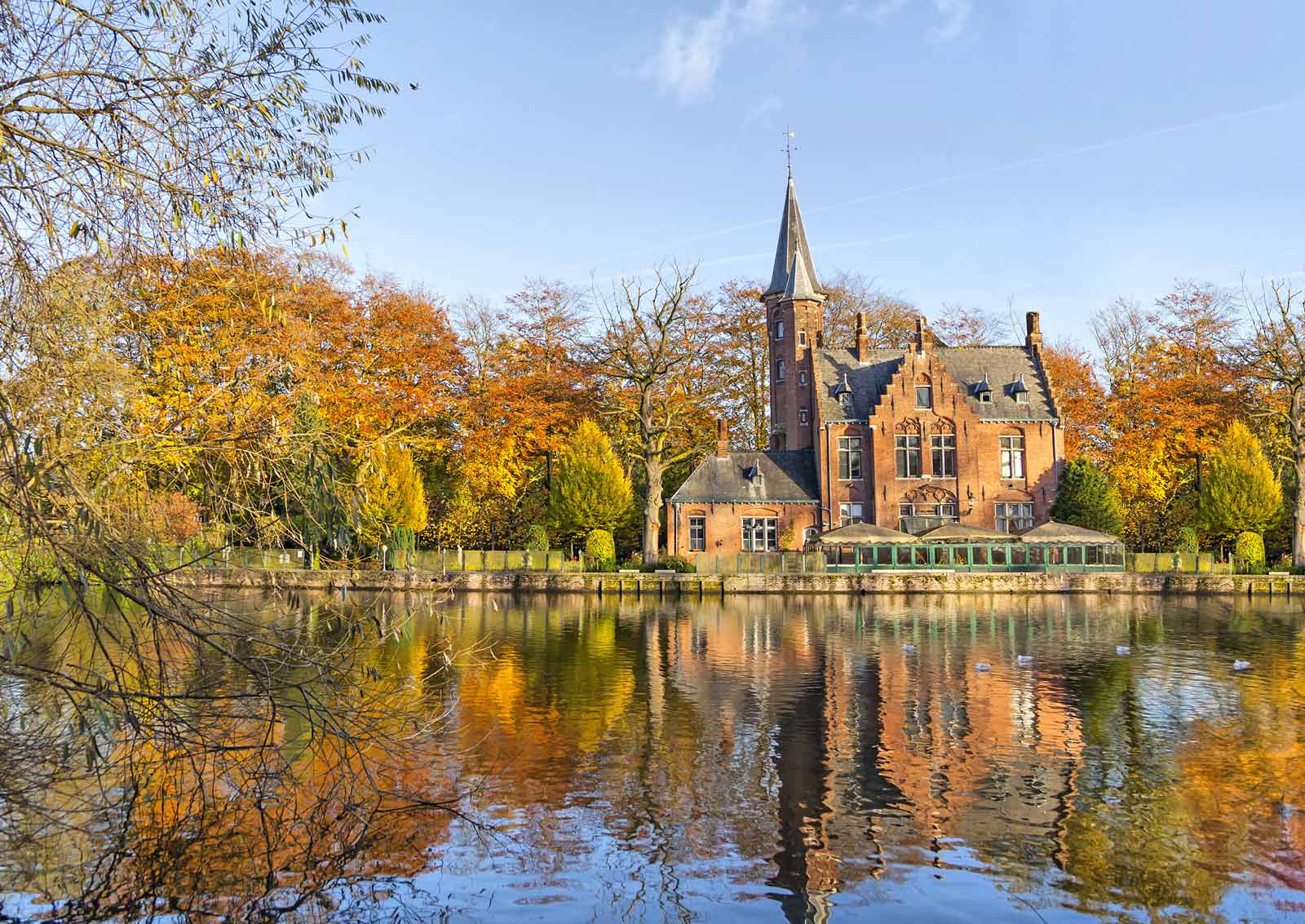
The Lake of Love (Minnewater) is a quiet retreat within Minnewater Park at the south end of Bruges. This picturesque location is perfect for quiet strolls. One of the most photographed places in The Lover’s Bridge spans the canal and it is said that if you cross the bridge with the one you love and sneak a kiss, your love will last forever.
4. Belfry of Bruges
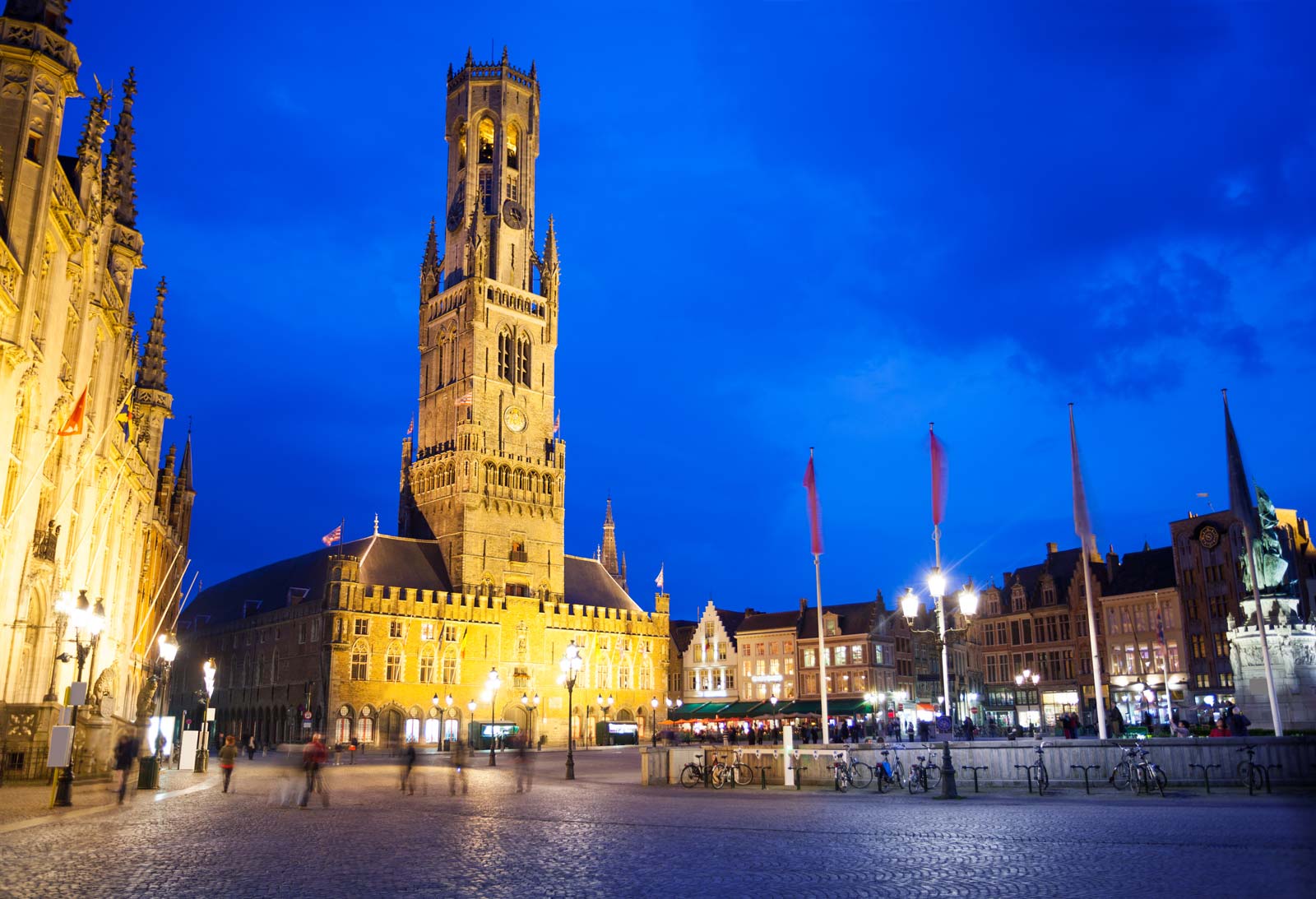
A protected World Heritage site, the Belfry of Bruges is a medieval bell tower in the heart of Bruges’ medieval town. This is a soaring masterpiece that stand 83 meters (272 feet) high it offers some spectacular panoramic views of the city.
The climb up might feel a tad claustrophobic, but the trek will prove to be well worth your while. Within the bell tower, its 47-bell carillon is still tolled manually on any given day.
The Belfort is known as the most important and symbolic tower in Bruges dating back to the 13th century. It is a standing reminder of one of the oldest examples of medieval architecture. You might also recognize the Belfry of Bruges tower which was featured in the well-known movie “ In Bruges” .
5. Bruges Museums
Bruges has many art museums and galleries and the Bruges: Museu Musea Brugge Card gives entry to 12 museums. Prices start at 33 Euro and give access to Belfort (Belfry of Bruge), City Hall, Groeninge Museum, Liberty of Bruges, Sint-Janshuis Mill, Our Lady of the Pottery, Folk Museum, Michelangelo’s ‘Madonna and Child’ and more.
You can activate your card up to one year after purchase. To activate your card you can directly go to the attraction and scan your voucher at the entrance. Get your card in advance here.
One of the more unique places to visit in Bruges is the Torture Museum. This was the oldest prison in Bruges dating back to the 11th century. Today it has been transformed into a museum showing the cruelty of mankind. There are authentic torture instruments dating back to the middle ages. There are wax figures depicting some of the torture devices transporting you into the horrors of this early dungeon. Even though it is difficult, it is sometimes important to see what humans are capable of so that we learn to not repeat the mistakes of our past.
6. Market Square
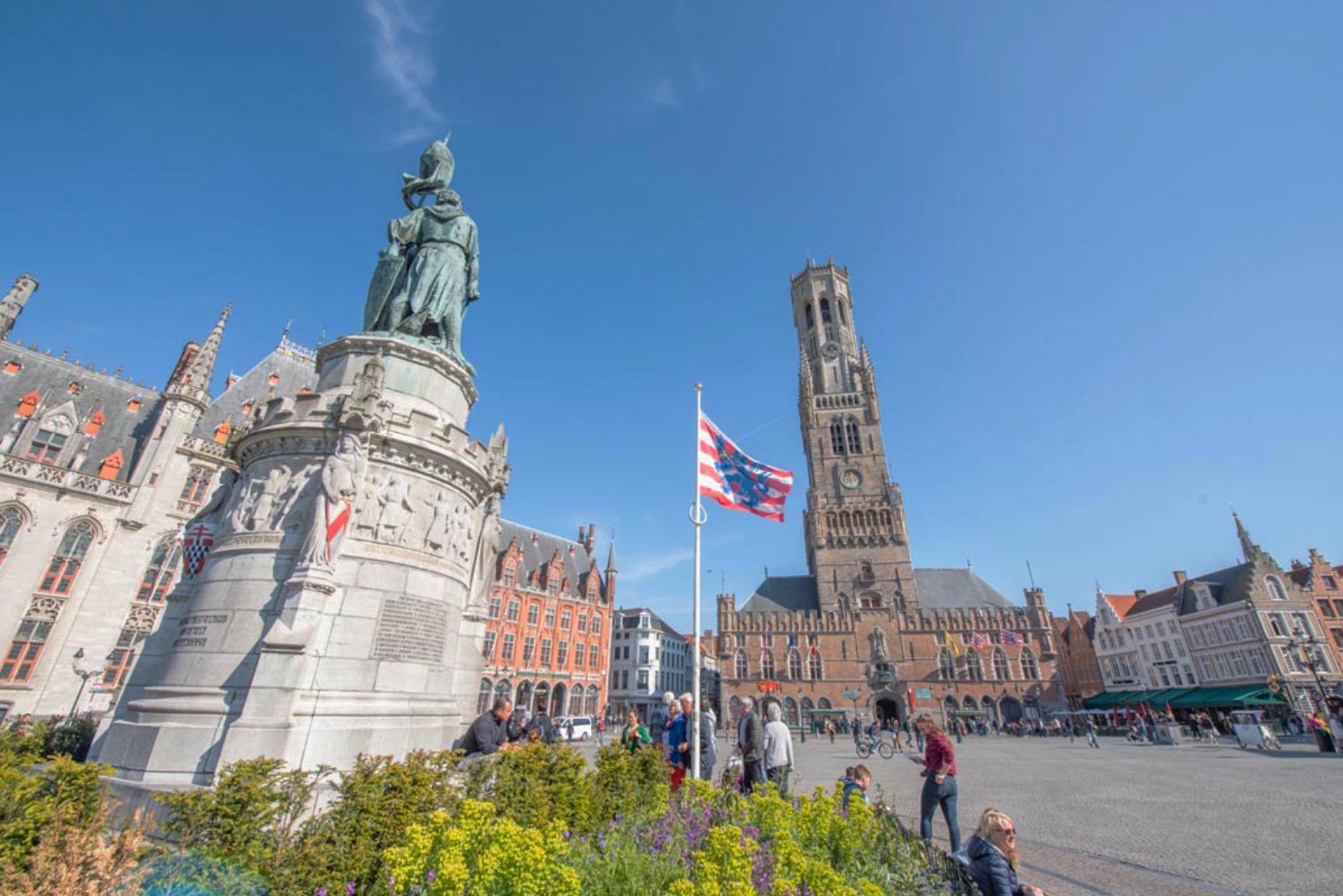
The Brugge Markt otherwise known as the Market Square (or Bruges Markt) is one of the top spots to check out while in Bruges. Today the square is chock-full of restaurants and shops and is used as a meeting place for locals. Market Square is also where you can catch a ride on a horse-drawn carriage to explore the city!
Each building in Market Square is unique, and you will notice the distinct changes in architecture throughout time as you walk through this historic market. For those yearning for a “life-like” walk into the past, be sure to stop by “Historium” located in the square, which offers a historic experience back to the 15th century!
The medieval market square has been in use since the year 958 and is also the location of the famous Belfry tower. A visit here is one that you simply cannot pass up. Make sure to keep an eye out for the statue of Jan Breydel and Pieter de Coninck who led the Flemish uprising against the French king in 1302.
One of the most romantic things to do in Bruges is to take a horse drawn carriage tour. Carriages leave from Market Square and take you on a half-hour ride to see the Bruges canals, ancient bridges, and beautiful squares.
7. The Burg Square
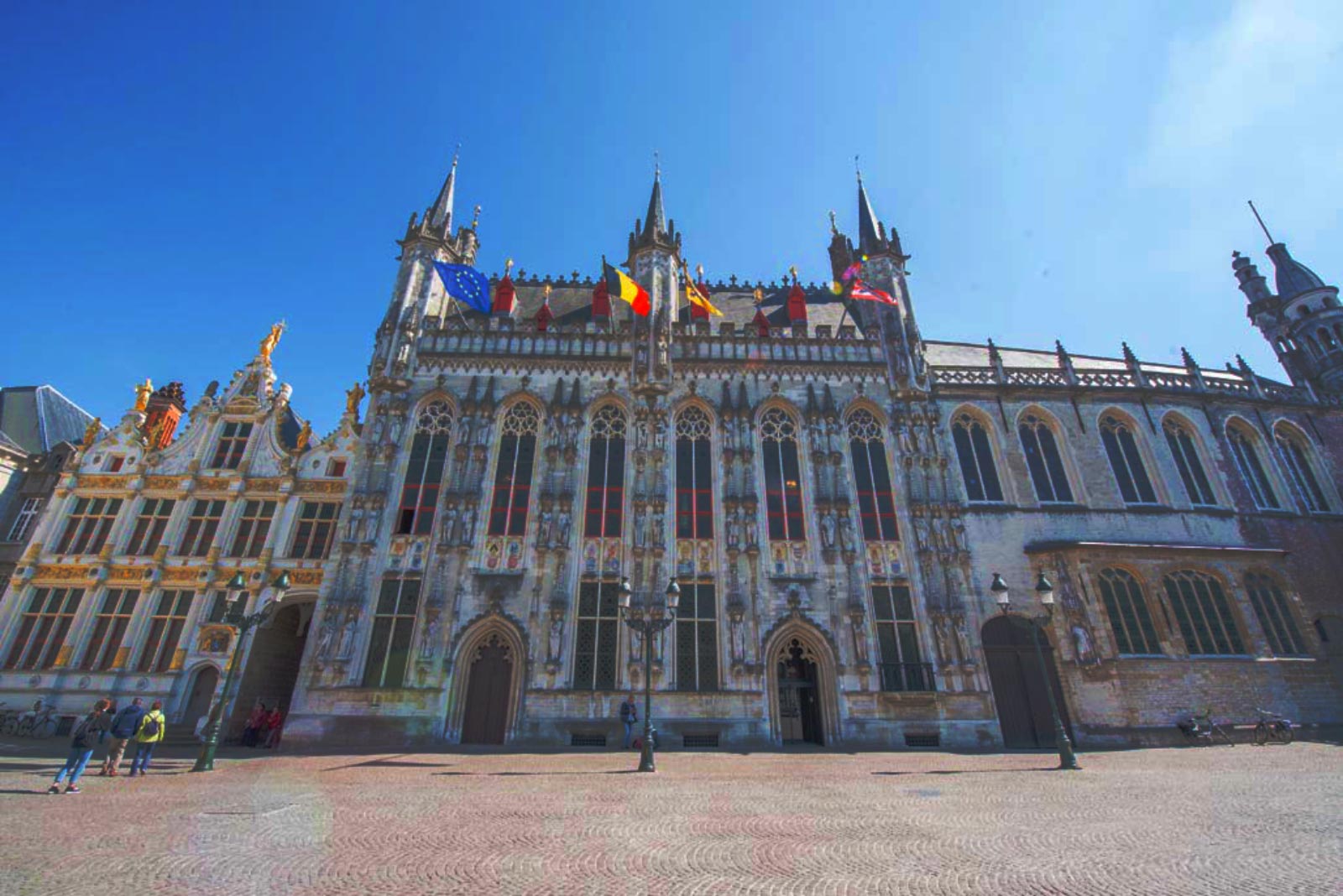
For those interested in architecture and history, you’re sure to be dancing with joy throughout your entire trip to Bruges. The Burg is a square that has been inhabited since the 2nd Century and exhibits examples of Renaissance, Gothic, and Neo-classical architecture including the Old Town Hall – a star attraction in Bruges. You will find yourself walking through history with each building you pass on your way into Burg square.
The historic buildings in one of the oldest parts of Bruges include the “Stadhuis” also known as the Bruges City Hall, which is preserved from its original build in 1376, and the Old Civil Registry from 1537. The Old Town Hall is one of the oldest buildings in the entire region and the city has been governed from here for more than 600 years. There is a museum on the ground floor that is worth going into.
You will also see the historic court of Justice, the Church of our Lady, and the Palace of the Liberty of Bruges (Brugse Vrije). You can even pop on over next door to explore the old fish market and many scenic canals!
The Burg Square is a great starting point to explore Bruges. From the square, continue your walk to explore the colorful alleys that lead you to the canal. It’s beautiful, free, and oh-so-photogenic.
8. Church of our Lady
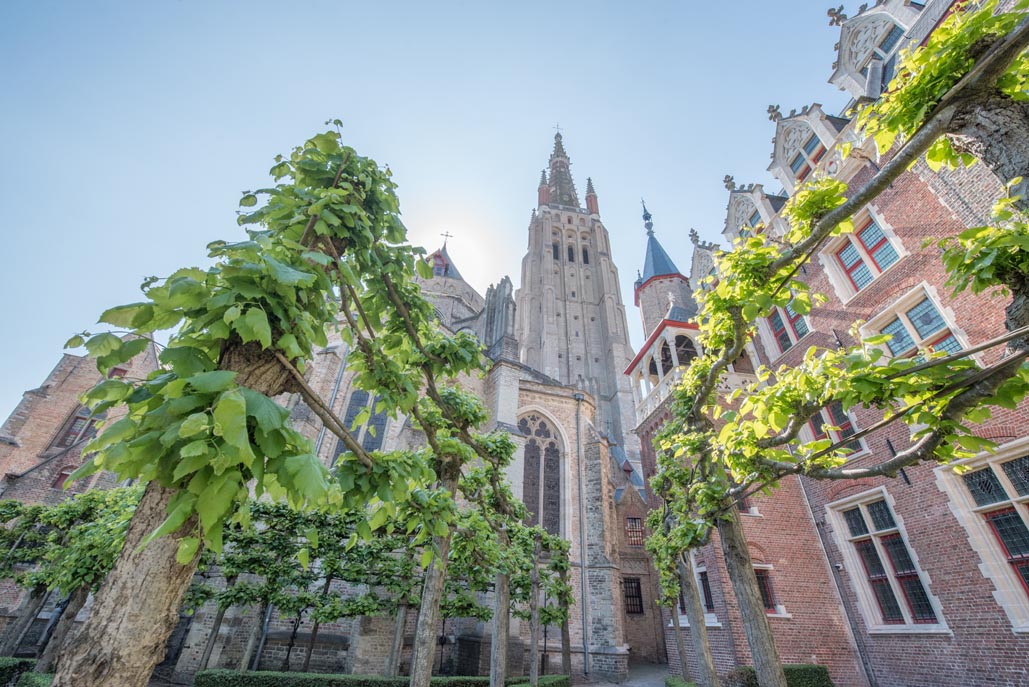
The Church of Our Lady (Onze-Lieve-Vrouwekerk) is an alluring beauty originating from the 13th century. Complete with a 115.5-meter-high tower, (379 feet) the Onze-Lieve-Vrouwekerk is the highest-standing structure in Bruges and is apparently the second tallest brick tower in the world. And here is a fun fact, it is also the second tallest brick building in the world.
The Church displays various notable artworks from artists such as the marble Madonna by Michelangelo. It has been expanded and renovated over time, initially taking roughly two centuries to construct. It is currently undergoing further restoration. Some artworks will be unavailable to view due to the renovations, however, the majority of this impressive church including the Madonna should now be available.
9. St. John’s Hospital
Reflecting its over 800 years as a working medical institution, this popular historic museum is found inside of the medieval Saint John’s Hospital.
Sint-Janshospitaal is known for being one of the most well preserved old hospitals in all of Europe. Now a museum, it gives you the chance to see what the old wards and life in the hospital would have been like.
As for art, there are many collections from various houses of worship that were in the old community of Saint Jan’s. Many of those pieces were handed over to Saint Jan’s Hospital after the fall of Napoleon in the year 1815.
Amongst these examples of high-level religious art, you’ll also find donated works from related charities, as well as the famous 16th-century ensembles from Hans Memling inside of the chapel.
10. The Begijnhof
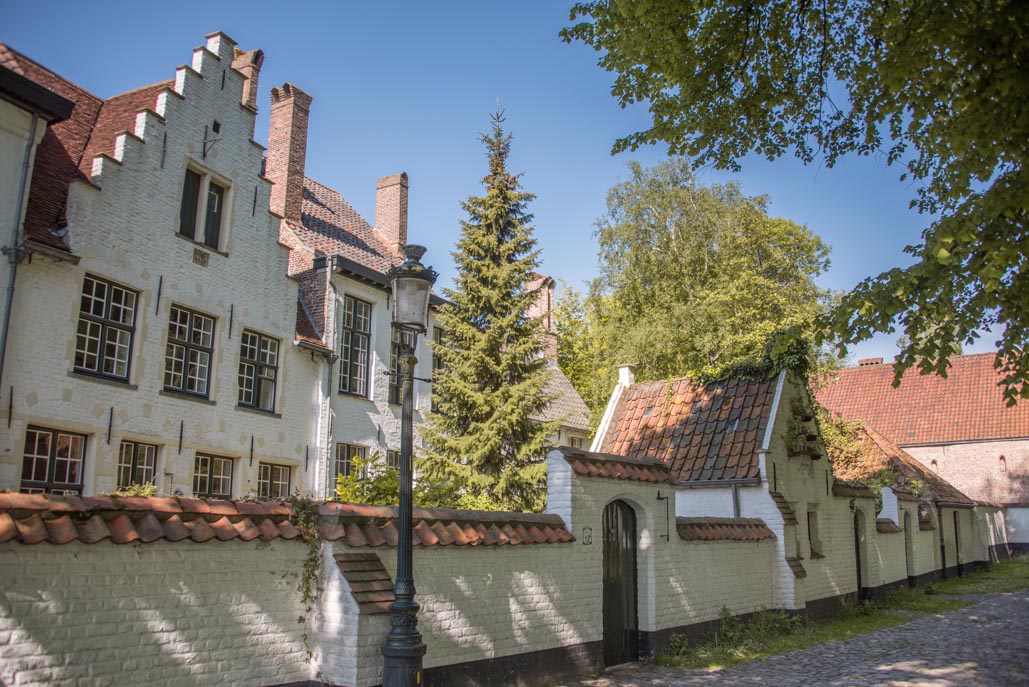
As a UNESCO World Heritage site since 1998, Begijnhofs, or “Beguinages” are without a doubt a unique feature of Europe, specifically Belgium and the Netherlands.
Dating back to the mid-13th century, these historic complexes were originally inhabited by a collection of religious women, or Beguines, who lived their lives by example of the apostles. The Begijnhof in Bruges specifically counts as one of the best-preserved. Some Beguine’s houses are open to visitors where you can step back in time to get a feel of what it was like to live here!
The Beguines lived in a community consisting solely of women; those who were widowed or single that wanted to live in a pious manner. The Begijnhof is still used today as living quarters for nuns and women who have chosen to stay unmarried.
As you walk down its tiny cobblestone streets, you will leave behind the noisy atmosphere of the city and find yourself in a calm, serene area.
11. Basilica of the Holy Blood
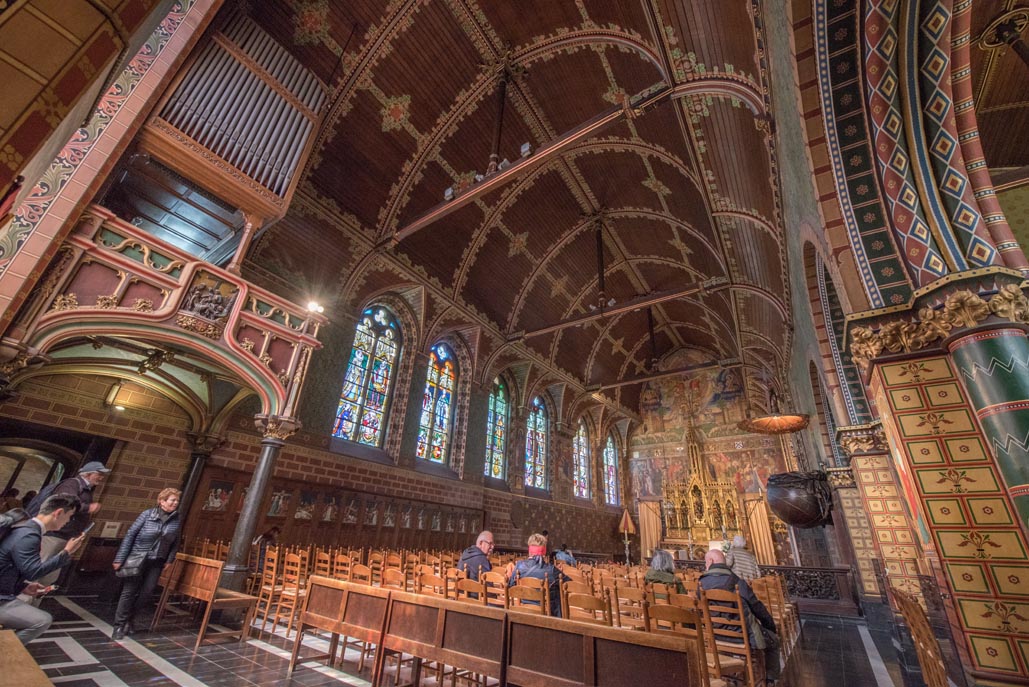
The glorious Basiliek van het Heilig Bloed (Basilica of the Holy Blood) dates back to the 12th century. It is one of the top attractions in Bruges and is not to be missed. Named for Our Lady and Saint Basil, this famous double church is said to possess a vial harboring drops of the blood of Jesus Christ himself.
The blood of Jesus was supposedly delivered to the basilica from the holy land after the crusades in the 12th century. This relic of Jesus is taken out daily at 2 pm allowing visitors to pay their respects.
Being a double church, you will notice two distinct sections on your visit. An upper church, which sports neo-Gothic architecture and is home to the relic of the holy blood, and a lower chapel, which has preserved its Romanesque features. You won’t want to miss the chance to see this unique basilica in person!
The Basilica of the Holy Blood, aka Basiliek van het Heilig Bloed is located in the city center, just west of the city hall. Bruges City Hall is also known as the “Stadhuis.
12. Groeningemuseum
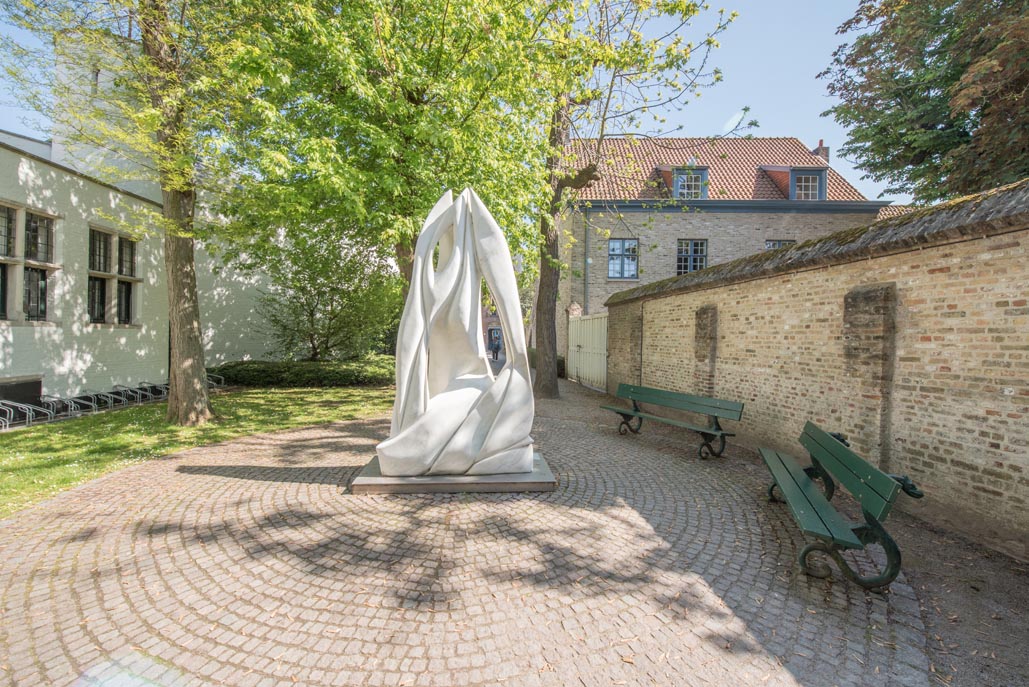
There is no better place for art lovers to learn about Belgian art and history than the famous Groeningemuseum! Bruges has plenty of art galleries but Groeningemuseum is one of the finest. This art museums is built on the former location of the medieval town, Eekhout Abbey, the museum offers an entire visual overview of various aspects from Flemish & Belgian artists, as well as artwork from between the 14th to the 16th century.
This includes neo-classical pieces from the 18th and 19th centuries. Many post-war modern art pieces and examples of Flemish expressionism are also highlighted at the museum and let’s not forget the world-renowned collection of Flemish primitive paintings.
Of course, many of these works were originally created in Bruges itself! It’s also good to note that there are regular showcases of beautiful exhibitions held in the Groeningemuseum.
Don’t forget to check out the apothecaries and herb garden!
13. Loppem Castle
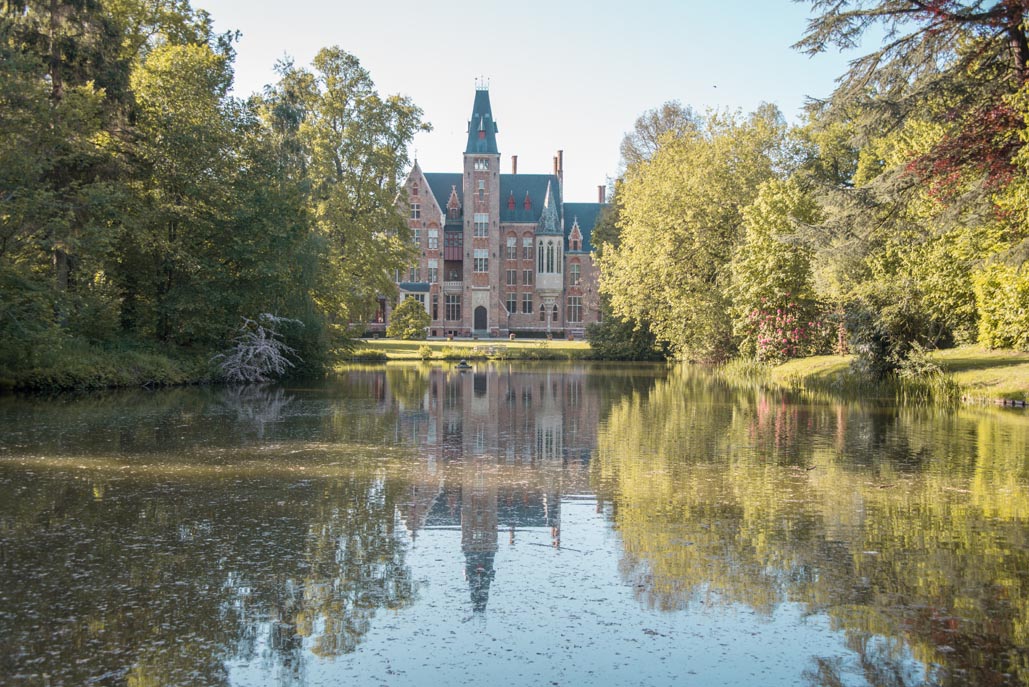
Emphasizing the fairytale-like atmosphere of Bruges, the 19th-century Loppem Castle can be found just 10km south of the city center.
Boasting beautiful neo-gothic architecture, the Loppem Castle combines its original interior and architectural state with its winding garden maze, and a vast collection of art to take you back in time.
The castle was temporarily home to King Albert I after the first world war, even hosting Queen Elizabeth in 1918.
Walking through the corridors of Loppem castle brings to life the footprints left by artists and kings of the past.
14. Hof Arents Park
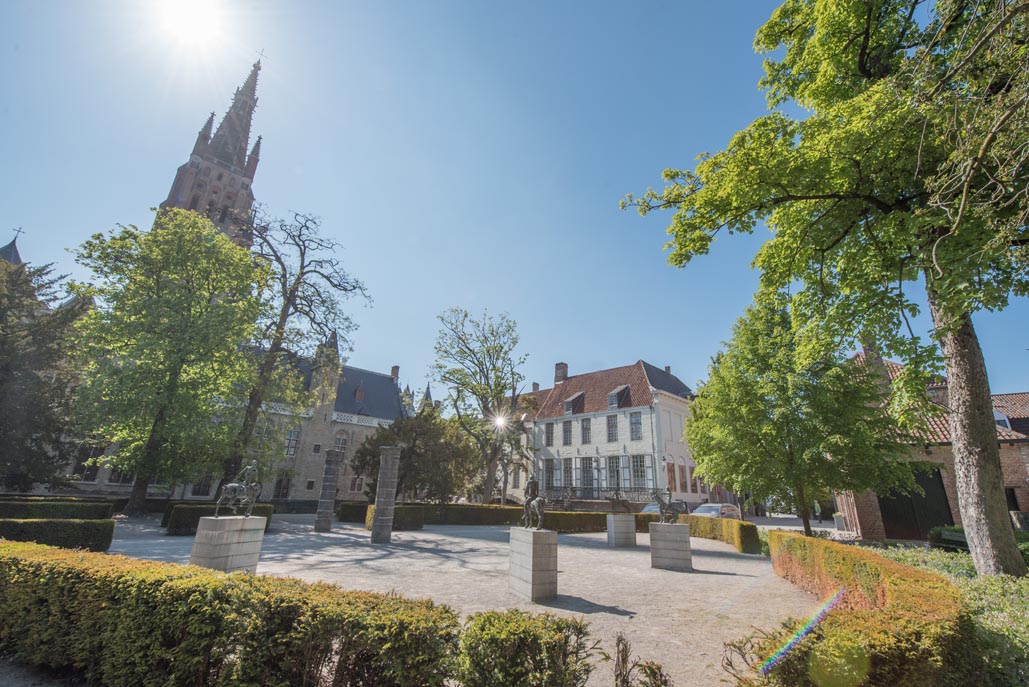
After that much sightseeing, you’ll be ready for some peace and quiet. Located directly behind the Arentshuis museum, you will find the beautiful Hof Arents.
This charming green park is situated along the canals and offers a small idyllic bridge, outside artwork, and many hidden benches between tall trees.
While the 18-century Arentshuis museum itself is certainly worth a visit, you’ll be hard pressed to find a more tranquil spot as the Hof Arents park.
15. De halve maan
Beer lovers will enjoy stopping in at De Halve Maan Brewery. It dates back to the 16th century and has been passed down from generation to generation since 1856. No European city visit would be complete without a tour of the town’s brewery. De Halve Maan offers daily brewer tours where visitors can enjoy a pint of Brugse Zot Blond Beer at the end of the tour.
Hot Tip: An added bonus is that you can go up to the top of the brewery and experience a panoramic view of the city, saving you the €10 you would’ve spent going up to the top of the Belfry of Bruges.
16. Jan van Eyck Square
Located in the Hansa Quarter, Jan Van Eyck Square is named after the famous painter Jan Van Eyck. This is a quieter square than other squares in Bruges but it is quite picturesque.
During the 13th to 15th century, Bruges was the trading center between England, Germany, and Scandinavia and this historic quarter of the Old Town gives you a sense of what this important crossroads was like. It is here that you can view the old mansions of the rich traders who took up residence in Bruges. Jan Van Eyck was supported by the rich patrons of Bruges and there is a statue of him at its center.
17. Go Windmill Hunting
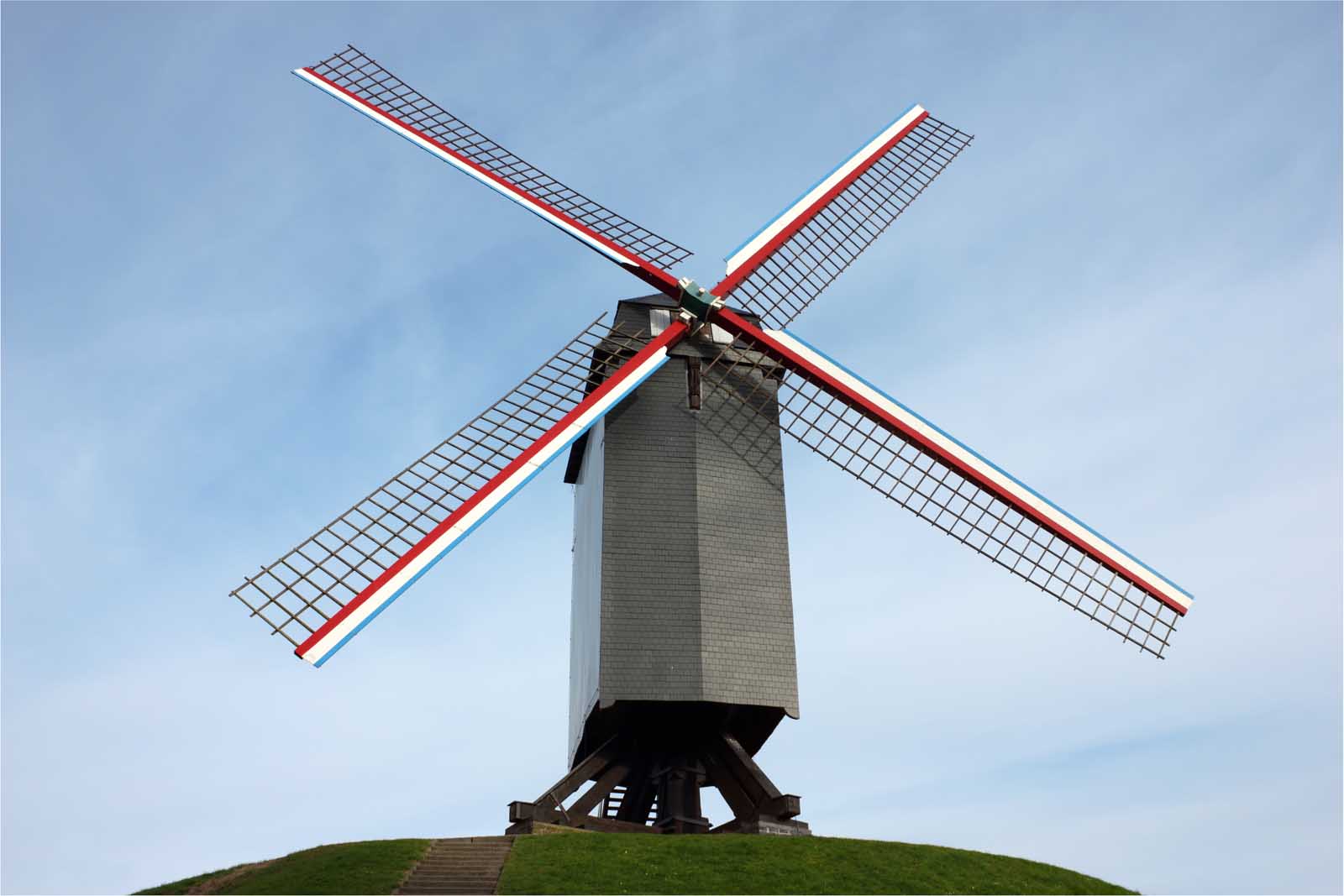
We all know that the Netherlands is famous for its windmills, but Bruges has them too! In fact, Bruges isn’t too far from Amsterdam and many people take day trips from Amsterdam to see Bruges. The windmills of Bruges have become a popular attraction in Bruge with a handful of windmills located just outside the old city. Sometimes referred to as windmill walk, visitors can take a stroll to see the picturesque windmills. You can go inside some of them as well.
18. ChocoStory Chocolate Museum
No trip to any Belgium city would be complete without visiting a chocolate museum. The Choco Story Chocolate Museum Tour takes you on a journey through time to learn about the origins of chocolate and you’ll get to taste it too. Details here.
Did you know that there is 4000 year history of chocolate? This chocolate museum has three phases telling the history of the evolution of chocolate to how it is made and a tasting.
How to Get to Bruges
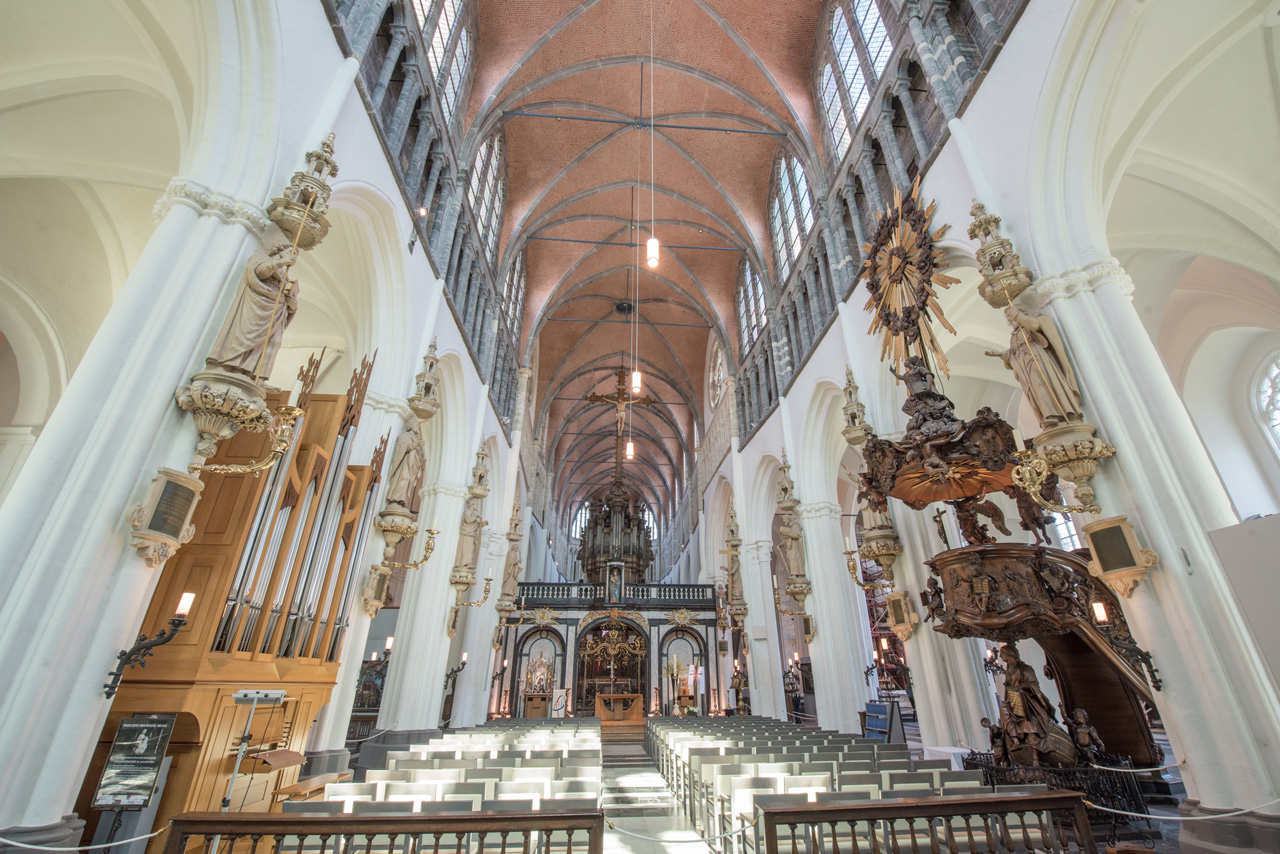
Bruges is located in the North-West of Belgium in the Flanders region of the country just a few km inland from the North Sea. Bruges is less than an hour’s train ride from Brussels .
It is famous for its canals and narrow streets and the Bruges city centre is a UNESCO world heritage site. It’s one of Belgium’s most well-preserved medieval towns and is a must-visit when exploring the country.
Because it is relatively small, you can see a lot of Bruges and the medieval town in a short time. Bruges is just a short drive or train ride from Brussels and is well-connected with other cities in Belgium and Europe.
- Bruges to Brussels: 101 kilometers (62 miles)
- Bruges to Ghent: 47 kilometers (29 Miles)
- Bruges to Antwerp: 90 kilometers (56 miles)
- There are also ferries to Bruges from England.
- Traveling by train to Bruges is easy and convenient. Brussels airport has a railway station so you can go directly to Bruges once you land.
- Or you can do what we prefer, rent a car and take a road trip. You can compare prices here at RentalCars.com
Bruges Day Trips
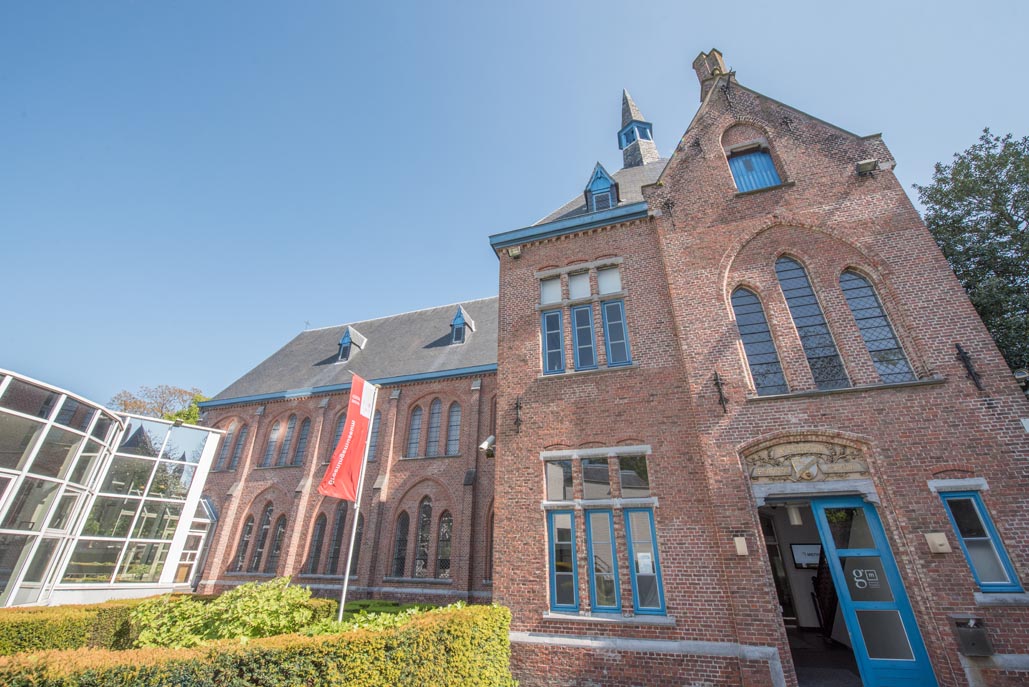
Many people take day trips to Bruges from Brussels and Amsterdam, but to really get a feel for this city you should spend the night. For booking hotels, we use Booking.com and TripAdvisor for comparison shopping, reviews, and deals.
Bruges is located in Flanders and a popular day trip from Bruges is to visit Flanders Fields . The poppy fields of Flanders are visited on this tour. You may remember the poem In Flander’s Field by John McCrea. The tour takes you to The WWI Battlefields, the Menin Gate Memorial, and the cemetery as well as the poppy fields made famous by the poem. Tickets can be purchased in advance and there is easy cancellation with 24 hours’ notice. Book your tour here.
While in Flanders, a popular stop is the Groeningemuseum. It displays famous Flemish artists like Jan van Eyck and Hans Memling.
When is the best time to visit Bruges?
- The best time to visit Bruges is from the end of May to the beginning of September.
- From June to August the weather is mild and sunny and it is the high season for tourists.
Out of every European city you may have had the chance to visit, I guarantee that Bruges will stand out from the rest.
From its tiny canals to its historic markets and museums, there really is no place like it. Bruges will leave you with a charming, nostalgic impression that is sure to last a lifetime.
How to Spend a Weekend in Bruges on a Budget
- Belgium Travel Guide
- The 21 Best Day Trips from Amsterdam
- Facts about Belgium
This Bruges article was originally written by Sa van Den Haute and has been updated by The Planet D team.
Author Bio: Sam Van den Haute is the blogger behind Checkout Sam ; an English, Dutch, and German travel blog with practical guides and valuable information to help fellow adventurers get the maximum out of their trip. He has traveled to more than 60 countries and plans on visiting many more! Follow him on Facebook and Instagram
Travel Planning Resources
Looking to book your next trip? Why not use these resources that are tried and tested by yours truly.
Flights: Start planning your trip by finding the best flight deals on Skyscanner
Book your Hotel: Find the best prices on hotels with these two providers. If you are located in Europe use Booking.com and if you are anywhere else use TripAdvisor
Find Apartment Rentals: You will find the cheapest prices on apartment rentals with VRBO .
Travel Insurance: Don't leave home without it. Here is what we recommend:
- Allianz - Occasional Travelers.
- Medjet - Global air medical transport and travel security.
Need more help planning your trip? Make sure to check out our Resources Page where we highlight all the great companies that we trust when we are traveling.
You May Also Like
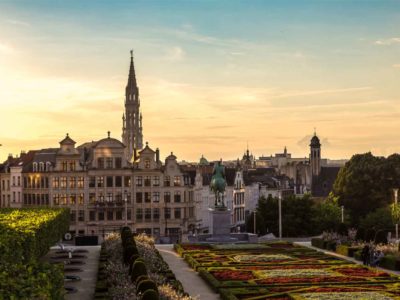
24 Best Things To Do In Brussels in 2024
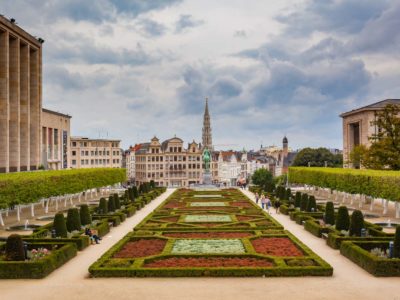
26 Facts About Belgium You Should Know
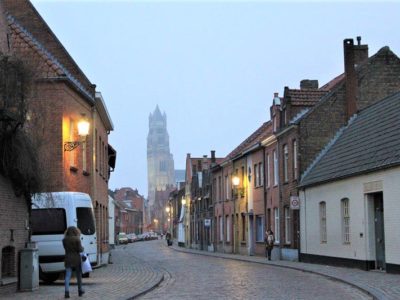
About The Planet D
Dave Bouskill and Debra Corbeil are the owners and founders of The Planet D. After traveling to 115 countries, on all 7 continents over the past 13 years they have become one of the foremost experts in travel. Being recognized as top travel bloggers and influencers by the likes of Forbes Magazine , the Society of American Travel Writers and USA Today has allowed them to become leaders in their field.
Join thousands of others who get our monthly updates!
Leave a comment cancel reply.
Save my name, email, and website in this browser for the next time I comment.
8 thoughts on “18 Best Things to do in Bruges, Belgium in 2024”
If you get to De Halve Maan I’d recomment one or more Straffe Hendrik black! You’ll be amazed.
Brussels is one of the most beautiful places in Belgium and a must-visit place. Thanks for sharing.
He Sam, nice article, thanks of putting our small belgian city on the map!
Thanks alot for this great post Sam, is really nice you put our little small country on the map !
regards Caro
Nice article about one of the most beautifull places in Belgium
I had the opportunity to have a 5 day holiday, it was one of the rare places I would like to see again as soon as possible. it was great!
One should try all the things mentioned above
I had the chance to have 2 weeks of vacation, one of the rare places I want to see again as soon as possible.

A Guide to the Best Things to do in Bruges, Belgium
By: Author Sophie Nadeau
Posted on Last updated: 9th March 2023
Categories Belgium
Last Updated on 9th March 2023 by Sophie Nadeau
Bruges . The name alone probably conjures up visions of fairytale canals, gingerbread houses, and quirky bars serving plenty of Belgian beer. Well, if you’re looking for the best of the city which is known as Brugge in Flemish, then here’s your ultimate guide to the best things to do in Bruges , including insider tips and things to know before visiting for the first time.
For more information, be sure to check out our suggested one day itinerary for Bruges and our perfect Belgium itinerary .

Where is Bruges?
What is bruges known for, how long do you need in bruges, #1 take a boat tour of the canals, #2 sample a waffle, #3 go up the belfry, #4 snap photos of brugge markt, #5 visit the bruges christmas market, #6 de halve maan brewery, #7 seek out hidden gems, #8 admire the view from the quay of the rosary, #9 sample some fries (with mayo), #10 eat some chocolate, #11 visit ten wijngaerde (bruges beguinage), #12 relax in minnewater, #13 discover burg square, #14 visit 2be beer, #15 basilica of the holy blood, #16 st salvator’s cathedral, #17 groeningemuseum, #18 historium bruges, #19 blinde ezelstraat, #20 learn about lace, #21 eat in a local restaurant, bruges travel tips, how to visit bruges, where to stay in bruges, what is the population of bruges, what are the best free things to do in bruges, is bruges safe to visit.
Bruges can be found in Flanders, which is the Flemish speaking part of Belgium. Located not far away from the sea, the city is around an hour’s train journey away from the Belgium capital city of Brussels. A historic settlement, Bruges has enjoyed city status since the 12th-century, when it was an important hub of trade.
Bruges is the largest city in the Province of West Flanders and boasts a population of just under 120,000 inhabitants. The closest cities to Bruges include the quirky city of Ghent (known as Gent in Flemish) and Ostend, which is right by the sea.
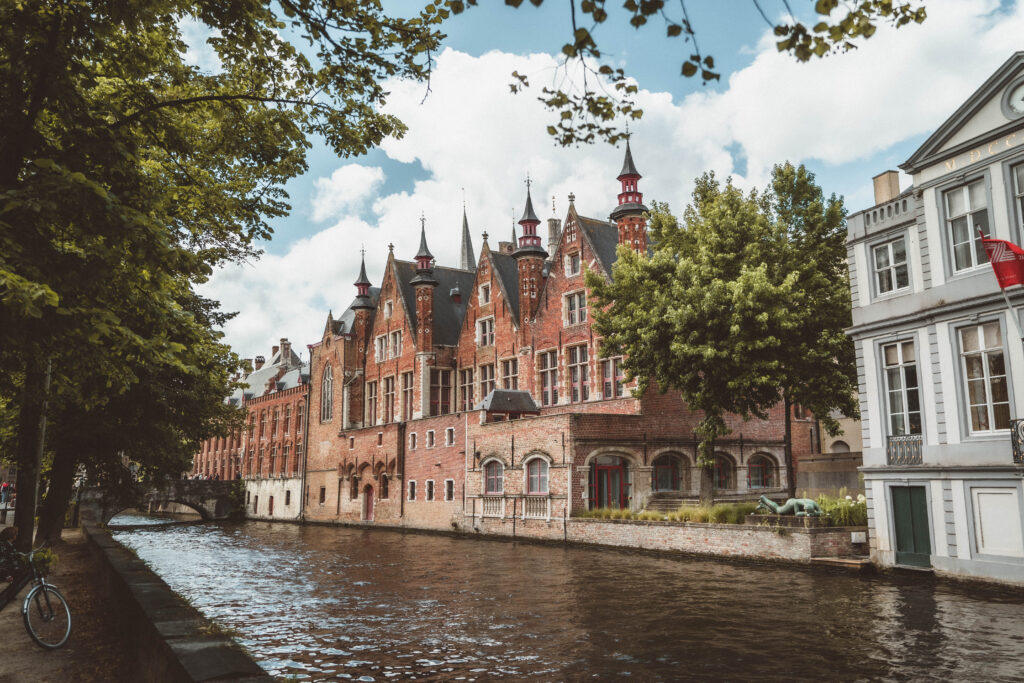
Undoubtedly, Bruges is most famous for its picturesque architecture, wealth of canals, and UNESCO world heritage status. The city is also known for its lace making, which was traditionally made my nuns.
Today, there are a number of lace shops around the city, as well as a Lace Centre where visitors can learn all about the history of lace making in Brugge. In terms of nicknames, Bruges is often referred to as the ‘Venice of the North’ on account of its many canals and waterways.
The name Bruges itself actually derives from the Viking word for ‘wharf,’ and is a true testament for just how long Brugge was an important trade hub in Europe. The city rose to true prominence around 1000 years ago, when it came to be known as the most textile market in Europe.
Bruges is actually much smaller than many visitors first anticipate and so, in truth, it’s fairly easy to see the best of Bruges over the course of a day. If you want to enjoy all of Bruges’ attractions, including by going for beer tastings and visiting the museums, then I would recommend staying in the city for two or three days.

Best things to do in Bruges
Of course, as well as meandering among the waterways of Bruges, one of the best ways to experience the water is by taking to the water yourself. Easily one of the most popular things to do in Bruges, there are plenty of tour companies which offer guided boat tours of the water, whereby you can sit back and relax, listen to a guided commentary about the history of the city, and soak up the sights.
There are five landing stages where the various visits depart from and tours last for around half an hour. In this time, a captain will guide you through the iconic Bruges canals, which were originally constructed to serve as shipping lanes for the city. Book your Bruges boat tour and guided walking tour here in advance.

If I’m honest, one of the best ways to occupy yourself while on any trip to Belgium is to sample all of the local food. Waffles are probably one of the first things that come to mind when you think of Belgian cuisine, but a Belgium fact that you may not know about is that there are actually a number of types of waffle.
The most common type of waffle that you’ll find in every touristic location in Belgium is that of the Brussels waffle, which is famed for being rectangular in shape with cut outs. The waffle is then often topped with sweet additions such as cream or melted chocolate.
The other most common type of Belgian waffle is the Liége waffle, which is more asymetrical in shape and features large chunks of sugar. When it comes to sampling a waffle in Bruges, some of the best-reviewed shops include Chez Albert and Fred’s. For those who want to dive even deeper into waffle culture in Belgium, it’s possible to book a waffle workshop like this one.

If you’re in search of a bird’s eye view of the city, then you simply must climb the belfry, which stands at 83 metres tall, and as a result, encompasses a walk up of over 300 steps (366 steps). From the top, you can see the moated canal that rings its way around the city, as well as all of the other iconic attractions that Bruges has to offer.
The belfry is known as Belfort van Brugge in Flemish and dates all the way back to the 13th-century. The original belfry was constructed in 1240 to act as a watchtower with 47 bells though unfortunately burnt down during a devastating fire before.
Reconstruction began following the 1280 fire, though later 15th-century additions include the octagonal staircase at the top of the tower and Gothic revival style decoration on the roof. Today, visitors can go up the Bruges Belfry for a fee.
The best time to visit the Bruges Belfry is earlier in the day as it’s the most popular tourist attraction in the city. For obvious reasons, the belfry soon reaches full capacity and so it’s not unusual to be waiting up to an hour to ascend the tower (particularly around midday). Book your Belfry tickets on the official website here.

Like most historic cities in Europe, Bruges has its very own grand piazza in the centre of the city, around which the rest of the city is built. Head to the square and you’ll soon discover lively music performances, several buildings of note, and plenty of restaurants and cafés.
With this being said, one of my top Europe travel tips is to actually avoid the most touristy spots for food as they’re often overpriced and you’ll likely find better quality food just a few streets away.
The main square in Bruges itself was founded as a market square in 958 and a weekly market has been held on the square ever since. Nowadays, market day is every Wednesday morning.

At Christmastime, the main Christmas market of Bruges takes place in Grote Markt. Lying in the shadow of the towering belfry, the annual event has dozens of traditional wooden chalets selling Christmas market food and small gifts. There’s often also an ice skating rink. In 2021, the Bruges Christmas market will take place from the 26th November 2021 to the 9th January 2022.

Of course, Belgium is famed for its beers and so one of the more popular things to do in Bruges that has to do with Belgian cuisine is to take a beer tour. The best place in the city to do this is the De Halve Maan Brewery, which also functions as a café and bar serving local fare and beer brewed on site.
The tour itself takes visitors around the brewery and teaches you about the beer making process, as well as the history of beer in Belgium. The price of every tour ticket includes a complimentary beer. There’s also a souvenir shop where you can buy beer to take home with you.

No matter how visited any place is, there are always hidden gems and secret spots worth scouting out and Bruges is no exception. One of the coolest places to discover in the city is a former hospital turned museum which is a true hidden treasure in the very heart of the city.
Yet another is a quiet park named Minnewaterpark which boasts the likes of giant chess boards and a plethora of benches where you can enjoy a picnic on a summer’s day.
For even more inspiration for your trip to Bruges, be sure to check out our guide to the best secret spots in Bruges . If you prefer guided visits, then this hidden gems tour of Bruges will surely reveal more city secrets to you.
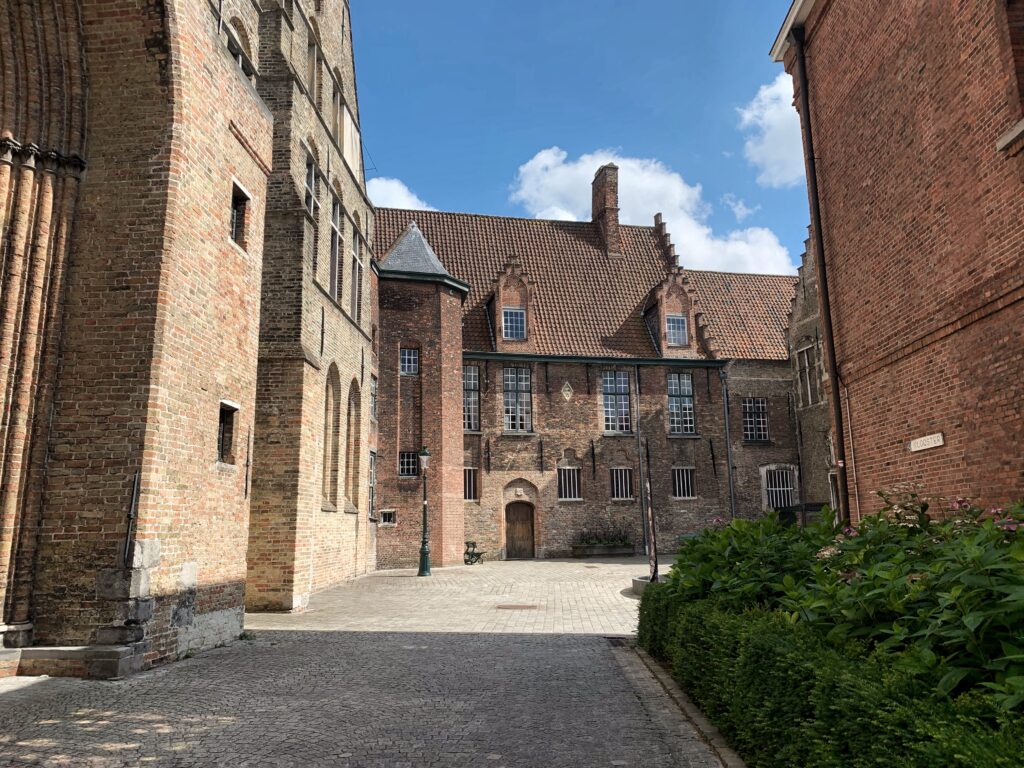
If you’re looking for that ‘classic Bruges view’ then you simply need to head to the Quay of the Rosary, which is known as the Rozenhoedkaai in Flemish. The viewpoint is at the precise location where the Dijver and Groenerei canals meet and allows visitors to enjoy a view of classic brick buildings framed with weeping willow trees.
If you happen to be in Bruges in the evening, then it’s also one of the best ways to see the city lights glittering in the reflection of the canal water. Nearby, you’ll soon find the Fish Market (which is still in operation a few days a week) and Tanners Square.

Beer aside, one of the biggest foodstuffs that Belgium is famous for is fries (chips). Known locally as frietjes, the best way to consume these deep fried potatoes is together with fritessaus (which is a kind of creamy mayo).
You should note that the price of mayo is often added onto the price of fries and another popular option of topping is a curry ketchup. Two of the best fries stalls can be found at the foot of the belfry. They’ve been in operation (and in competition!) for over 100 years!

Waffles, fries… and chocolate. If you’re a fan of sweet food then you most definitely can’t miss out on the chance to sample local Belgian chocolate while in Bruges.
The most famous chocolatier to have come from Bruges is undoubtedly Jeff de Bruges, though this famous chocolate shop can be found across Europe and is not exclusive to Brugge. As a chocolate lover’s paradise, when in Bruges there are plenty of other chocolate shops worth checking out as well.
Some of the top rated chocolatiers in Bruges include Chocolate Dumon, Pralinette, and The Chocolate Line. If the shop has a small picture outside or on the door which says ‘Gilde van de Brugse Chocolatiers,’ this means that the chocolates are handmade in Bruges.
Those looking to sample the local sweet treat, as well as learn more about the history of chocolate in Bruges, and Belgium as a whole, should be sure to book onto a Belgian chocolate workshop like this one .
Incredibly well-reviewed, highlights include making at least 30 chocolates to bring home with you, as well as discovering some of the techniques of chocolate making. Find more tour details here.

One of the more calm and quiet spaces to visit during your time in Bruges is the historic beguinage. The term ‘Beguinage’ comes from the French words ‘béguinage’, which is used to denote a housing complex which was constructed so as to house beguines.
These were religious women who lived together as part of a community but didn’t have to take any vows, relinquish their possessions, or retire from the world. Today, beguinages can be found all over Western Europe, but notably in Northern France, Belgium, and the Netherlands.
The beguinage of Bruges was founded in 1245 and women voluntarily practiced a life of religious devotion, though they were free to leave at any time. Today, the complex comprises of a central green space courtyard (though you’re not allowed on the grass) , a simple church, and 30 houses that were constructed in the 1500s.

If you’re looking to escape the hustle and bustle of the city crowds, then you might consider visiting the district of Minnewater (Lake of Love), which is where several green spaces can be found, as well as the Bruges beguinage.
Set a little outside of the historic city centre (so be sure to wear comfortable walking shoes if you’re planning a visit), here you’ll find wooded areas, peaceful views of the water encircling Bruges, and even a secret castle turned restaurant, Kasteel Minnewater.

After visiting the Grote Markt (the main central square of Bruges) , the next most famous city square is that of the Burg Square. Once the site of the former fortress of Bruges, today the area is home to the town’s Gothic city hall, as well as several other historic buildings. Be sure to bring your camera along because the gilded architecture and fanciful details of the buildings are truly a feast for the eyes.

Bruges actually has a rather unusual claim to fame in that beer literally flows through pipes beneath the city’s cobbled lanes. Around 2 miles worth of pipeline flow at a speed of 4,000 litres of beer an hour betwen De Halve Maan brewery and its bottling plant outside of the city centre.
Well, so iconic is the beer in Bruges that beer connoisseur and amateurs alike will probably enjoy a visit to 2be Beer where they can go beer tasting. The menus include explanations as to what certain beers taste like and the tasting centre also has a small shop selling souvenirs.
Though one of the more touristy things to do in Bruges, if you’re curious about beer culture then this is one of the better places to head to. Not to be missed is the world-famous ‘beer wall,’ which allegedly includes every single type of Belgian beer, all in one place, on shelves set up against a wall. For even more information, check out our Belgium beer guide.
The Basilica of the Holy Blood is so-called because it houses a relic which is allegedly Holy Blood that was collected by Joseph of Arimathea. The ecclesiastical building itself is a Romanesque and Gothic creation that was constructed in the 12th-century.

Yet another church that’s worth a visit during your time in Bruges is St Salvator’s Cathedral (known as Sint-Salvatorskathedraal in Flemish). This is the largest and oldest church in the city.
Rather interestingly, the now cathedral was originally built as a church and was never meant to serve as the main place of worship in Bruges. St Salvator’s has only enjoyed cathedral status since the 19th-century.

If you’re looking for one of the best rainy day activities in Bruges, then you should consider heading to one of the many Bruges museums located across the city. One of the more popular is that of the Groeningemuseum which features six centuries worth of Flemish and Belgian painting.
For those wishing to delve deeper into the history of Bruges, the Historium Bruges is the place to head to. Located within the famed market square, this museum is part experience and part museum and guides visitors through the history of Bruges, with a particular focus on the city’s ‘golden age’ through a virtual storytelling experience.
Steps away from Burg Square, one of the most narrow and charming streets in Bruges can be found in the form of Blinde Ezelstraat. Literally translated into English as the ‘Blind Donkey Street,’ the cobbled lane features several impressive brick buildings and an archway of the City Hall building.
Before visiting, you should note that this is one of the busiest and most crowded thoroughfares of the city and so it can be hard to enjoy its beauty among all the crowds. If possible, the best time to visit Blinde Ezelstraat is as early in the morning as you can and during the week if you’re able to.

Chocolate aside, Bruges is probably most associated with intricate lace making, and for this reason you’ll soon discover lace shops scattered across the city. Before heading to any souvenir shop to purchase some lace, be sure to ensure that it’s actually locally produced as much of the stuff found in the souvenir shops is not created in Bruges. For a more authentic lace experience, be sure to head to the Lace Centre.

Though it’s true that the majority of restaurants and other eateries in Bruges are tourist traps and should be avoided, that doesn’t mean that there are no tasty meals to be found in the city! Indeed, there are actually a fair few decent restaurants in the city.
During my most recent trip to Bruges, I really enjoyed eating lunch at That’s Toast ( Dweersstraat 4 ). This restaurant has plenty of vegan and vegetarian options and serves brunch style food and speciality coffees.
As you can imagine from the name, most of the dishes are based around toast. I personally enjoyed ‘the classic,’ which comprised of a hearty slice of toast topped with a poached egg, avocado, and asparagus.
One of the nicest things about the restaurant is that they also served free water. If you know anything about travelling to Belgium , then you’ll know that this is a rarity when it comes to Belgium restaurants!

One of the top things to know before you visit Bruges is that the city is incredibly touristic despite being very small. This means that if you visit in peak season; i.e. the summer season and especially during the weekend, then you’ll find that the place is incredibly crowded.
As such, the best time to visit Bruges is during the European shoulder season, i.e. during the spring or summer. For even more inspiration, be sure to check out our Belgium travel tips . And to know more about the pint-sized country, be sure to check out these fantastic facts about Belgium .
Next, you should note that, as with many cities in Europe, Bruges is home to lots of cobbled lanes. And as the best way to explore the city is on foot (much of the centre is not accessible by car), then you’ll want to wear comfortable walking shoes. Leave your high heels and instead opt to wear a cute pair of sneakers.

As Bruges is one of the most popular destinations in Europe, let alone Belgium, it’s incredibly easy to reach. From London, you can take the Eurostar to Brussels with a transfer in Bruxelles-Midi. From Paris, you can take an hour and a half Thalys before changing to a local train at Bruxelles-Midi.
Bruges is also a fairly popular day trip from Amsterdam with many tour companies, such as this well-reviewed one, offering day packages. Lastly, Bruges is one of the more popular day trips from Brussels and takes around an hour each way on a local train.
I personally recommend staying overnight in Bruges for several reasons. Firstly, so that you’re not rushed and take your time at all of the Bruges attractions, you’ll have ample time during an overnight trip.
Next, it’s pretty nice to be able to see Bruges without the crowds and you’ll be better placed to do this if you get up in the morning before the day trippers arrive. Check the best hotel prices in Bruges here.

As a very popular city (one of the most popular travel destinations in Europe), you’ll want to plan ahead and book your accommodation well in advance when it comes to visiting Bruges.
Another option if you want to save money could be to stay in Ghent or Brussels and see Bruges as a day trip. Otherwise, here are some of the best places to stay in Bruges based on location and web-reviews:
Snuffel Hostel: Just a ten minute walk away from the Belfry, this hostel offers a variety of different rooms including mixed and female only dorms. Other amenities include free Wi-Fi, breakfast, and baggage storage. Check prices and availability now.
Hotel Academie Bruges: A four-star hotel which is fairly affordable is Hotel Academie Bruges. Situated in the Onze-Lieve-Vrouw Quarter, colourful rooms are situated a stone’s throw away from all the major attractions in town. Check prices and availability now.
Hotel Dukes’ Palace: For the crème de la crème of Bruges accommodation, consider staying in the five-star Hotel Dukes’ Palace. Situated against the backdrop of a 15th-century palace, amenities include a spa and hot tub. Check prices and availability now.
Frequently asked questions about Bruges
As of 2021, the population of Bruges is around 120,000.
Those visiting Bruges on a budget will be pleased to know that, while Bruges is certainly pricier than many other Belgian destinations on account of its ever-increasing popularity, there are a number of low cost activities and attractions on offer.
Some of the best free things to do in Bruges include visiting the Basilica of the Saint Blood, wandering along the cbrugeanals of Bruges, discover In Bruges filming locations, and escaping the city to see the last of Bruges’ windmills.
Bruges is generally as safe as most other destinations in Europe, though petty crime can still occur. Visitors should be especially wary of pickpockets (which are present all over Europe, particularly in large crowds) . Never leave your valuables lying around or attended. I personally recommend always wearing a crossbody bag like these ones.
Enjoyed reading about the best things to do in Bruges? Pin this article now, read it again later:

Sophie Nadeau loves dogs, books, travel, pizza, and history. A Francophile at heart, she runs solosophie.com when she’s not chasing after the next sunset shot or consuming something sweet. She splits her time between Paris and London and travels as much as she can! Subscribe to Sophie’s YouTube Channel.
This site uses Akismet to reduce spam. Learn how your comment data is processed .
Sunday 7th of November 2021
Hi there, This Bruges info is great but do you know how to book tickets for Ice skating on Minnewater Lake? I have searched and cannot find a website
Sophie Nadeau
Tuesday 16th of November 2021
Thank you! I have done a bit of research and I don't think that you can book tickets in advance. However, I found the opening times and prices. They can be found on the official tourism website as follows: https://www.visitbruges.be/en/winter/artificial-ice-rink
Tuesday 3rd of August 2021
yes, we did almost all of these:) I'd love to go back for some more chocolate! canal boat ride was so beautiful
Monday 2nd of August 2021
hello Sophie you forget something important in Bruges " la Madonna " https://en.wikipedia.org/wiki/Madonna_of_Bruges
- Skip to primary navigation
- Skip to main content
- Skip to primary sidebar

Secret Bruges: 20 unusual things to do in Bruges away from the crowds
January 26, 2020 by Karen Turner 2 Comments
As someone who loves to escape the crowds and find strange things, I wanted to put together this post about the best off the beaten path things to do in Bruges because it’s great to get away from the crowds especially in peak season. Similarly, I found many of the attractions mentioned on many lists to be quite touristy. This list includes 20 alternative things to do in Bruges and I’ll see if I can add more unusual things on my upcoming research trips.
What a busy month that it’s been! I just arrived back from Bruges after beginning my guidebook research. I haven’t announced it yet on the blog, but I will be authoring a guidebook for Moon Travel Guides that will be focused on Bruges, Amsterdam, and Brussels. I’m very excited and I’ve been spending a lot of time in Bruges with Bruggelingens. It’s been a lot of fun practicing Flemish with the locals and I’m excited to show you how to get off the beaten track in Bruges with some secret spots in Bruges.

Note : Bruges (and much of Belgium) have a tendency to keep strange hours compared to many other places in Europe. Check hours/call ahead before heading to any of these places as many bars tend to be closed on Mondays, Sundays, and occasionally even Wednesdays in the off-peak season. During peak season, this is less of an issue, but Mondays might still be a closed day.
- 1 Have a drink at Retsin’s Lucifernum
- 2 See the Basilica of the Holy Blood
- 3 Go antique shopping on Langestraat/Hoogstraat
- 4 Explore the private church of Adornes Domain
- 5 Head to a volkscafe/praatcafe
- 6 Learn about life in Bruges at the Volkskundemuseum
- 7 Explore Bruges’ many almshouses
- 8 Go shopping for a picnic at the Saturday market on ‘t Zand
- 9 Have a drink at the oldest cafe in Bruges
- 10 Explore the picturesque home of famous poet Guido Gezelle
- 11 Discover literature at the Engels Klooster
- 12 Say hello to the kitties at Bruges’ cat cafe
- 13 Take a tour of the fascinating St Sebastiaan Royal Guild of Archers
- 14 Step into ‘t Apostelientije
- 15 Enjoy a picturesque walk along the quieter riverwalks
- 16 Step back into the shoes of a nun at the Begijnhof museum
- 17 See a show at the Koninklijke Stadsschouwburg Brugge
- 18 Discover Bruges’ stranger shrines
- 19 Learn about medical history at Sint-Janshospitaal
- 20 Discover Bruges’ quieter yet beautiful churches
- 21 Say hello to the sheep grazing at Hofje van Jonghe
- 22 Any other off the beaten path favorites of yours in Bruges that you’d recommend?
Have a drink at Retsin’s Lucifernum

I was a bit nervous coming here by myself on a sleepy Sunday night in January where I didn’t see a single soul on the streets. I rang the bell and a friendly woman greeted me. I paid the 10 euros entry fee, which includes a free drink. I should warn anyone reading this that the owner goes for shock value and some of the “art” and antiques are outright offensive, especially near the entrance.
Beyond this, you get to explore this strange mansion on your own with nobody accompanying you. Afterward, stop in for a drink with Willy Retsins himself, who might be the friendliest vampire that I’ve ever met, at his namesake bar only open on Sunday nights. We had a nice chat in Dutch between musicians playing the cimbalom and violin. The real reason to come here is for its speakeasy atmosphere, which is something out of a trippy dream. The cocktails are strong and delicious.
See the Basilica of the Holy Blood
This museum/church in Bruges is one of the more quirky churches to say the least and it’s beautiful to boot. Their relic is supposedly the blood of Jesus, which was taken to Bruges during the Crusades. More recent investigations show that this is likely a bottle from the 11th century, but it has been an important place for Bruges for ages.
I was recently here for the veneration of the relic, which was a really interesting and moving experience. This occurs in the afternoons almost daily in the church above, so be sure to pause for a moment to appreciate the beauty of this church along with the chance to see the relic upclose!
Go antique shopping on Langestraat/Hoogstraat
I stayed along Langestraat for part of my time in Bruges and it’s definitely one of my favorite neighborhoods. You’ll find a number of antique stores as well as oddity stores nearby. Depot D’o is for when I finally inherit a million euros. I particularly liked the selection of postcards at Winkel Oekraïense Hulpgroep , but needless to say, you’ll find lots of great shops. I really liked the selection at Madame Mim , which had some beautifully preserved dresses.
Explore the private church of Adornes Domain

One of my favorite attractions had to be the Adornes Domain, which is a private museum and chapel belonging still to the Adornes family. The museum discusses the very well-traveled and interesting ancestor who was murdered in Scotland. Most importantly, the Jerusalem chapel (with its strange shape!) was incredibly interesting and I dare say it, quirky. I particularly liked the fake crypt that you have to crawl into.
Head to a volkscafe/praatcafe
One of the most essential experiences that you can have in Bruges is to visit an old volkscafe/praatcafe. In Flemish, this means a community cafe or a talking cafe. These are simply old-school Flemish bars where everyone is there to chat, have a nice time, and enjoy some beer. The beer selection isn’t always as fancy as other places in the center of Bruges, but they’re nice places to drop into for a drink. I recommend bringing cash if you’re a tourist.
You’ll find a few in Bruges on the outskirts of the city center: In De Reisduif , De Kroon , and ‘t Hof van Beroep. Expect lots of lace, wood, and a nice place to get away from the tourists. I generally find people from Bruges to be very warm, friendly, and eager to chat with tourists, but I should note that I speak Dutch. (The locals tend to be impressed if you’re a non-native speaker who can speak it.)
Learn about life in Bruges at the Volkskundemuseum
One of Bruges’ quieter museum is the Volkskundemuseum, which focuses on life in Bruges in the 19th and 20th century. It recreates key establishments from this time within a beautiful almshouse with original items. There’s also a cafe where you can grab a drink called the De Zwarte Kat for the friendly black cat that lives in the bar.
Explore Bruges’ many almshouses

Bruges, like many places in Flanders and the Netherlands, is full of beautiful almshouses. These were houses constructed often for the poor and elderly. They’re incredibly beautiful and Bruges is spotted with many almshouses. Some feature stunning views of the city that are easy to miss, but it should be noted that this is private property. Please be respectful, quiet, and don’t litter.
I especially loved the view from Godshuis Spanoghe and Godshuis De Meulenaere. The door to De Meulenaere almshouse is absolutely beautiful and once you step inside, you’ll definitely want to pause to enjoy the view. It was too cold to sit in the garden last time I was there, but I will come back in summer with a book to read here. I also found the De Vette Vispoort almshouse (shown above) to be a beautiful respite from the crowds.
Go shopping for a picnic at the Saturday market on ‘t Zand
Do like the locals and head to ‘t Zand starting at 7:30 am on Saturday mornings to avoid the crowds. There’s a stall open for coffee where about a euro will get you a coffee with no additions to enjoy as you explore the market. This is the major market in Bruges and it’s crowded with locals doing their weekly shopping.
I went with one starting at 7:30 am who comes weekly to pick up fresh bread, meat, and old Bruges cheese for the week. I have a similar routine and I had a lot of fun exploring the market with Hendrik. You’ll also find fabrics, home-goods, and fruit.
Have a drink at the oldest cafe in Bruges

The oldest cafe in Bruges is Cafe Vlissinghe, which dates back to 1515. Although the food is not worth ordering, it’s worth coming here to enjoy a drink. I had their house beer and spent a while lingering next to the old school Flemish heater. I want to write the rest of my book sitting in one of their chairs by the fire in a notebook. In summer, you can also enjoy their spacious garden.
Explore the picturesque home of famous poet Guido Gezelle
Guido Gezelle is a famous Dutch poet who was born-and-raised in Bruges. You can visit the house where he was born to find out more about his life as a monk and a writer, which is located in a picturesque fairytale-esque house along one of the prettiest quiet alleyways in Bruges. (You can enter the garden without a ticket.)
Discover literature at the Engels Klooster

The Engels Klooster has been open to visitors. This cloister in the middle of Bruges is home to nuns who will give you a tour of this stunning cloister. Starting in 2020, they will be opening the cloister with a guide (not a nun) to visitors to show off priceless works of literature within their collection. This needs to be booked online.
Personally, I am a fan of the convent tour, which is possible on certain days. One of the nuns will show you around their stunning convent, including the church. Be sure to ask about the portrait of Thomas More and the frame. If you’re lucky, they’ll sing for you. Ring the bell and come inside between 2pm-3:30 and 4:15pm-5:30pm on Thursday-Saturday to peek inside. (They might be open other days ( closed Sunday ), but I feel more confident about writing Thursday to Saturday. ) Bring cash to buy a postcard or make a donation.
Say hello to the kitties at Bruges’ cat cafe

One of the newest additions to Bruges is the Kattencafé Puss and Books. This cash-only cafe features kitties available for adoption taken from kill shelters. They serve coffee and cakes. It’s a simple concept, but wonderful.
Take a tour of the fascinating St Sebastiaan Royal Guild of Archers
One of the secret places to visit in Bruges that many people don’t know about is the St. Sebastiaan Royal Guild of Archers, which is an active archers’ guild operating for 600+ years. The British Royal family are members and don’t miss the 16th-century archery range if they’re open. The tower is quite wild and if you can’t get in, you can at least admire the view of the giant sail from Bruges’ windmills. You need to call ahead in the afternoon on Thursdays if you’re to visit.
Step into ‘t Apostelientije
This beautiful lace shop close to the lace museum shows off lace antiquities within an old godshuis . The owner, Anna, is incredibly knowledgable about the techniques used and even labeled many of the displays. She has some more affordable pieces, but it is absolutely stunning and it feels like a portal to another world once you enter. It’s as far from a tourist trap as you can imagine! Cash only.
Enjoy a picturesque walk along the quieter riverwalks

Although people typically say canals in Bruges, the water around the city is called reien in Flemish for the river Reie that once flowed through Bruges. Some of the canals are where the river originally flowed although canals were dug through the city center to make Bruges more accessible to trade by sea. You’ll find many picturesque walks through Bruges once you leave the center. I especially loved Langerei as it’s quiet and it feels like the heart of the city away from the crowds. The walk along Grauwwerkersstraat is also nice as you can peek into hidden gardens! Speelmansrei also feels forgotten.
Step back into the shoes of a nun at the Begijnhof museum
One of the most underestimated museums of Bruges has to be the Begijnhof museum, which is hidden within Bruge’s Begijnhof. I didn’t include the courtyard itself, which is the last active convent of this kind in Bruges, as it’s fairly well-known. Still, the museum is often skipped by visitors. Within the museum, you can explore what would a nun’s house from the 19th century. It’s only 2 euros to go inside.
See a show at the Koninklijke Stadsschouwburg Brugge
Many people don’t know about the Koninklijke Stadsschowburg. A friend of mine works at a historic theatre in the Netherlands and although I never really got into these before this, these old theatres are absolutely beautiful. The one in Bruges is from 1869 and it’s a beautiful building that you’ll want to visit if you happen to see a show that meets your eye.
Discover Bruges’ stranger shrines

The almshouse of Rooms Convent ( Katelijnestraat 9) had an interesting little shrine that I spent a while admiring. If the door is open, take a peek inside! My other favorite had to be the small and bizarre shrine on the corner of Carmersstraat and Korte Speelmansstraat that is dedicated to a girl who was tossed down a well–and survived thanks to ice at the bottom.
Learn about medical history at Sint-Janshospitaal
One of the most off the beaten path museums in Brugge has to be Sint-Janshospitaal, which discusses the history of this 12th-century hospital/church. It’s an odd combination of religious art, triptychs, and medical tools used at the time. Your ticket also includes entry to the pharmacy next door.
Discover Bruges’ quieter yet beautiful churches
Although Onze-Lieve-Vrouwe dominates the church scene (rightfully so!), there are so many lovely churches in Bruges worth discovering that are beautiful. Our Lady of the Pottery has a similar history to Sint Jans Hospital, however it is a beautiful church in itself. Women still celebrate the Bruges’ Promise each year by having 12 girls carry a candle in a procession.
Say hello to the sheep grazing at Hofje van Jonghe
Hidden in one of the quieter residential neighborhoods of Bruges, you’ll find this small old courtyard that has three resident sheep that graze here. Need I say more?
Any other off the beaten path favorites of yours in Bruges that you’d recommend?

About Karen Turner
New Yorker–born and raised. Currently living in the Hague, the Netherlands after stints in Paris and Amsterdam. Lover of travel, adventure, nature, city, dresses, and cats.
Reader Interactions
February 18, 2020 at 8:53 pm
Next time make sure to visit the StAnna church
May 3, 2023 at 1:10 am
I was born in Brugge in 1938 and lived there until my departure to the USA on a professors assignment for 2 years,…..and I Am still here since 1963!! I return to my hometown at least once a year to admire its history as well as how beautifully it has changed! You have done a great job and obviously like/love the town!! Its mystique starts after the sun sets and the street lights go on,…..making the scenery a grown-ups dream world,…..and the silence in the narrow streets of the old town can almost be heard!!
Leave a Reply Cancel reply
Your email address will not be published. Required fields are marked *
- The Netherlands
- New York State
- Other European destinations
- Work With Me
- Disclosure and Privacy Policy
- Jeju SEO Tool: Free SEO Writing Tool
You can unsubscribe anytime. For more details, review our Privacy Policy.
You have successfully joined our subscriber list.
TreasureHunter USA Inc. 251 Little Falls Drive Wilmington, Delaware 19808 +1 (915) 4632387 EIN 88-2174128
www.wanderlustingk.com is a participant in the Amazon Services LLC Associates Program, an affiliate advertising program designed to provide a means for sites to earn advertising fees by advertising and linking to amazon.com. As an Amazon Associate, we earn from qualifying purchases. We also participate in other affiliate programs
www.wanderlustingk.com all rights reserved © 2023 | Privacy Policy | Cookie Policy |

Bruges Canal Tours: Everything You Need To Know
We may earn money or products from the companies mentioned in this post. As an Amazon Associate, I earn from qualifying purchases.
During our recent family trip to Europe, Abby and I took a day trip from Brussels to Bruges , a beautiful town in Belgium. We both wanted to go on one of the legendary Bruges canal tours. I’m so glad we did! This fairytale European city needs to be on your bucket list!
Where is Bruges?
Bruges is a serene small Flemish town just northwest of Brussels . Visiting Bruges is a perfect day trip from Brussels and is easily accessible by train.
Bruges is known as an idyllic small European city steeped in historical charm. It’s home to gorgeous canals and many fascinating landmarks. Furthermore, The city also has many great restaurants, pubs, and street-side vendors.
Visiting Bruges, Belgium
If you are visiting Brussels for a few days, taking an extra day to go to Bruges is well worth the time. Its gorgeous canals winding along against ancient stone buildings have led Bruges to be called the “Venice of the North.”
In this blog post, I want to provide information about taking a Bruges canal tour, highlight the city’s history, and discuss some landmarks you’ll likely see on these Bruges canal tours.
Getting to Bruges from Brussels
From Bruges, you just need to hop on the Belgium intercity train. You can board directly from one of the main Brussels train stations, including Bruxelles-Nord (Brussels North), Bruxelles-Central (Brussels Central), and Bruxelles-Midi (Brussels South).
The Brussels to Bruges train runs all day, and the ride is just over an hour.
The Belgium train website has a dedicated page for the Brussels to Bruges train route , which is a great resource. You can buy tickets from that page as well.
The route trip Brussels to Bruges train tickets are a standard € 32.00 for adults. However, there are a lot of discounted ticket options listed as well, and most are € 17.50 or less.
The Bruges Canal Tours
Once you arrive in Bruges, you should have a game plan for your canal tour. It’s helpful to know a little bit about the city's layout.
Bruges rests within a mesh of several canals that penetrate and encircle the city. These canals ultimately allow boat access to the North Sea, located about 20 kilometers north of the city. The town’s access to the North Sea made Bruges a vital shipping hub for centuries.
The canals lining the town are relatively inaccessible as they are flanked everywhere by houses and other structures. Because of this, there are only a few places, other than bridges, where you can see the canals.
Therefore, the best way to see these picturesque canals is on a boat tour!
Planning Bruges Canal Tours
There are five landing stages along the canals. These are the only places you can embark on a canal tour. The routes and prices are generally the same across the different tour operators. There are several canal tour operators, each with their own open-air boats. They pretty much all follow the same route, so in my opinion, the best Bruges canal tour is the one with the shortest line.
Bruges Canal Tour Boarding Locations
Boarding takes place at the following locations. Each tour operator will leave from a different location, so be sure to check their website.
- Michielssens, Huidenvettersplein 13
- Coudenys, Rozenhoedkaai
- De Meulemeester, Wollestraat 32
- Gruuthuse, Nieuwstraat 11
- Stael, Katelijnestraat 4
Scroll around the above map of Bruges to get a lay of the land!
The Bruges Canal Tour boat trip takes around 30 minutes. The boats typically operate between 10:00 am and 6:00 pm, with 5:30 often being the last tour. Tours generally operate most of the year, except in January and early February.
However, tour availability will vary by operator and may change based on events like municipal construction projects, canal restoration initiatives, and severe weather.
Bruges Canal Tours Tickets
Unlike the canal tours in Amsterdam and the Seine River cruises in Paris , you cannot book Bruges canal tour tickets in advance. You buy your tickets directly from the tour companies at the landing stages. As of writing this, the Bruges Canal Tour price for adult tickets is € 12.00, and children’s tickets are € 7.00.
You may need to wait in line at the landing stages to purchase tickets. The canal tours are very popular and will get busy. Bruges has an active cruise ship industry (Norwegian, Holland America, Windstar, Celebrity), and the town will fill up with cruise passengers on day excursions.
The extra traffic means lines for the canal tours will get longer after about 11 am. Before 11 am is the best time to ensure you have shorter lines. It also gives you the rest of the day to explore Bruges.
TIP: Get in line for your canal tour as early as possible in Bruges.
Private canal tours are also available. Several companies offer tours with different types of boats. Contact the companies directly to find out more.
There are a couple of great s mall-group Bruges canal tours available through Get Your Guide . They also include a Bruges walking tour. These are a great option if you want to be able to buy Bruges canal tour tickets in advance.
Other Things to Consider
During the canal tour, the boat guide will comment on the significant landmarks and history of the area. During our day trip to Bruges , our canal tour guide did a great job narrating the tour and pointing out interesting areas, landmarks, and historical sights. Most guides can speak multiple languages and will do their best to tailor the language to the passengers’ needs.
The boats are cash-only. Be sure to bring a few Euros to tip your tour guide.
If you want to take pictures, try to be at the front, back, or side of the boat. Most of the boats have a line of seats down the middle, but people may block your pictures if you sit there.
The boats are open-air and uncovered, so be sure to wear your sunscreen! Also, the tours can get pretty chilly, depending on the time of year, so bring a jacket. We love the Amazon Essentials packable jackets for our travels.
It’s always helpful to know the history and significance of a city prior to visiting. So, I want to take some time here to talk more in-depth about Bruges and, of course, the canals. Then, I will share some of the incredible landmarks that you will see from your Bruges canal tour.
The History Of Bruges And Its Canals
Bruges has witnessed a remarkable evolution over the centuries. Its history encapsulates the ebb and flow of urban development, from its Viking origins to a flourishing medieval center, economic decline, and eventual modern-day revival.
The city’s tremendous ability to adapt to changing circumstances and preserve its cultural heritage is a testament to the strength and perseverance of the Danish people across time.
Origins of Bruges, Belgium
The origin of Bruges can be traced to the 9th century when Vikings established a fortress on the banks of the Reie River. The name “Bruges” is believed to be derived from the Old Dutch word “Burg,” meaning fortress. The city gradually developed into a bustling medieval trade center due to its strategic location and access to the North Sea.
The Golden Era of Bruges
Bruges experienced its golden era during the late medieval period, particularly in the 14th and 15th centuries. The city became a major commercial and cultural hub, attracting merchants, artists, and scholars across Europe.
Bruges's thriving wool and textile industry and sophisticated network of canals contributed to its prosperity. It was home to the influential Bourse, one of the earliest stock exchanges in the world.
Bruges Economic Decline
Despite its flourishing period, Bruges faced economic challenges in the 16th century. The silting of the Zwin, a vital waterway for trade, led to a decline in maritime activity, impacting Bruges’ economy.
Additionally, geopolitical shifts and the rise of other European trading centers contributed to the city's gradual decline in prominence.
Modern Times and Revival of Bruges
For several centuries, Bruges endured a period of relative obscurity. However, in the 19th century, efforts were made to preserve its medieval architecture, and the city gained recognition as a UNESCO World Heritage site in 2000.
The 20th century saw a revival in Bruges’ fortunes, with tourism becoming a key driver of its economy. The city’s well-preserved medieval structures, including the Belfry of Bruges and the Basilica of the Holy Blood, attract millions of visitors annually.
What Do You See on the Bruges Canal Tours?
During the Bruges canal tours, your tour guide will highlight many fascinating landmarks. Each place gives you a window into the long history of this amazing city.
Like many European cities, it’s steeped in lore that spans epochs, and seemingly every bridge or building has a colorful and long legacy.
Here is a list of many sites you will probably see on the Bruges canal tours.
Founded in 1245, the Princely Beguinage Ten Wijngaarde boasts serene white-colored house fronts and a tranquil convent garden.
This UNESCO World Heritage site was once the residence of beguines—emancipated laywomen leading pious and celibate lives. Today, the beguinage is home to the Order of St. Benedict nuns.
Saint John’s Hospital
With an eight-hundred-year history, Saint John’s Hospital has cared for pilgrims, travelers, the poor, and the sick. Explore the medieval wards where nuns and monks practiced mercy, the chapel, and a remarkable collection of archives, artworks, medical instruments, and six paintings by Hans Memling.
Church of Our Lady
The Church of Our Lady showcases Bruges’ artisans’ craftsmanship through its 115.5 meters high brick tower. The church has valuable art, including Michelangelo’s renowned Madonna and Child, numerous paintings, 13th-century painted crypts, and the tombs of Mary of Burgundy and Charles the Bold. Abby and I visited after our canal tour, and it was incredible!
Groeninge Museum
Offering a diverse overview of Belgian plastic arts history, the Groeninge Museum features Flemish Primitives, 18th and 19th-century neoclassical pieces, Flemish Expressionism masterpieces, and post-war modern art.
Ambachtshuis Huidevetters
Built by hide tanners, this craft house near Rozenhoedkaai has two wings. The north wing, demolished in 1629, was replaced in 1630 under the guidance of Bruges architect Jan De Smet. The building was restored in 1912. It has been used as a fishmonger and stockfish farm since the mid-19th century.
Belfry & Carillon
Bruges’ tallest tower, the Belfry, standing 83 meters tall, houses a melodic carillon with 47 bells. Climbing its 366 steps rewards you with a breathtaking panoramic view of Bruges and its surroundings.
Fish Market
Originally located at Markt Square, the fish market was moved here in the 18th century due to complaints about the stench. Since the Middle Ages, buyers and sellers have come together at the Bruges fish market. Fresh saltwater fish, once a luxury, is still sold every morning from Wednesday to Saturday.
These small whitewashed almshouses, dating back to the 14th century, are scattered around Bruges. Wealthy townspeople or guilds established almshouses to house poor older adults or widows. Over 46 blocks have been preserved, with 43 still occupied.
Burghers’ Lodge
Situated on Jan Van Eyckplein, the Poortersloge (Burgher’s Lodge) served as a meeting spot for the Society of the White Bear in the late 14th and early 15th centuries. Later, it became the city’s Academy of Arts (1720-1890) and the State Archives (1912-2012).
Visiting Bruges: The “Venice of the North”
Visiting Bruges to take one of the Bruges canal tours is a fantastic way to add something special to your trip to Belgium. Its quaint stone houses, romantic canals, cobbled streets, cookies, waffles, and chocolate make it a bucket-list destination to take friends and family of any age.
The iconic canals are a dream for photographers. Travel to and around the city is simple and inexpensive. And as you can tell by this post, Bruges canal tours should be on your list. I recommend this trip to everyone!
Visit the European Travel section of my blog for more adventures in Europe, and you may also enjoy the related posts below.
Our Magical Brussels To Bruges Day Trip
2 Days in Brussels: What We Did
Hotel Indigo Brussels City
European Travel Essentials
How To Plan A Trip To Europe For Your Family
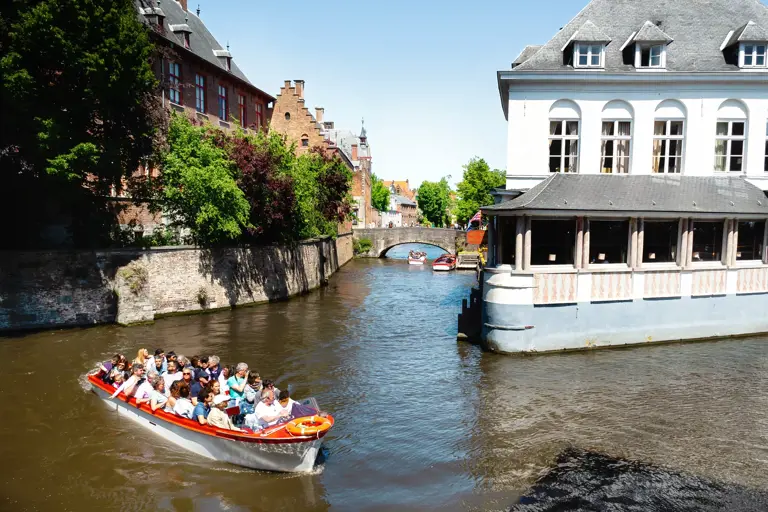
The Ultimate Guide To Traveling From London To Bruges
- Last updated May 09, 2024
- Difficulty Advanced
- Category Travel

London and Bruges, two historic cities that have captivated visitors for centuries, offer a journey through time and culture. Whether you're a history buff, an art lover, or simply want to indulge in delicious cuisine, traveling from London to Bruges is an experience that should not be missed. In this ultimate guide, we will delve into the various options for transportation, highlight the must-see attractions, and provide insider tips to enhance your journey. Embark on an adventure of a lifetime as we explore the enchanting route from London to Bruges.
What You'll Learn
Introduction: exciting options for travelling from london to bruges, by eurostar: convenient and fast travel from london to bruges, by ferry: enjoy a scenic journey from london to bruges, by car: explore at your own pace while driving to bruges.

If you're planning a trip from London to Bruges, you're in for a treat! This picturesque Belgian city is known for its charming canals, medieval architecture, and delicious chocolate. Fortunately, getting there is easier than you might think. In this blog post, we'll explore the various options available for travelling from London to Bruges, so you can choose the one that suits your preferences and budget.
Eurostar Train:
One of the most popular and convenient ways to travel from London to Bruges is by taking the Eurostar train. This high-speed train service connects London St Pancras International with Brussels Midi, where you can transfer to a local train to Bruges. The Eurostar journey from London to Brussels takes approximately 2 hours, and the transfer to Bruges adds another hour. Trains run multiple times a day, giving you flexibility in planning your trip.
Ferry and Train:
If you prefer a more scenic route, you can opt for a combination of ferry and train travel. Several ferry operators offer services from various ports in southern England to Belgium. From Dover, you can take a ferry to Dunkirk or Calais, which are both approximately 1.5 hours away from Bruges by train. Alternatively, you can take a longer ferry journey from Harwich to the Hook of Holland, and then catch a train to Bruges.
If you're looking for the quickest option, flying from London to Bruges is a viable choice. Brussels Airport is the closest major airport to Bruges, with plenty of flights from London airports, including Heathrow, Gatwick, and City. From Brussels Airport, you can take a train directly to Bruges, which takes around 1.5 hours. This option is particularly convenient if you're short on time.
Travelling by coach or bus is a budget-friendly option for those willing to trade time for cost savings. Several coach companies operate services between London and Brussels, with some offering connections to Bruges. However, keep in mind that this is the slowest option, as the journey can take around 6-7 hours, depending on traffic and stops.
No matter which option you choose, travelling from London to Bruges is an exciting adventure waiting to happen. Whether you prefer the convenience of the Eurostar train, the scenic ferry and train combination, the speed of a flight, or the budget-friendly coach option, each has its own unique experiences to offer. So pack your bags, grab your camera, and get ready to explore the cobblestone streets and captivating beauty of Bruges. Bon voyage!
Understanding the Importance and Process of a Travel Visa for Australia
You may want to see also
If you're planning to travel from London to Bruges, taking the Eurostar is a convenient and fast option. This high-speed train service connects the two cities, making it an excellent choice for travelers. Here's a step-by-step guide on how to travel from London to Bruges by Eurostar.
- Start by booking your Eurostar tickets: You can book your Eurostar tickets online or through a travel agent. It's recommended to book your tickets in advance to secure the best prices and availability. The journey from London to Bruges usually involves a transfer at Brussels Midi/Zuid station, so make sure to select the appropriate tickets.
- Arrive at St Pancras International: The Eurostar departs from St Pancras International station in London. Make sure to arrive at the station well in advance, as check-in and security procedures can take some time. It's recommended to arrive at least 45-60 minutes before your scheduled departure.
- Check-in and security: Once you reach St Pancras International, proceed to the Eurostar check-in area. Have your tickets and passports ready for the check-in process. You'll also need to pass through security, so ensure that your belongings comply with the regulations. Once you've completed the check-in and security procedures, head to the designated platform.
- Board the Eurostar: When it's time to board the Eurostar, follow the signs to the appropriate platform. Ensure that you're boarding the correct train, as there may be multiple departures around the same time. The staff at the station can assist you if you have any questions or concerns.
- Travel to Brussels: The first leg of your journey will take you from London to Brussels. The Eurostar is a fast and comfortable train, offering a smooth ride. Enjoy the onboard amenities, such as power outlets, Wi-Fi, and the option to purchase food and drinks during the journey. The train will take approximately 2 hours to reach Brussels Midi/Zuid station.
- Transfer at Brussels Midi/Zuid station: Upon arrival in Brussels, you'll need to transfer to a connecting train to Bruges. Follow the signs to the appropriate platform for your train to Bruges. Brussels Midi/Zuid station is a major transportation hub, so be sure to check the departure boards for your train's platform number.
- Continue to Bruges: The next leg of your journey will be on a regional train from Brussels to Bruges. These trains are frequent, and the journey usually takes around an hour. Be sure to check the departure time and platform number before boarding your train.
- Arrive in Bruges: Once you arrive at Bruges station, you're just a short distance away from the city center. You can take a taxi, hire a bicycle, or even walk to your hotel or desired destination.
Traveling from London to Bruges by Eurostar is a convenient and efficient way to reach this charming Belgian city. With direct connections and a comfortable journey, you'll be able to enjoy your trip from the moment you board the train. So, book your tickets, pack your bags, and get ready to explore the beautiful city of Bruges.
Does Visa Offer Travel Insurance?
Are you planning a trip from London to Bruges? Why not consider taking a ferry instead of the more common options like flying or taking a train? The ferry route from London to Bruges offers a unique and scenic journey that allows you to relax and enjoy the stunning views of the sea.
To travel from London to Bruges by ferry, you'll first need to make your way to the port. There are several ferry ports in London, but the most popular and convenient option is the Port of Dover. From London, you can either take a train or a coach to Dover. Trains from London St Pancras International to Dover Priory Station run frequently and take about two hours, while coaches from Victoria Coach Station take around two and a half hours.
Once you arrive at the Port of Dover, you can board a ferry to Calais in France. The ferry journey takes approximately 90 minutes, and during this time, you can relax and enjoy the onboard facilities such as shops, restaurants, and comfortable seating areas. Marvel at the stunning views of the white cliffs of Dover as you sail across the Channel.
Upon arrival in Calais, you'll need to make your way to Bruges. The easiest way to do this is by taking a direct train from Calais to Bruges. The journey takes around two hours, and there are several trains available throughout the day. Make sure to check the train schedule in advance to plan your journey.
Once you arrive in Bruges, you'll be greeted by the charming canals, medieval architecture, and cobblestone streets that define this picturesque city. Bruges is known for its beautiful historic buildings, including the famous Markt square and the Belfry tower. Don't forget to take a boat ride along the canals and try some delicious Belgian chocolate and beer during your visit.
When it's time to return to London, simply follow the same route in reverse. Take a train from Bruges to Calais, board the ferry back to Dover, and then make your way back to London either by train or coach.
Traveling from London to Bruges by ferry offers a refreshing alternative to other modes of transportation. Not only will you get to enjoy a scenic journey, but you'll also have the opportunity to relax and unwind onboard the ferry. So, why not consider taking the ferry on your next trip from London to Bruges?
Exploring the Possibilities: What If I Don't Travel After Obtaining a Visa?
If you are planning a trip from London to Bruges, one of the best ways to travel is by car. Driving allows you to explore at your own pace and provides the convenience of having your vehicle with you throughout your journey. Here is a detailed guide on how to travel by car from London to Bruges.
Firstly, make sure that you have all the necessary documents for driving in both the UK and Belgium. You will need a valid driver's license, proof of insurance, and the vehicle's registration documents. It is also a good idea to have an up-to-date road map or a GPS device to help you navigate your way.
The approximate distance between London and Bruges is around 175 miles, and the journey takes around 3-4 hours, depending on traffic conditions and the route you take. There are a few different routes you can choose from, depending on your preferences and the time you have available.
One popular route is to take the M20 and then the Eurotunnel or the ferry from Dover to Calais. From Calais, you can take the A16/E40 motorway towards Dunkirk and then continue on the E40 towards Bruges. This route is convenient and offers the flexibility to choose between the Eurotunnel and the ferry, depending on your preferences.
Another option is to take the M25 and then the M2 towards Dover. From Dover, you can take the ferry to Calais and then follow the same route mentioned above. This route is slightly longer but offers the opportunity to enjoy scenic coastal views along the way.
Once you arrive in Bruges, it is important to familiarize yourself with the local traffic rules and regulations. Pay attention to parking signs and be aware of any restricted areas. There are several parking lots available in Bruges, both in the city center and on the outskirts. It is recommended to park your car in one of these designated areas and explore the city on foot or by using public transportation.
While driving in Bruges, keep in mind that the city has narrow streets and can be quite busy, especially during peak tourist season. Be cautious and patient, and always yield to pedestrians and cyclists. Most of the main attractions in Bruges are within walking distance from each other, so you may prefer to park your car and explore the city on foot.
Overall, traveling by car from London to Bruges is a convenient and flexible option. With careful planning and attention to local traffic rules, you can have a smooth and enjoyable journey. So grab your car keys, buckle up, and get ready to explore the charming city of Bruges at your own pace!
How Does Minigun Spin Affect Bullet Travel?
Frequently asked questions.

- Karli Trujillo Author Editor Reviewer

- Naim Haliti Author Editor Reviewer Traveller
It is awesome. Thank you for your feedback!
We are sorry. Plesae let us know what went wrong?
We will update our content. Thank you for your feedback!
Leave a comment
Travel photos, related posts.

The Nomadic Explorers of Soccer: Unearthing the Most Traveled Team on the Pitch
- May 10, 2024

Traveling While Your O1 Visa is Renewing: What You Need to Know
- Mar 31, 2024

Understanding Travel Restrictions: Can Travelers Enter Florida Amidst the Pandemic?
- May 13, 2024

Understanding the Importance of a US Visa as a Travel Document
- May 07, 2024

Tips for Keeping Your Soap Dry While Traveling
- May 12, 2024

Changing Your Traveler to Geo: A Step-by-Step Guide
- May 08, 2024

Promotions apply when you purchase
These promotions will be applied to this item:
Some promotions may be combined; others are not eligible to be combined with other offers. For details, please see the Terms & Conditions associated with these promotions.

Download the free Kindle app and start reading Kindle books instantly on your smartphone, tablet, or computer - no Kindle device required .
Read instantly on your browser with Kindle for Web.
Using your mobile phone camera - scan the code below and download the Kindle app.

Image Unavailable

- To view this video download Flash Player
GREAT BRUSSELS AND BRUGES TRAVEL GUIDE 2024-2025: A Journey to Discover the Timeless Charm, Hidden Gems, Modern Delights, Culture, and Unforgettable Experiences in The Heart of Europe Kindle Edition
- You'll Get to Discover the Overview of Belgium
- You’ll know the Belgian Waffles, and Chocolate
- You’ll learn about Steeple of Bruges
- You’ll learn about the Belgian Coastline: Blankenberge and Knokke-Heist
- You'll Get to Know how to Making Money While Traveling in Brussels and Bruges (2024-2025)
- Print length 123 pages
- Language English
- Sticky notes On Kindle Scribe
- Publication date May 11, 2024
- File size 1458 KB
- Page Flip Enabled
- Word Wise Enabled
- Enhanced typesetting Enabled
- See all details
Product details
- ASIN : B0CW6L6V8R
- Publication date : May 11, 2024
- Language : English
- File size : 1458 KB
- Simultaneous device usage : Unlimited
- Text-to-Speech : Enabled
- Screen Reader : Supported
- Enhanced typesetting : Enabled
- X-Ray : Not Enabled
- Word Wise : Enabled
- Sticky notes : On Kindle Scribe
- Print length : 123 pages
Customer reviews
Customer Reviews, including Product Star Ratings help customers to learn more about the product and decide whether it is the right product for them.
To calculate the overall star rating and percentage breakdown by star, we don’t use a simple average. Instead, our system considers things like how recent a review is and if the reviewer bought the item on Amazon. It also analyzed reviews to verify trustworthiness.
No customer reviews
- Amazon Newsletter
- About Amazon
- Accessibility
- Sustainability
- Press Center
- Investor Relations
- Amazon Devices
- Amazon Science
- Sell on Amazon
- Sell apps on Amazon
- Supply to Amazon
- Protect & Build Your Brand
- Become an Affiliate
- Become a Delivery Driver
- Start a Package Delivery Business
- Advertise Your Products
- Self-Publish with Us
- Become an Amazon Hub Partner
- › See More Ways to Make Money
- Amazon Visa
- Amazon Store Card
- Amazon Secured Card
- Amazon Business Card
- Shop with Points
- Credit Card Marketplace
- Reload Your Balance
- Amazon Currency Converter
- Your Account
- Your Orders
- Shipping Rates & Policies
- Amazon Prime
- Returns & Replacements
- Manage Your Content and Devices
- Recalls and Product Safety Alerts
- Conditions of Use
- Privacy Notice
- Consumer Health Data Privacy Disclosure
- Your Ads Privacy Choices

IMAGES
VIDEO
COMMENTS
Bruges Triennial. Every three years the Triennial Bruges brings contemporary art and architecture to the historic city centre of Bruges: a unique setting and a UNESCO World Heritage Site. Triennial Bruges will take place from 13 April 2024 through 1 September 2024. Read more.
Bruges is one of the most picturesque cities in Northern Europe, with photo opportunities awaiting you around every corner. The medieval city center survived multiple invasions and wars over the last 500 years, yet miraculously kept its 15th-century architecture intact - an achievement that won it UNESCO World Heritage status in 2000.
Kyle McCarthy|Sharael Kolberg December 4, 2023. Ranking of the top 17 things to do in Bruges. Travelers favorites include #1 Rozenhoedkaai, #2 Historic Centre of Brugge and more.
Most visitors consider 2 days in Bruges to be the sweet spot for getting to know the city without running out of things to do. Within two days, you can catch the central landmarks, wander the quaint cobblestone streets, and devour a stack of Belgian waffles. You'll see a good amount of the city with a pretty packed itinerary.
Finally, after a tiring 366 steps, your efforts will be rewarded with a breath-taking and unforgettable panoramic view of Bruges and her surroundings. 3. Luc Vanlaere Harpist - Mini Harp Museum. Harp concerts by harpist/composer Luc Vanlaere, duration approx. 40 minutes, visit of small harp museum after the concert.
Don't miss this handy Bruges travel guide - what to see, the best time to visit, where to stay and other travel tips for the perfect trip. Bruges (Brugge in Flemish) is, quite frankly, one of the most beautiful cities in Europe. A maze of gorgeous canals twinkling in the sun, quirky buildings with stepped roofs and elaborate patterns - it ...
Compact and chock-full of photogenic landmarks — notably the Belfry of Bruges and 14th-century Stadhuis (City Hall) — the capital of West Flanders is prime for walking tours and aimless wandering.
Europe. If you set out to design a fairy-tale medieval town, it would be hard to improve on central Bruges (Brugge in Dutch), one of Europe's best preserved cities. Picturesque cobbled lanes and dreamy canals link photogenic market squares lined with soaring towers, historical churches and lane after lane of old whitewashed almshouses.
Top 12 sights in Bruges. You've only really seen Bruges if you've visited the classics. From the Rozenhoedkaai and the Market Square, through the Lake of Love and the canals, to the Beguinage, the almshouses and much more. Iconic sites that give the city its look and charm you instantly. Now centuries old, now dazzlingly young, but always ...
As one of the most well-preserved medieval cities in Western Europe, visiting Bruges is a chance to travel back in time. In fact, the historic centre of Bruges is so historically significant that it has been appointed a UNESCO World Heritage Site. Full of quaint charm and a fairytale aesthetic, Bruges is an intimate city that doesn't try to ...
Belgium is a popular weekend city break from London and the high-speed Eurostar trains will get you there in around 3.5 hours. Leaving from London St. Pancras Station, there is one transfer from Brussels (Bruxelles-Midi Station) to Bruges ( Brugge in Dutch). The Eurostar will arrive in Brussels after about 2 hours 20 minutes, then you will need ...
The closest major airport is Brussels Airport (BRU), so most visitors take the train into Bruges. The ride from the airport to Bruges is about 90 minutes; tickets start at 21 euros (or around $23 ...
The Burg. Bruges' iconic Gothic square sits at the heart of the city and is a perfect example of quintessential Gothic architecture and Flanders culture + design. The Stadhuis (Town Hall) is a must see with its original 1376 design in tact. Take a tour inside to spot the original wooden ceiling on the first floor.
Bruges Travel Guide: Money-Saving Tips. Bruges, a city that seems designed for older travelers and couples, is not a cheap place to visit on a budget. If you want to save money, here are some suggestions to help you get started: Walk everywhere - Walking is the best way to see and get around the city. Most of the city's main attractions are ...
Travel Tips for Visiting Bruges . Whether you're visiting Bruges for one day or one month, these are some of our best insider tips for getting the most out of your experience! ️ Beer is Cheaper than Water. Owing to the hundreds of nearby breweries and distilleries, beer is almost always cheaper than water here. Also, since many restaurants ...
Bruges. With pointy gilded architecture, stay-a-while cafés, vivid time-tunnel art, and dreamy canals dotted with swans, Bruges (Brugge in Dutch) is a heavyweight sightseeing destination, as well as a joy. Where else can you ride a bike along a canal, munch mussels and wash them down with the world's best beer, savor heavenly chocolate, and ...
2be Beer Experience. Beer wall at 2be. The Belgians do beer really, really well - so you've just got to give it a go while you're enjoying your mid-week or weekend break to Bruges. Part tasting centre and part museum, you'll learn everything you need to know about beer here - and then plenty more.
Bruges is a very popular European destination for a weekend or day trip. Plus, the city is especially busy on weekends. Thus, if possible choose the weekdays for your vacation. ... I'm an expert in travel planning and I am here to help you plan your dream vacation. 6 Comments Hazel April 9, 2019 / 10:18 am Reply. The rickshaw tour we took was ...
Jan van Eyckplein. Jan van Eyckplein, a five-minute walk north of the Markt, is one of the prettiest squares in Bruges, its cobbles backdropped by the easy sweep of the Spiegelrei canal.The centrepiece of the square is an earnest statue of Van Eyck, erected in 1878, whilst on the north side is the Tolhuis, whose fancy Renaissance entrance is decorated with the coat of arms of the dukes of ...
Belgium travel writer Sam Van den Haute of Checkout Sam shares the very best things to do in Bruges. We are excited about this post as we have yet to visit this picturesque town and have always wanted to go since watching the movie In Bruges. Bruges, also known also as 'Brugge' in Dutch, is one of Europe's most well-preserved fairytale ...
Bruges travel tips. One of the top things to know before you visit Bruges is that the city is incredibly touristic despite being very small. This means that if you visit in peak season; i.e. the summer season and especially during the weekend, then you'll find that the place is incredibly crowded.
9 Have a drink at the oldest cafe in Bruges. 10 Explore the picturesque home of famous poet Guido Gezelle. 11 Discover literature at the Engels Klooster. 12 Say hello to the kitties at Bruges' cat cafe. 13 Take a tour of the fascinating St Sebastiaan Royal Guild of Archers. 14 Step into 't Apostelientije.
Bruges is a serene small Flemish town just northwest of Brussels.Visiting Bruges is a perfect day trip from Brussels and is easily accessible by train.
To travel from London to Bruges by ferry, you'll first need to make your way to the port. There are several ferry ports in London, but the most popular and convenient option is the Port of Dover. From London, you can either take a train or a coach to Dover. Trains from London St Pancras International to Dover Priory Station run frequently and ...
Set out on an extraordinary excursion through the core of Belgium with the "Great Brussels and Bruges Travel Guide 2024-2025." Loaded with insider tips, verifiable bits of knowledge, and functional counsel, this extensive aide is your visa to encountering the dynamic culture, rich history, and delicious food of two of Belgium's most dazzling urban areas.
The Bruges to Brussels-Germoir train travel takes about 1 hour and 36 minutes, no matter when you leave. What are the Bruges to Brussels-Germoir train times and schedule? If you're travelling on a weekday, you'll find the earliest train to Brussels-Germoir leaving Bruges at around 04:06 and the last train leaving at around 23:23.
Zillow has 22 photos of this $399,000 4 beds, 3 baths, 2,170 Square Feet single family home located at 109 Bruges Ln, Youngsville, LA 70592 built in 2023.